Language and communication for babies and toddlers Infant incredible baby
Finding their Voice Age 1-3
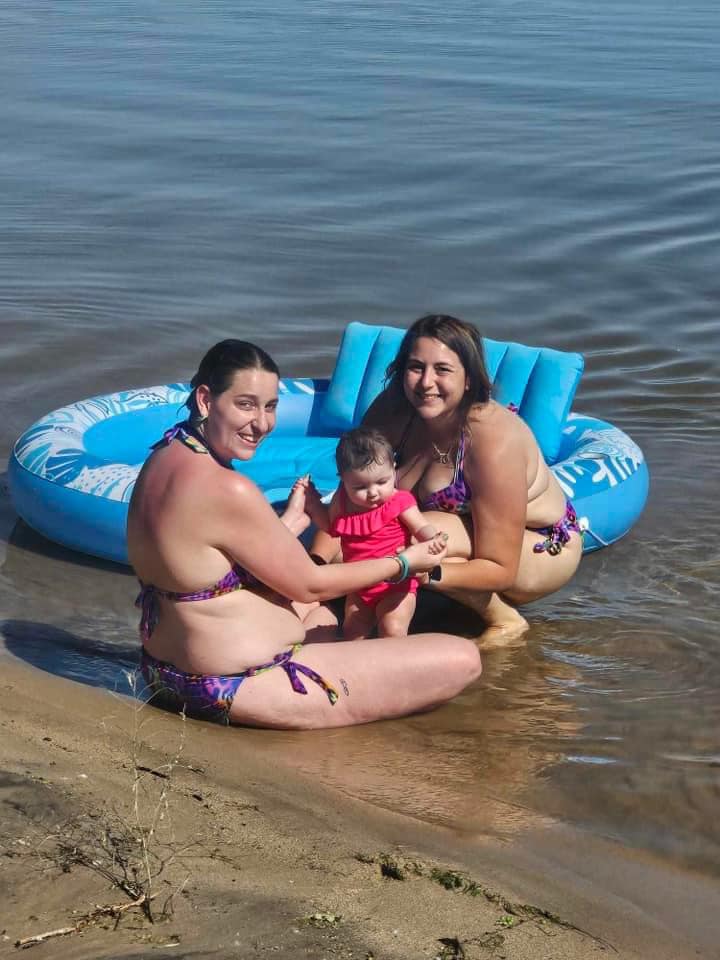
Right now Sky is almost one years old. She is like her mom (Hope) who was like a sponge when it comes to movement, language and Science. At ten months she is making decisions on:
(1) What clothes to wear (pointing or grabbing)
(2) Able to choose play activities (with actions, smiles or sign language),
(3) Choosing her food (with pointing and sign).
When we give her options, we offer two choices (no more than two)---both of which are acceptable by her parents and age appropriate.
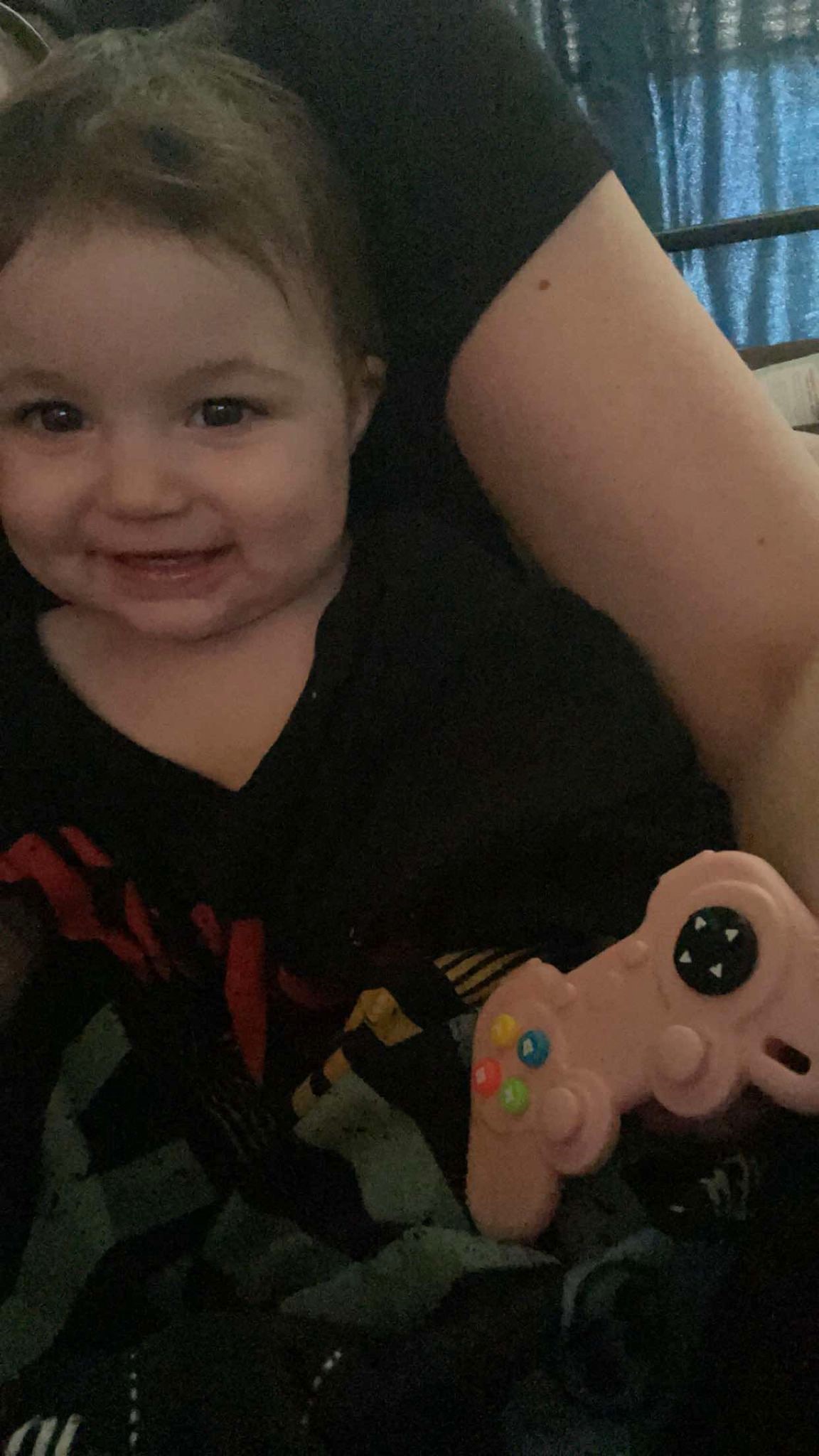
Today she decided to wear her dads favorite shirt. Hope was wearing one of his shirts too. However, being Sky - she wanted her toy game pad- (His shirt was about gaming and leveling up.) Her mom had started a tickle game with roaring and today she roared back- at 10 months old that was huge. She has a few signs down for food or play and loves being able to communicate...her first sign was MORE which she uses often for food and play.
That memory has me thinking that I need to to design a themed based program with a bank of plans in the form of Pinterest boards that can be customised to the childs interests and abilities. Themes help make our ideas relevent. The Amish teach only what is needed for everyday life until the age of five. I kind of like that expectation. So you wouldn't teach someone in Denver a unit on the ocean, and you wouldn't learn about mountains if you lived near a beach. I like the idea of relevance being considered. Hope was cooking and following recipies which made using and understanding fractions as a needed skill. She had them mastered by by first grade and was helping 4th graders learn them.
A Simple Trick to Helping Your One-Year-Old Communicate
GUEST AUTHOR
I used to have the patience of a saint
when it came to my son

I try to be patient
I knew I needed a new plan
Related Article: Why Your Baby Won’t Sleep
Bridging the communication gap
Help More Again Milk Food Please
Evaluation through Early Intervention
Here’s the deal
Figuring it out
But for now, I’m just trying to figure it out - o
Choose from the reading options below
based on your needs.
based on your needs.
First words and sounds- Plus Flashcard Play
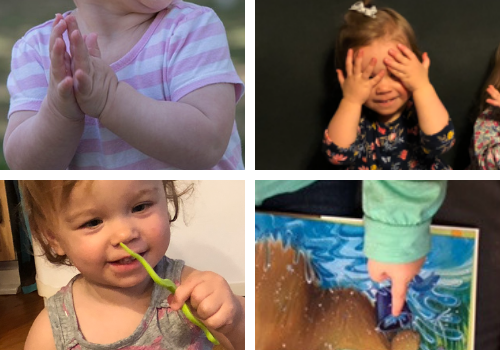
All About Child Speech and Language Milestones
Everything you need to know about your child's speech and language milestones, from their first words to verbal development and beyond.
From first words to full sentences, your child's language skills will advance significantly in the first few years of life. But it can be hard to know if they're hitting expected milestones, and you might find yourself wondering: When exactly will my toddler start talking?
"Every child develops on their own timeline, but the best way to help develop your baby's language skills is to simply talk to them," says Rahil Briggs, Psy.D., a child psychologist at The Children's Hospital at Montefiore in New York City. "The number-one way children learn to speak and boost their vocabulary is by listening to their parents at home."
1-Year-Old Language Development
Your little one is just beginning to communicate beyond crying. At this age, your kid should be able to do the following.
Say a handful of words
Your toddler still has a limited vocabulary at this point, but you can help it grow by reading out loud and talking to them every day, Dr. Briggs recommends. "At this age, the main concern is that baby's speech is 'mama' and 'dada' specific, meaning that when [they say] those two words, [they are] actually referring to Mom [or] Dad—not the cup or dog."
Imitate your voice
Even though your child isn't saying many words, they're babbling a lot and attempting to imitate the sounds of others. Parents "should be hearing vowel and consonant babbling by 8 or 9 months, and it continues as your baby starts to form words around 12 months," Dr. Briggs says.
Respond accordingly
Pediatricians are mostly concerned with your child's receptive language right now. Do they recognize your voice? Do they turn their head toward different sounds? Do they laugh when others laugh?
"Even at this age, your baby can communicate with intent and get what they want by pointing or looking toward an object. They should also be able to follow your eyes and look where you're looking," says Kenn Apel, Ph.D., president of the Council of Academic Programs in Communication Sciences and Disorders in Minneapolis and co-author of Beyond Baby Talk. These responsive actions are more important than how many words your child can say at this age.
Follow simple direction
In addition to responding, see if your child follows simple one-step directions and commands, such as raising their arms when you say "up," taking a sip of water when you tell them to, handing over a toy upon request, and stopping what they're doing when you say "no" (although they will probably try to do it again!).
Use hand and body gestures
During the first year, kids will use their hands and body movement to help them communicate with their limited vocabulary. And while gesturing is a natural part of communication for people of all ages, little kids in particular will use gesturing to help their cognitive and language skills build.
According to research, kids who use gesturing when talking can be a positive sign of language growth. A Month-By-Month Guide to Speech Development
Baby and Toddlers First Words
Early Learning, Learning Activities / By Holly

First Words For Babies and Toddlers
20 First-word flashcards for babies and toddlers are here for your early learner. Encouraging memorization, understanding, and object recognition with 20 free first words for kids. Visuals are used during early childhood development to encourage recognition. The more your child views an image or an object they begin to memorize it and understand its purpose. Visuals can help your child identify images within their environment. Your child will show you their understanding by pointing or trying to say what the image/object is. This is a fantastic first step into your little one’s early learning journey.
Free First Word Flashcards
Your free first-word printable flashcards come with 20 large images and words. This is a fun activity set to encourage your early learner’s speech and language skills.
Babies First Word Flashcards
Your child’s vocabulary is an important part of your child’s development. Babies first learn to babble then speak. Moments that we all wait patiently for. Or should I say “eagerly” for? Some children may speak later than others and that’s ok. All children grasp, learn and adapt differently. However, starting early encourages your child to practice and build their speech and language skills.
Toddlers First Words Flashcards
Toddlers are doing their very best to grasp and understand many words. Toddlers are to have 100 to 200 words in their vocabulary by 18 months. Toddlers with speech and language delays may not have as many. The pronunciation of sounds for children with speech delays is a huge factor that contributes to the diagnosis. However, toddlers will point to a form of communication, to make their wants known and needs met. You can also use flashcards to develop pointing skills. This will help your child memorize, understand and identify words. Grab your free first-word flashcards and introduce them to your child today!
Teaching First Words to Children
Teach first words to your child daily with your first-word flashcards. Babies and toddlers are always on the move. This gives you the opportunity to voice objects and images within their environment. The key is vocal repetition! Your little one will begin to demonstrate memorization and recognition of many words. You can follow the steps below to encourage first-word development for your child.
Step #1: Show and Tell
Show your child the flashcard and tell them what it is. Be exaggerative and enthusiastic, this is a great strategy that will keep your child attentive.
Step #2: Point
Point to the flashcard and repeat its description. Assist your child with return demonstration by encouraging your child to point to the flashcard.
Step #3: Object Recognition
You have shown your child the image, told him or her what it is, and also practiced pointing. Now it’s time for a little challenge to observe their understanding.
What is Object Recognition?
Object recognition is identifying an object or image. To single out a specific item!
Object Recognition Challenge
You have been teaching and your child has been learning. Now it’s time to challenge them and view their understanding. First, your want to eliminate distractions and use three of the flashcards to start. For example, you can use the ball, duck and baby. Next, place the three flashcards at eye level. Ask your child for the ball or just say the word ball. Wait patiently for a response. If your child brings you the requested flashcard he or she has identified an object amongst other objects/images. If not, no biggy! Start from the beginning and repeat steps 1 and 2 of the teaching strategies above.
First Word Activities
First-word flashcards are great learning essential to have. Learning first words with flashcards encourages memorization, understanding, and identification of images /objects. Here are some activities you can implement with your first-word flashcards.
Read
To get your child familiar with new words and images/objects, you can read the flashcards daily. You can also include your new flashcards into your child’s daily schedule. For example, you can use the flashcards as a book before bed.
First Word Games
Children love games and become actively attentive, especially when it is fun. He or she is tuned in and ready to actively participate. You can create many developmental games with flashcards. You can create a scavenger hunt and have your child find the flashcard you are voicing. I spy is another fun way to encourage pointing and identification. For example, place a few of the flashcards within your child’s view. Now, you will ask your child “where is the ball” or “do you see the ball”? Wait patiently for a response. You can also have your child match the flashcard to the actual objects/toys. Super fun!!!
Benefits of First Word Flashcards
Children learn and grasp information in many different ways. Visuals are great learning tools for babies and toddlers. They enjoy seeing images and relating them to things they’re familiar with. Flashcards encourage your child to memorize objects/images, understand its purpose and identify more things !!!
Materials Needed
Printer
Laminating Machine
Laminating Sheets
Scissors
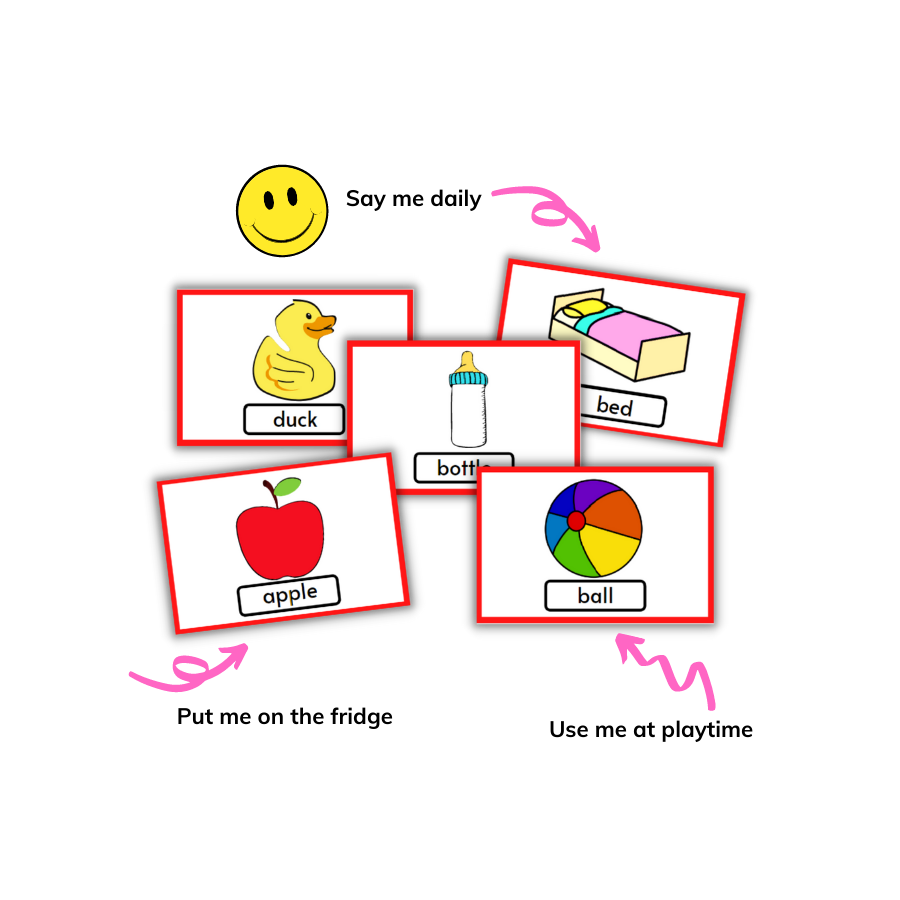
Baby and Toddlers First Words
Learning Flashcards for Speech and Language Development. Grab your 20 free first-word flashcards!
First Word Flashcards
You have 20 flashcards to encourage speech and language development for your little one. Children become so excited seeing large images that are frequently used within their environment. The more you review the flashcards with your child, the more he or she will remember it, understand its purpose and participate independently. However, repetition is highly recommended to obtain memorization and comprehension.
First Words Learing Binder
First Words Learning Binder for babies and toddlers is finally here. The first words binder offers early learners a fun hands-on experience with a ton of repetition!
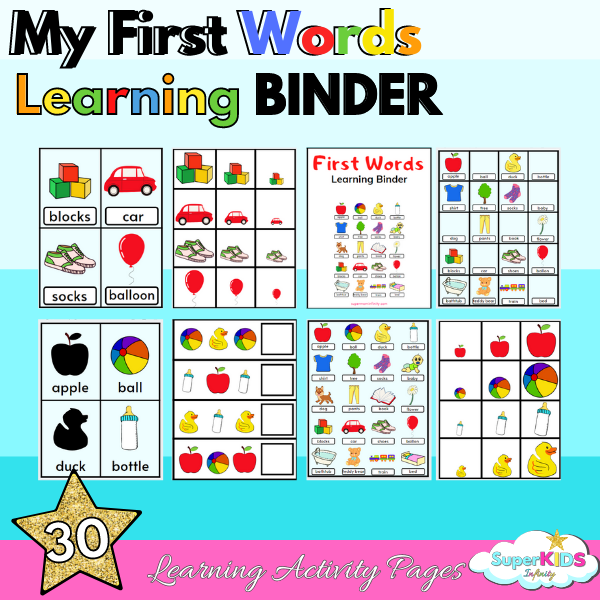
Baby’s first words learning binder. First words learning activity book for toddlers. Learn first words for babies and Toddlers. Hands-on learning activities are designed to encourage sound and word recognition. Follow along in the learning binder with your 20 free first-word flashcards. The First Word Learning Binder includes the exact images from your free flashcard set. This technique offers the additional repetition needed for early learning, special needs children, and children with Autism to grasp and understand the concept.
Free Printable First-Word Flashcards
Our free, downloadable and printable first-word flashcards are fantastic for babies and toddlers who are just starting to talk. Using flashcards is a fun activity to share with your young child and can help them to pick up new words. You can start to use vocabulary flashcards as young as 6 months old.
The flashcards are thoughtfully designed with bright and stimulating images to capture your child’s attention. They will enjoy looking at them as much as practicing naming them.
Click Here To Download First Word Flashcards
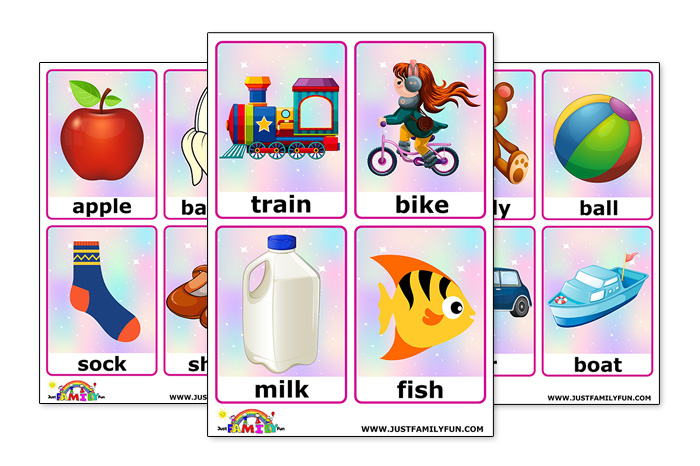
Our First-Word Flashcards Include
Everyday objects
We have chosen a range of items that are familiar to your child such as a teddy, banana and book. Learning this key vocabulary will help your child to communicate and express themselves.
Animals and Nature
A subject that is guaranteed to capture a child’s interest. Our cute illustrations of cat, dog, cow and more will have your child excited to practice their flashcards with you.
Vehicles
Another topic that many children love. We cover a range of vehicles such as cars, boats, and trains. Key vocabulary that will help them to talk about the world around them and also identify some of their favorite toys.
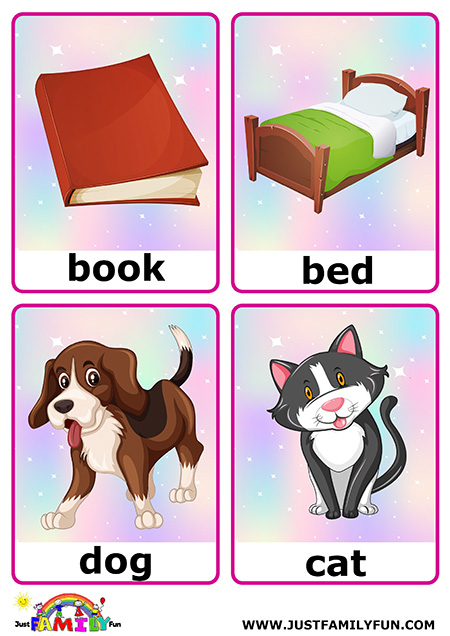
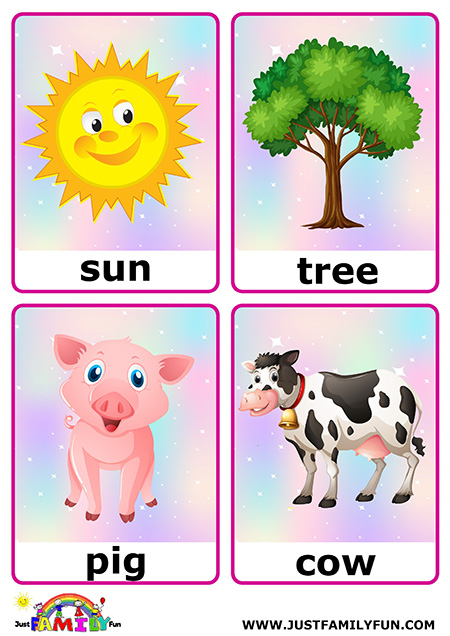
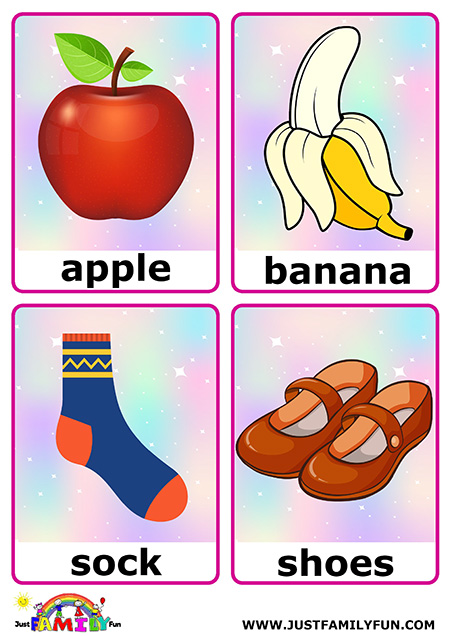
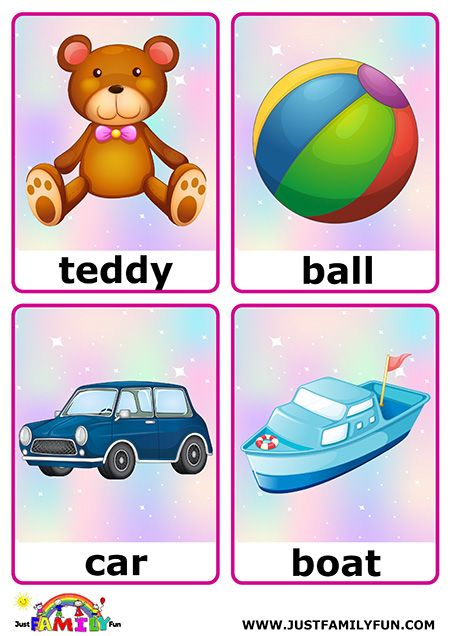
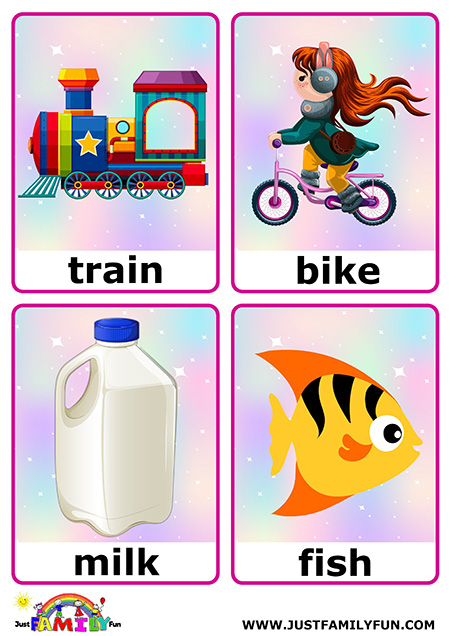
How To Use Our Flashcards
Flashcards can be used in lots of fun and exciting ways.
Show and Tell – Show the flashcard to your baby and say its name clearly. Repeat a few times. Keep it fun and use a sing-song voice, animal noises and vehicle sound effects. Choose only a few cards at a time and keep the session short.
Name the Card– Hold up the flashcard and ask your child to name the image. If they get it right add it to a pile on your right, wrong answers on the left. As you repeat the game, more and more cards will end up in the right pile. Remember, lots of praise and high fives for correct answers.
Find the Flashcard – A great activity to encourage movement. Spread out the flashcards an appropriate distance away for your child’s ability. This could be a short distance or the other side of the room. You could also place them on a higher surface, like the sofa, if you want to encourage pulling up to standing. Name a flashcard and ask your child to find it. They must make their way to the card by crawling, walking or pulling up and select the right one to bring back. They can be rewarded with lots of claps and cuddles when they succeed.
Match to the object – It is important to help your child understand that the picture represents a real-life object. If you have any small toys that match the flashcards, use them too. Have your child match the objects to the cards or show them at the same time. For older children, you could use flashcards as a scavenger hunt. Hide the toys and show your child the flashcards. Can they find the right toy without you name it?
Top Tip – Make your flashcards tough enough to withstand a toddler by laminating them, printing on card, or gluing onto the card. This will toughen them up and make sure they last for lots of fun flashcard sessions.
If you love our free, downloadable, and printable First-Word Flashcards we have other activities that are great for preschool children. Try our Free Printable Kids Colour Puzzle Sheets to start exploring colors with your little one. Or, if they love animals, check out our Free Printable Picture Farm Scavenger Hunt to discover fun new ways to make a scavenger hunt accessible for younger children.
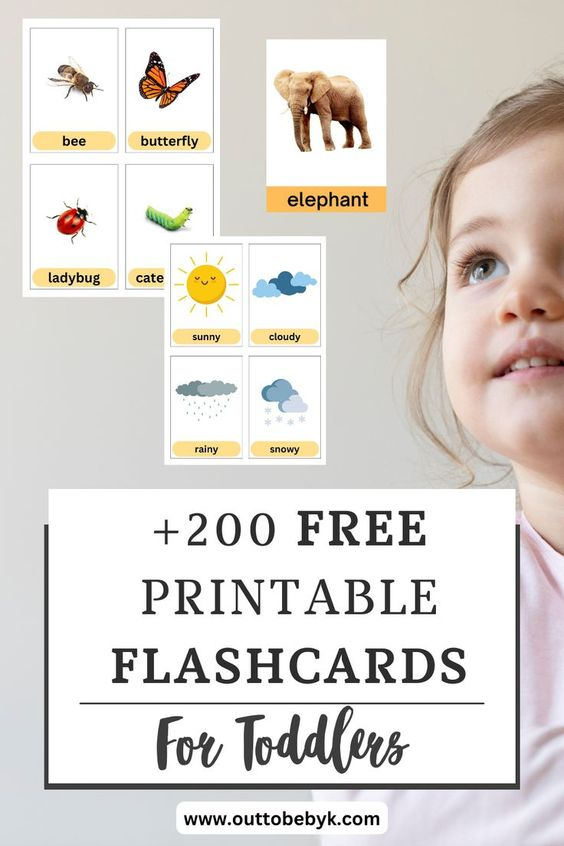
Teaching sign language to babies to reduce frustration
Sign Language or “Baby Signs”
Once your little one is starting to imitate you a bit, introduce some simple sign language into the mix. You can teach this by modeling signs while saying the word, then guiding his hands to form the sign.
Try to do this during meaningful times. For instance, if he getting milk, then show him the sign for milk, have him make the sign, and then hand over the sippy cup. You can look up videos of how to form individual words in sign language here – just type in the word you are looking for.
Some useful first words to target through sign language:
More
All Done (in the ASL video dictionary, just search for “done”)
Milk
Eat
Drink
Book
Using baby sign language
Introducing a few baby signs to older infants and young toddlers helps boost language development. Children learn best when concepts combine mind and body.
If you do use baby sign language, be intentional about saying the word with the sign. This helps build the language connection for your child.
The two products I just bought for Sky are From Amazon. Hope was able to be friends with kids that had to communicate with sign language. And it is important for Hope to teach Sky them in order for her to have that same opportunity.
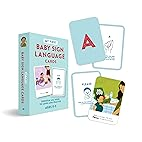
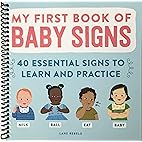
It was crucial that they provide photos of what they are signing. This was the only set I could find that did that. They are also huge 4 x 6 size which is really helpful for babies.
I strongly recommend that you stick with words and themes related to your child's life and Interest.
Looking for another activity to incorporate sign language for pre-talkers? Check out this article on coloring or this one about pasta threading.
Top 20 Baby Signs – Baby Sign Language
Baby sign language is an awesome tool to use before baby can say words. Follow our step-by-step guide, which includes a visual cheat sheet, to teach it to your baby.

How many times have you wished that your crying baby could just tell you what was wrong? Baby sign language is a great tool to establish communication between you and your baby before they start talking, and we’ve got the low-down, including:
Baby Sign Language Basics
It’s a version of typical American Sign Language (“ASL”) that’s simplified for baby’s hands and motor skills. It helps parents and caregivers communicate with babies who are not yet verbal or who are just starting to talk.
Get my FREE Baby Sign Language Cheat Sheet!
A free, printable chart.
The top 20 baby signs.
A simple one-page cheat sheet.
Get Your BSL Cheat Sheet, Click Here
Benefits for Baby
1. Improves self-esteem
Some experts believe that this type of communication improves baby’s self-esteem, because it helps them feel seen and heard and shows that their parents are attentive to their needs. It’s also a confidence booster, as they’re gaining and mastering a new skill.
2. Improves mood
Because temper tantrums typically stem from the frustration of not being able to communicate their needs, this type of communication can potentially reduce the frequency and intensity of temper tantrums.
It helps you keep your calm, too, because you’re not trying to figure out what’s bothering baby and growing increasingly frustrated trying to interpret their cries.
3. May help baby talk sooner
While some experts believe that this reinforcement and repetition can help babies talk sooner, the research is mixed. One thing is certain, though: It doesn’t delay verbal skills. (source) Can’t hurt to try, right?!
Get free updates on baby’s first year!
When to Start Teaching It
Your baby’s eyesight and motor skills have to be developed enough for them to observe and participate.
Most babies are developmentally ready for parents to begin signing around four months, though baby won’t likely be able to sign back until they’re seven to nine months old.
How to Teach It to Your Child
1. Start with the familiar
What are the activities and objects that baby does or sees on a regular basis? Start there. Start by introducing signs baby will frequently use, such as “more,” “milk,” “mom,” or “dad,” so you’ll have ample opportunities to use those signs.
2. Repeat, repeat, repeat
Repetition is key. Repeat those first few signs often—even if it doesn’t seem like baby is picking up on it. You might be tempted to try a different sign if baby isn’t picking up on the first signs you introduced, but it’s important to stick to the basics. Once baby has mastered the initial 4-5 signs, then you can expand their vocabulary and add another 4-5 into the rotation.
3. Keep your cool
Don’t expect your child to master this process over night—it’s a slow process. Keep it fun and encourage baby. Praise baby when they understand and/or repeat your actions. Keep a smile on your face, and make sure that you’re holding your hands where baby can see them.
Baby Sign Language Flash Cards
These words are very relevant to baby’s routine, so you’ll naturally use them often. Remember: Repetition is key.
More
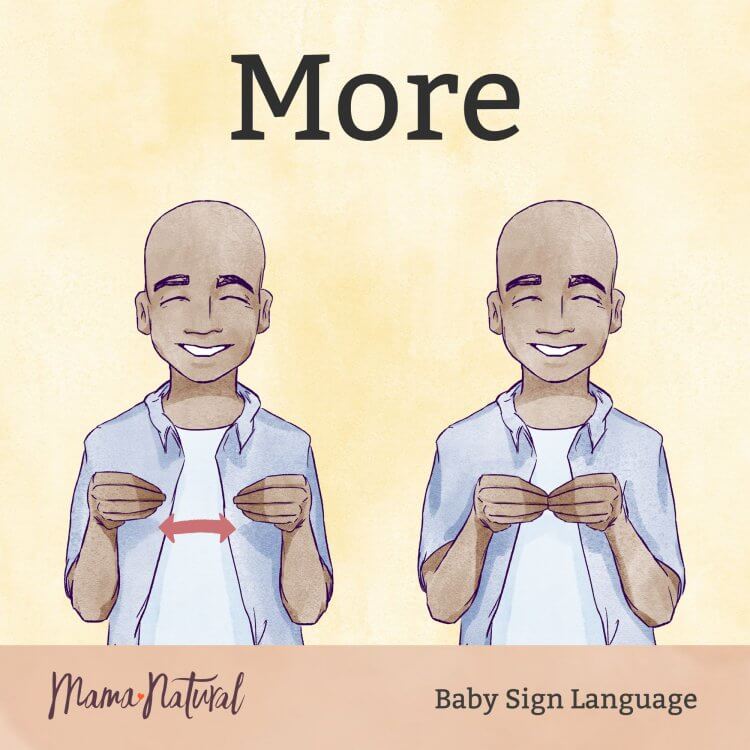
Keep your fingers straight and press your fingers to your thumbs. Then open and close your hands repeatedly with your thumbs turned towards your body. It’s kind of like making an alligator mouth, only turned on its side.
Eat
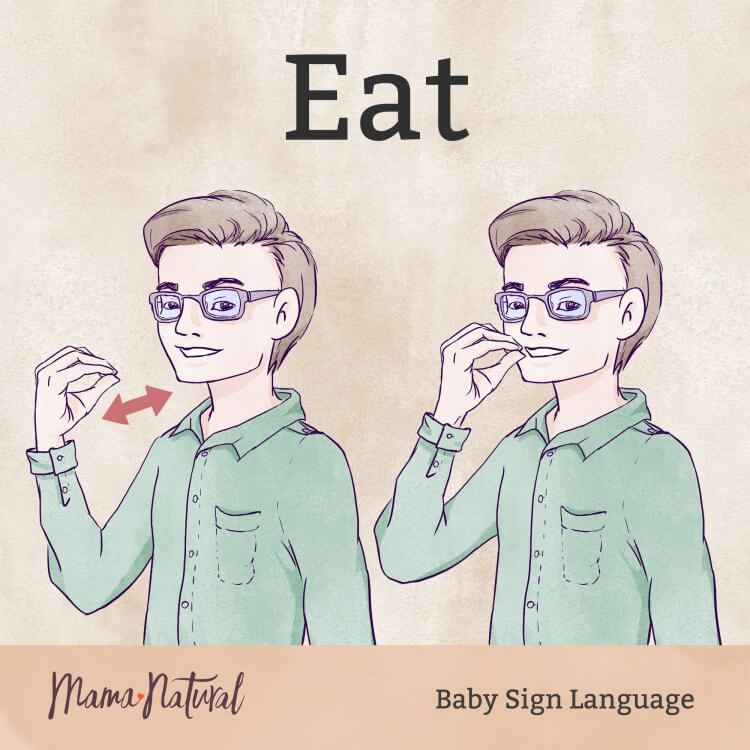
With the same hand shape used in the sign for “more,” turn your fingers to face the sky and tap them repeatedly against your lips.
Hungry
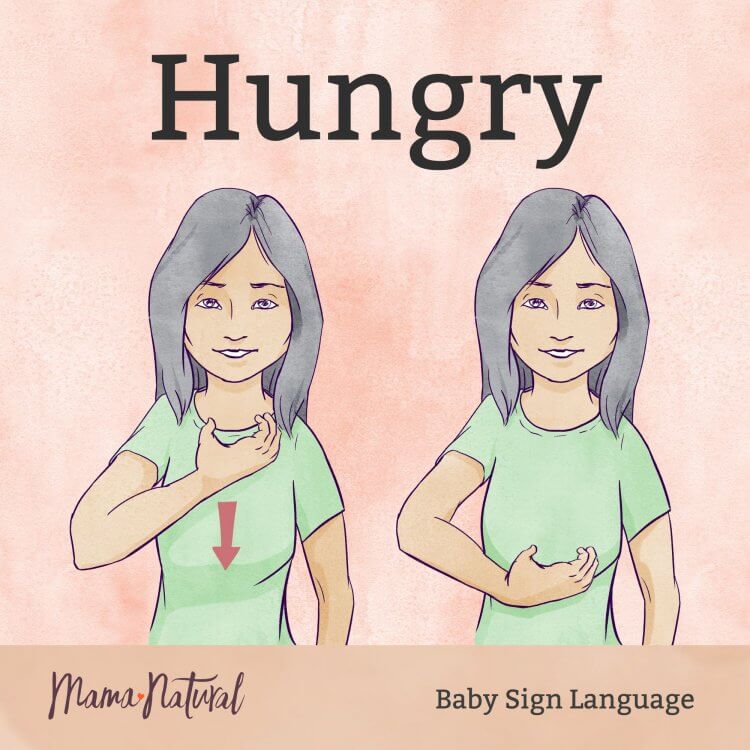
Press your palm flat against your chest, under your chin, and slide it down to your belly. Think of your hand following the path that food makes.
Milk
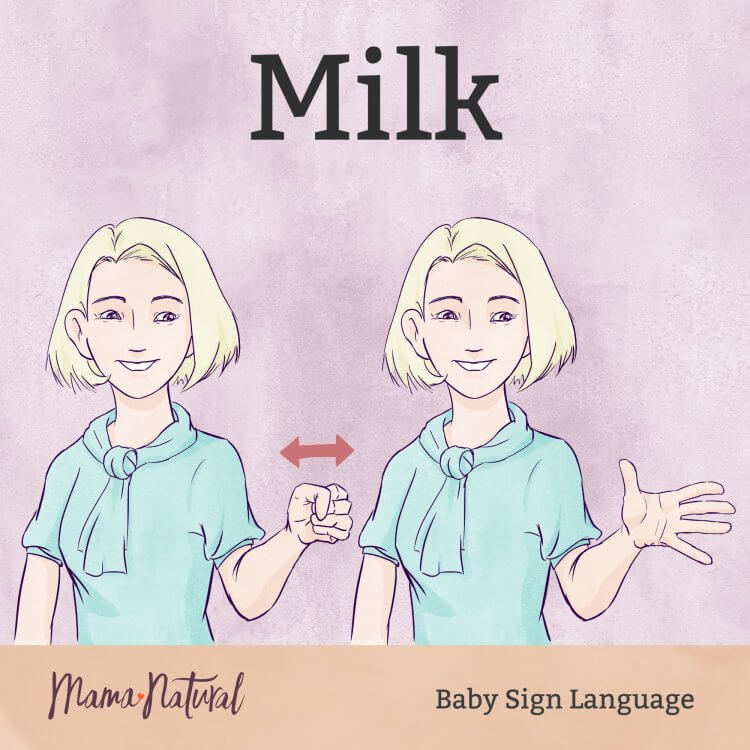
If you’ve ever milked a cow, you’ll recognize the sign for “milk.” Think of milking an udder. Make a fist with your hand, thumb facing you and fingers tucked behind your thumb, and open and close it as if milking a cow.
Water
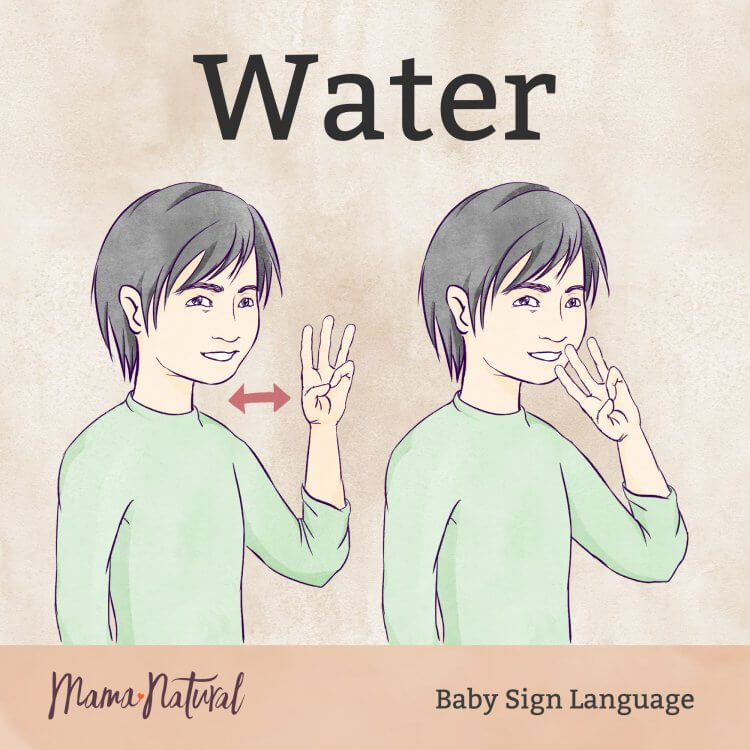
Think “W” for water. The sign for water is done by making a “W” with your three middle fingers, pressing your pinkie and thumb together out of sight, and tapping your hand against your chin.
Please
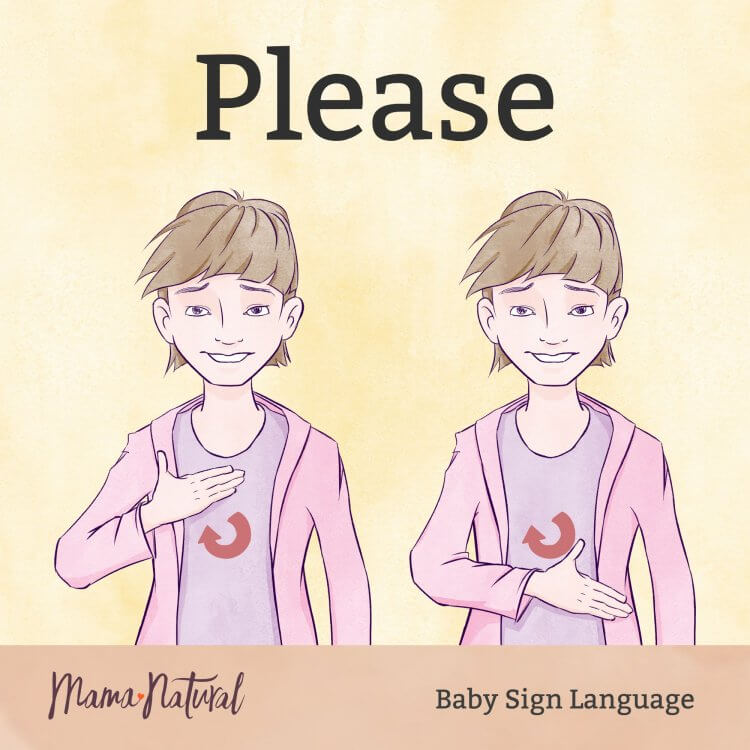
When your baby has learned the signs for “eat,” “milk,” and “water,” you can move to asking them to say “please” before fulfilling their request. Simply press the palm of one hand flat against your chest and move it in a circular motion.
Thank You
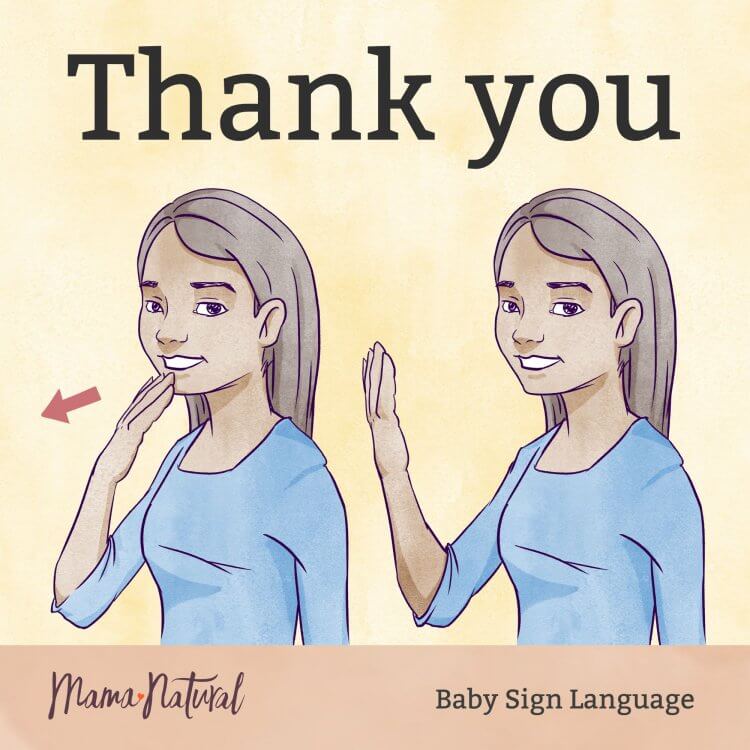
After they’ve said “please,” reward them with your thanks. Tap your fingers to your chin and then make the same motions as blowing a kiss.
All Done
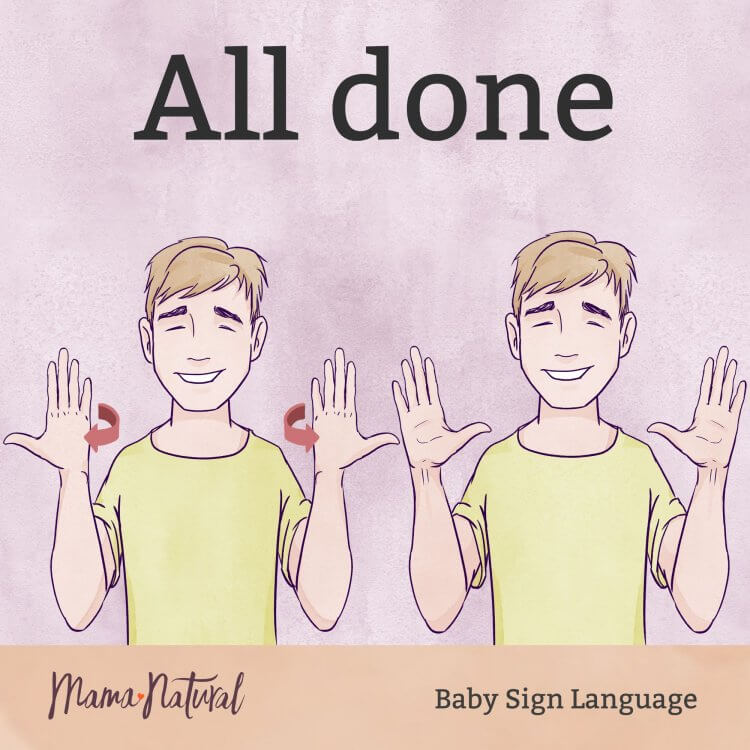
Hold both hands up at chest level, fingers extended and palms facing you. Then flip them out, so the palms face your baby.
Change
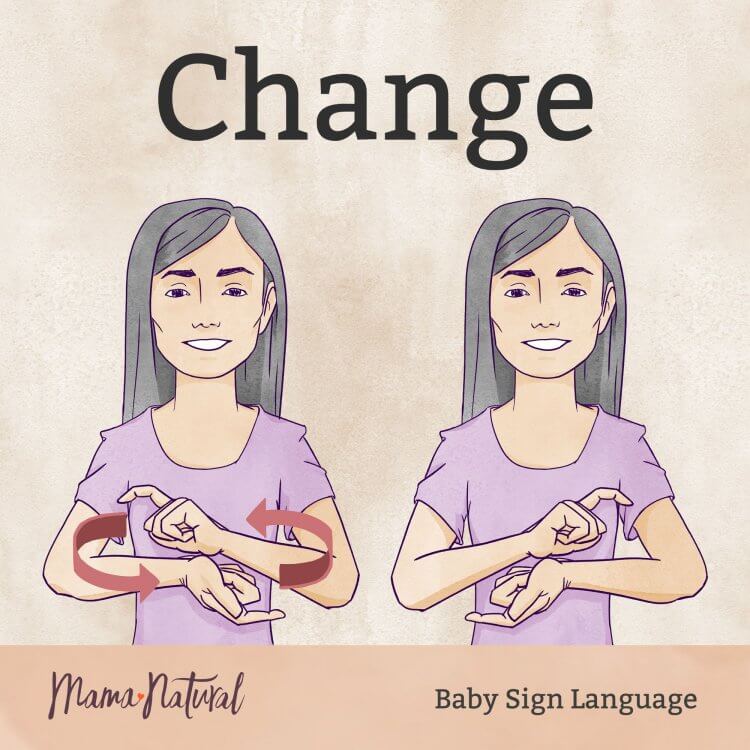
This is a more complicated sign. Curl the fingers of both hands into a ball, leaving your index finger out. Tuck it into a hook shape, then cross your hands at the wrists and switch them, top to bottom, several times.
Potty
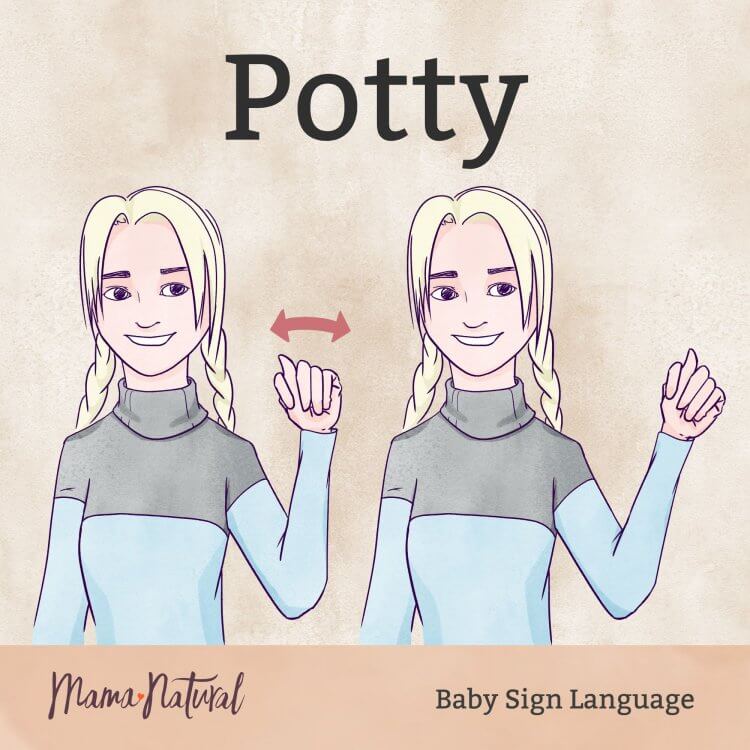
Ever played, “I’ve got your nose,” with your baby? The same hand shape, thumb tucked between your first two fingers, is used to sign potty. Form the shape with your hand and then shake it back and forth several times like you’re ringing a bell.
Get a free, printable one-pager with all 20 of these signs!
A free, printable chart.
The top 20 baby signs.
A simple one-page cheat sheet.
Get Your BSL Cheat Sheet, Click Here
Bath

Form both hands into fists, then imagine an old washboard, or scrubbing baby’s back. Rub your hands vertically up and down your torso.
Play

Hang ten, dude. There’s a reason that hand shape, thumbs and pinkies extended, other fingers tucked in, became the symbol of California surfer dudes. When you make the shape with both hands and twist them back and forth at the wrists, it means “play.”
Sleep
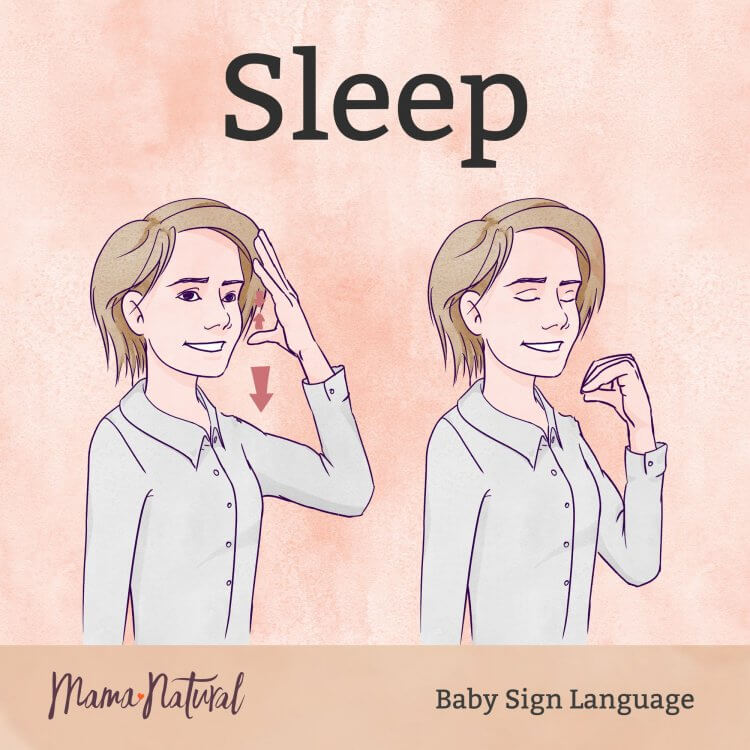
Start with your fingers open, palm facing you, at your forehead. Then draw them down your face, closing them as you go. Think of eyes closing in sleep.
Book
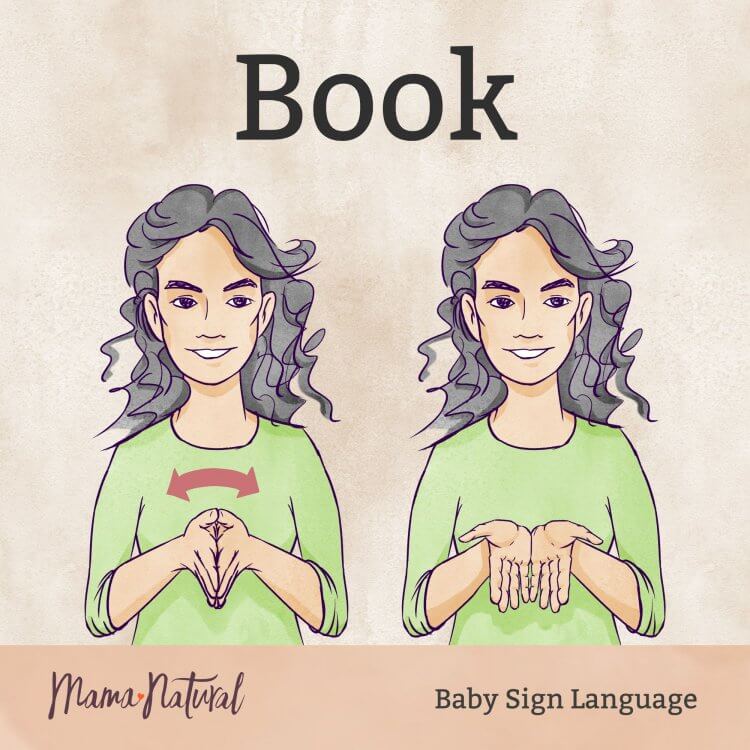
Press your palms together, fingers flat, and then make the motion of opening them. Keep the bottom edge of your palms touching just like a book’s spine.
Daddy
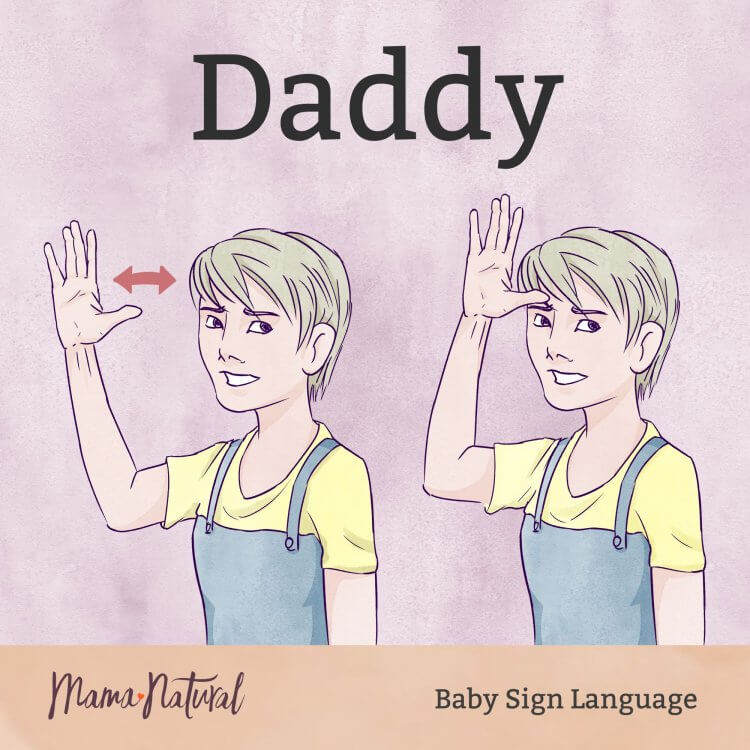
To make the sign for daddy hold your hand up with your fingers spread. Palm facing towards the side, tap your thumb to your forehead.
Mommy
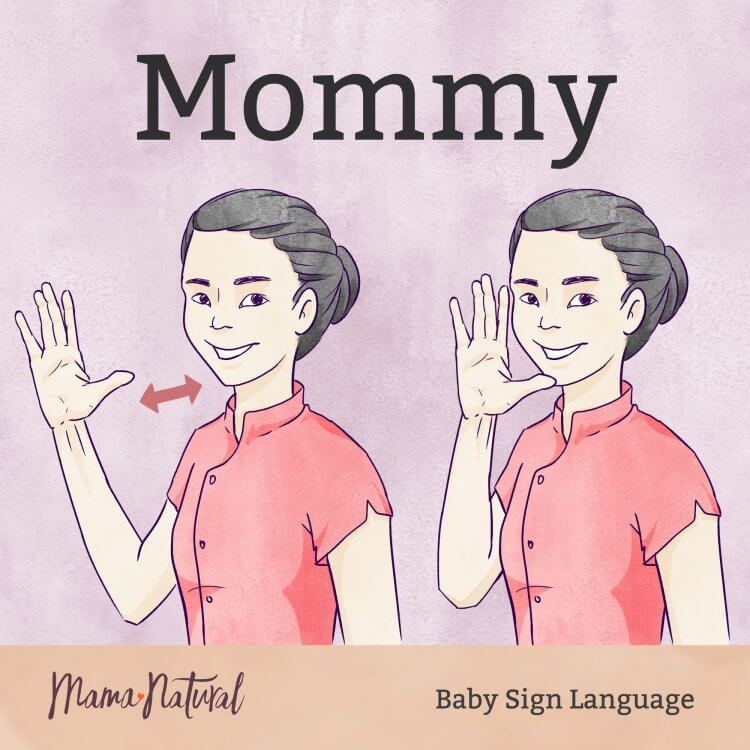
The sign for “mommy” is the same as the sign for “daddy”—the only difference is that you tap your thumb to your chin.
Dog
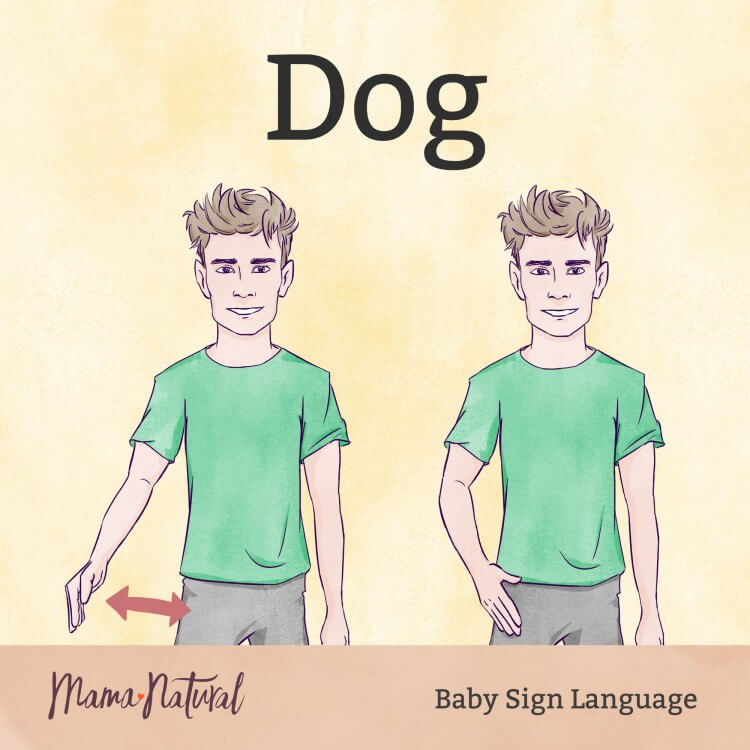
The sign for dog is made by putting one hand down by your leg and snapping your fingers, just like you’re calling your dog inside. Snap with your thumb and middle finger.
Cat
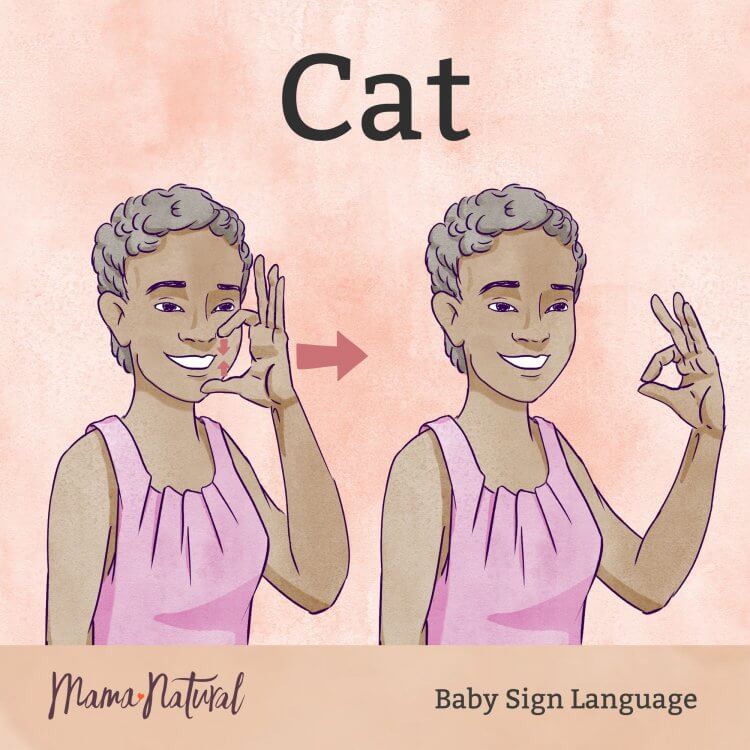
The sign for cat mimics the whiskers on your cat’s face. Place one hand by your mouth where a cat’s whiskers grow. Think of drawing your hand outwards, like you’re running your fingers along the whiskers, while simultaneously pinching your index finger and thumb together.
I Love You
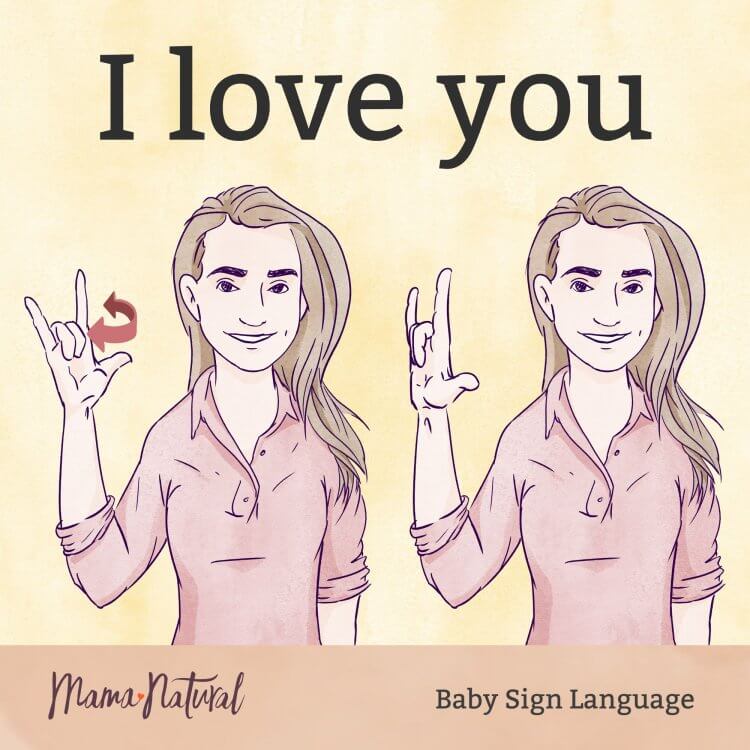
Think of one of the most natural expressions of love—a hug. Cross your arms in front of your chest, hands balled up as if you’re hugging yourself.
Yes
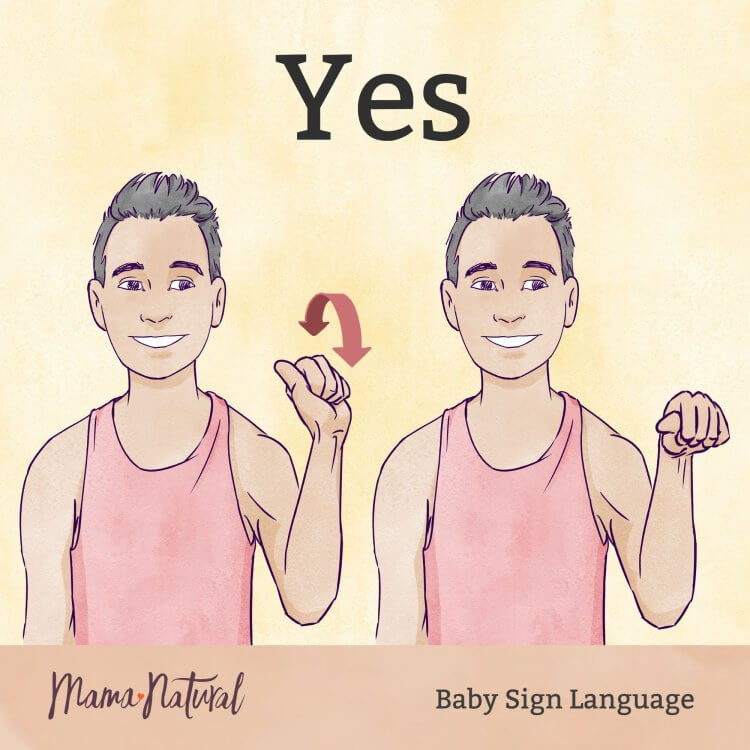
How do we often indicate “yes,” even when speaking? By nodding our head up and down. The sign for “yes,” makes the same motion only with your hand. Form one hand into a ball and hold it up near your shoulder, then wag it up and down as if you were nodding your head “yes.”
Help
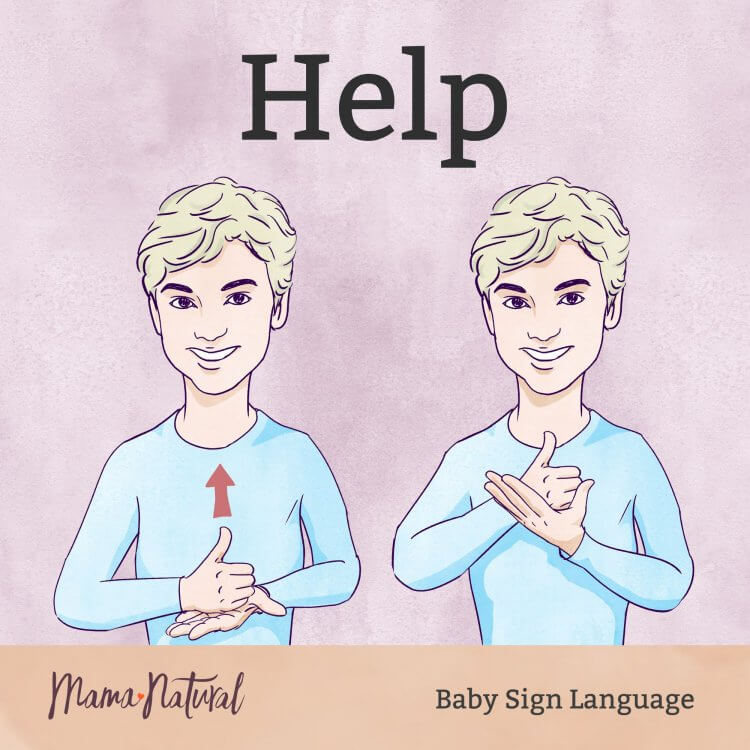
How often does your baby reach out their arms and ask to be lifted up? The sign for “help” is similar. Place your dominant hand, curled into a thumbs up, on top of the flat palm of your non-dominant hand. Have them down by your waist, then move them both up your body like the bottom hand is lifting the top hand.
Baby Sign Language Chart
Okay, there you have it, the top 20 baby sign language signs! To help you and baby master them, I’ve created a free, printable one page guide for you!
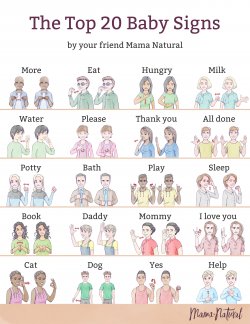
Get a high-res, printable version of this chart!
A free, printable cheat sheet.
The top 20 baby signs.
A clean, simple one-pager.
Get Your BSL Cheat Sheet, Click Here
And Don’t Forget…
If you’re getting discouraged, take a deep breath and keep at it. Sign language takes patience and lots of repetition. Even if it seems like baby isn’t grasping the concept at first, you might be surprised when they sign “milk” out of the blue! Your hard work will eventually pay off.
Posts in Activity Ideas
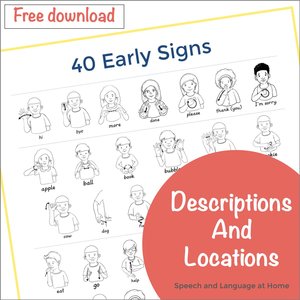
Parent education on teaching sign language to toddlers and early communicators to reduce frustrations. Includes FREE handout of 40 Early Signs.
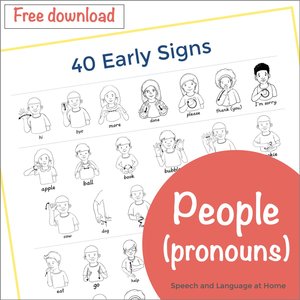
Reduce toddler frustration by teaching sign language in daily routines: Part 4 People
Parent education on teaching sign language to toddlers and early communicators to reduce frustrations. Includes FREE handout of 40 Early Signs.
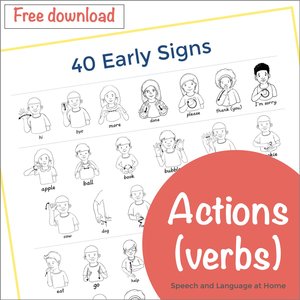
Reduce toddler frustration by teaching sign language in daily routines: Part 3 Actions
Parent education on teaching sign language to toddlers and early communicators to reduce frustrations. Includes FREE handout of 40 Early Signs.
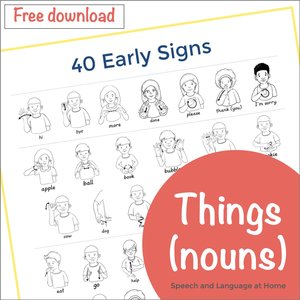
Reduce Toddler Frustration by Teaching Sign Language. Part 2: Things
Parent education on teaching sign language to toddlers and early communicators to reduce frustrations. Includes FREE handout of 40 Early Signs.
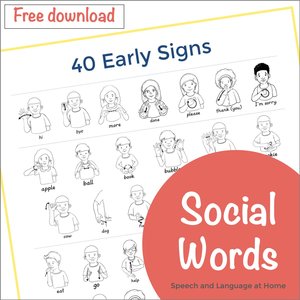
Reduce Toddler Frustration by Teaching Sign Language. Part 1: Social Words
Parent education on teaching sign language to toddlers and early communicators to reduce frustrations. Includes FREE handout of 40 Early Signs.
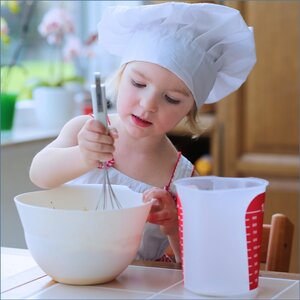
7 Easy Ideas Families Can do to Help Develop Language Skills at Home
7 Easy Ideas Families Can Help Develop Language Skills at Home for Speech Teletherapy.
Parents are helping develop their child’s language skills at home, they may just not realize it.
Speech therapists can empower families by sharing ways those daily activities are improving communication skills.
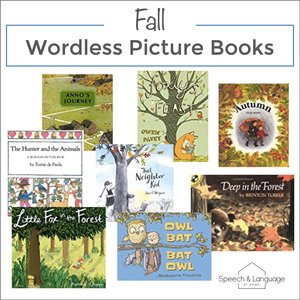
8 Wordless Picture Books to Read this Fall
Grab 8 wordless picture books to read this fall…
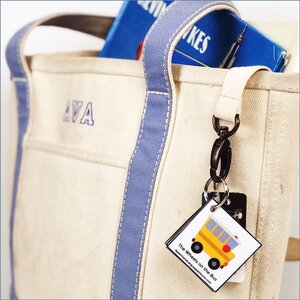
How to Easily Improve Your Child's Language Using Songs and Music
How to Easily Improve Your Child's Language Using Songs and Music. Today let’s talk about why music is a powerful tool in early intervention and how to use songs in speech therapy (and at home!) to improve your child's language.
Posts in Activity Ideas
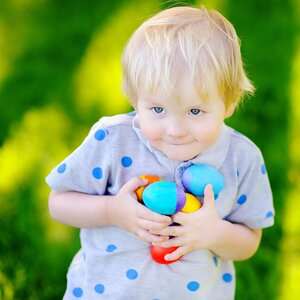
Four Fun Spring Activities for Kids
Celebrate this season with fun spring activities for kids. Bonus: theme-based teaching will help your child develop communication skills.
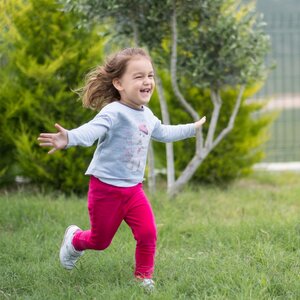
How to Promote Speech and Language Development With Easy Movement Activities
Did you know that movement activities may help to improve your child's speech and language development? Here are three to try today!
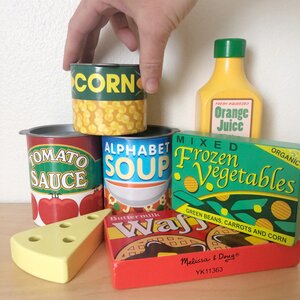
Make Basic Concepts Fun With These Simple Activities
Let’s chat about basic concepts: what they are, why they’re important, and how to teach them using fun but simple activities.
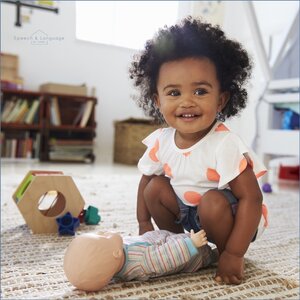
4 of the Best Toys of All Time for Child Development
Learn to lean on the classic toys –– the best toys that have stood the test of time.
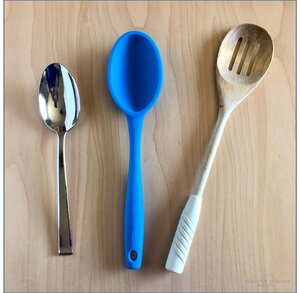
How to Boost Early Communication With Common Items
Nobody needs fancy, expensive toys or tools to effectively prevent and treat speech and language disorders. Get ideas…
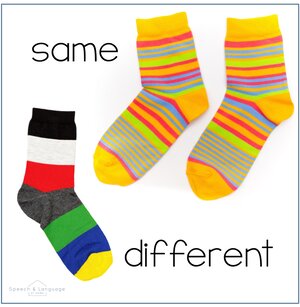
How to Teach Language to Your Preschooler at Home
There’s a buzzword in the speech therapy world: naturalistic. Research tells us that intervention, and especially intervention for preschoolers, should focus on natural settings
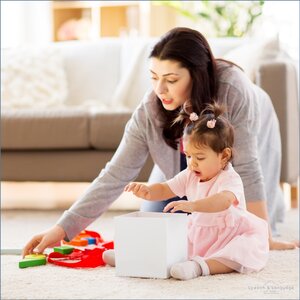
How to Support Your Late Talker's Behavior
Does your late talker have behavior problems? Here are four visual supports to target behaviors associated with communication delays.
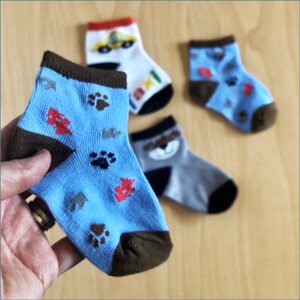
Speech Therapy Activities During Daily Routines That Increase Family Engagement
Working with students over teletherapy is a great opportunity to educate families on turning daily routines into intentional activities to improve language skills.
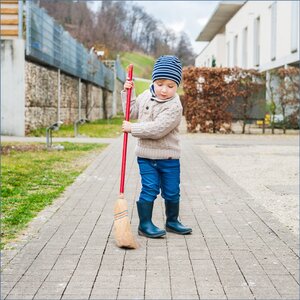
Ideas for Increasing Language by Having Kids Help out at Home
Helping out at home is not just about getting work done… kids are learning too. Here are some examples of incorporating language into learning to do chores.
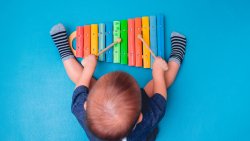


Early Language Development through Play
Sensory Play
I can make a spectacular argument that sensory play supports every learning domain.
Actually, that’s probably why I started this entire website.
Anyway, sensory play is the perfect opportunity to introduce interesting new vocabulary. Take time to describe what your child is feeling, smelling, seeing, hearing, and even tasting.
Here are some fantastic sensory play ideas:
Singing
Singing is a great way to promote language development. Introduce music in whatever ways feel comfortable for you. If that means only singing to the radio, that’s fine. You can also turn normal routines into songs or sing favorite lullabies.
Trust me, you do not always need to play children’s songs. Your toddler will get more from the experience if they see you engaged and enjoying it.
Fingerplays
Fingerplays and action songs are a great way to promote language development.
Itsy Bitsy Spider
I’m Bringing Home a Baby Bumblebee
5 Little Monkeys
Naming familiar objects
For younger toddlers, simply labeling familiar objects is a great way to build vocabulary. Adding descriptions is a bonus.
“Let’s put on your yellow flower shirt.”
“Here are the crackers. You loved these round crackers.”
Making Connections
Drawing your child’s attention to what they are experiencing and language is so powerful. This builds both language and cognitive skills.
“Your toes feel cold. They were cold when you got out of the bath too.”
“That was a big yawn. I yawn when I’m tired. Are you sleepy?”
Asking open-ended questions
Remember when I said “quizzing” is not a developmentally appropriate way to support language? I did that.
However, open-ended questions are golden for language development. Even for children who are learning words, open-ended questions help boost language. Instead of you repeating the same question, you can start introducing new language?
Quizzing Questions
What color is that?
What animal is that?
What is this called?
Open-ended Questions
“The cat is gone. Where do you think she’s hiding?”
“We cleaned up. What should we do next?”
Get my free list of open-ended questions. Memorize a handful of these and get in the habit of working them into playtime.
Serve + return conversations
Serve-and-return is taking turns communicating with your child. This could as simple as exchanging smiles.
For children who aren’t verbal yet, serve-and-return is responding to their coos, cries, and squeals.
Focusing on the rhythm of a serve-and-return conversation helps young toddlers learn how to communicate. Check out this video to learn more.
Playing with Letter Sounds + Rhymes
Playing with letter sounds and rhymes helps a toddler’s brain build language connections. Many children’s songs and books already emphasize alliteration.
You can draw your child’s attention to these sounds in everyday conversations.
“There is a bluebird. Oh it’s a buh-loo buh-ird.”
“These flowers are fabulous. Fabulous flowers.”
You can also use alliteration and rhymes to create treasure baskets or a themed reading time. Toddlers are not developmentally ready to identify sounds on their own, but they can still begin to build connections.
Treasure Basket Ideas:
Letter D-themed:
Doughnut toy
Doily
Toy dog
Letter D magnet
Dumptruck
Letter S-themed:
Slinky
Toy strawberry
Toy snake
Spoon
Sponge
Books with Rhyme + Alliteration
If You Give a Moose a Muffin
Llama Llama Red Pajama
Chicka Chicka Boom Boom
Belly Button Book
Narrating Your Actions
Narrating your actions also promotes language development. This means describing what you’re doing as you’re doing it.
For example, “I’m putting on my shoes. I’m tying my laces. After this, I’m going to find my coat.”
You can also narrate your child’s actions. For example, “You’re putting the block on top of the other block. The tower is getting taller.”
Face-to-Face Interactions
Face-to-face interactions are how children learn to shape their mouths to form sounds and how to communicate nonverbally. Engage in face-to-face interactions with your child as often as possible. This means making eye contact, using facial expressions, and vocalizing.
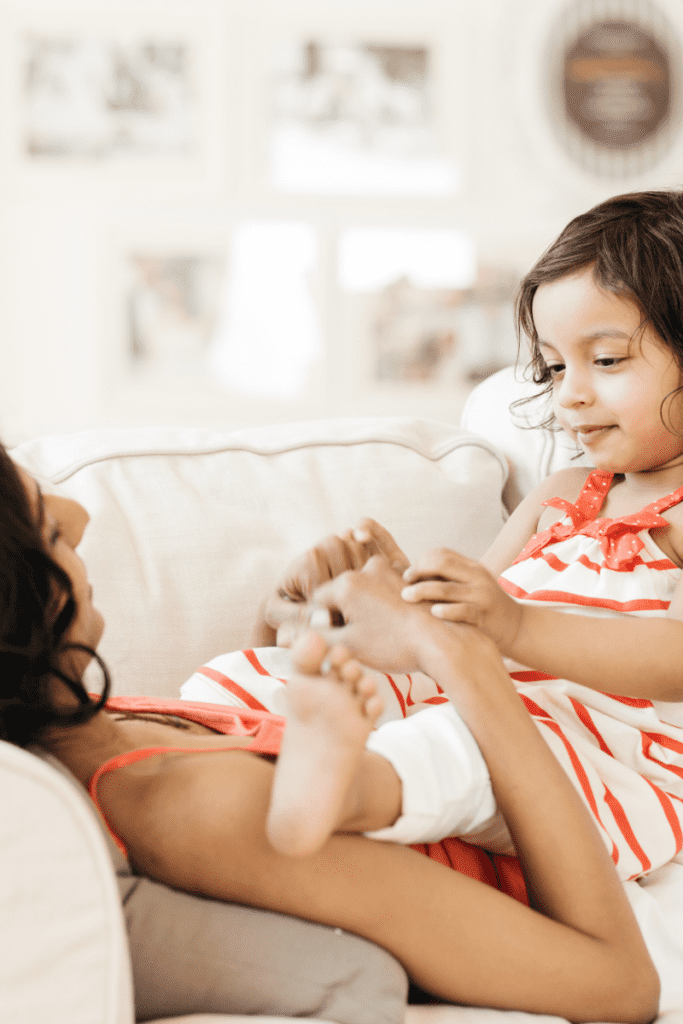
Treasure Baskets
Treasure baskets are an easy way to introduce loose parts to younger toddlers. As toddlers manipulate and investigate the treasure items, you can talk about each item. This is a great chance to share new vocabulary and have conversations.
Treasure basket ideas:
Metallic objects
Circles + round objects
Nature objects
Magnetic objects
Monochrome (all the objects are the same color)
Book Baskets
This is an alternative version of a treasure basket with a the theme is a specific book.
The Pout Pout Fish
Toy fish
Seashells
Mirror (for practicing pouting face)
Empty peanut butter jar
Chicka Chicka Boom Boom
ABC magnets
Goodnight Moon
Toy bears
Mittens
Bowl
Comb
Brush
Toy mouse
Nursery Rhyme Themes:
Lamb toy (Mary Had a Little Lamb)
Spider toy + rainstick (Itsy Bitsy Spider)
Watch + toy mouse (Hickory Dickory Dock)
From day one, your baby is listening to you intently to eventually communicate with you. Those listening skills will then turn into eye contact, cries, smiling, giggling, babbling, and more. In fact, your baby’s first communication begins with crying.
Have you ever noticed your baby cries differently for different needs? Different cries are baby’s way of communicating with you!
But how do a baby’s cries develop into speech? By the age of one, your baby will develop both nonverbal and verbal language skills to communicate. To help your baby develop essential language milestones, here are 21 kids’ speech activities to foster listening skills and speech development for your baby!
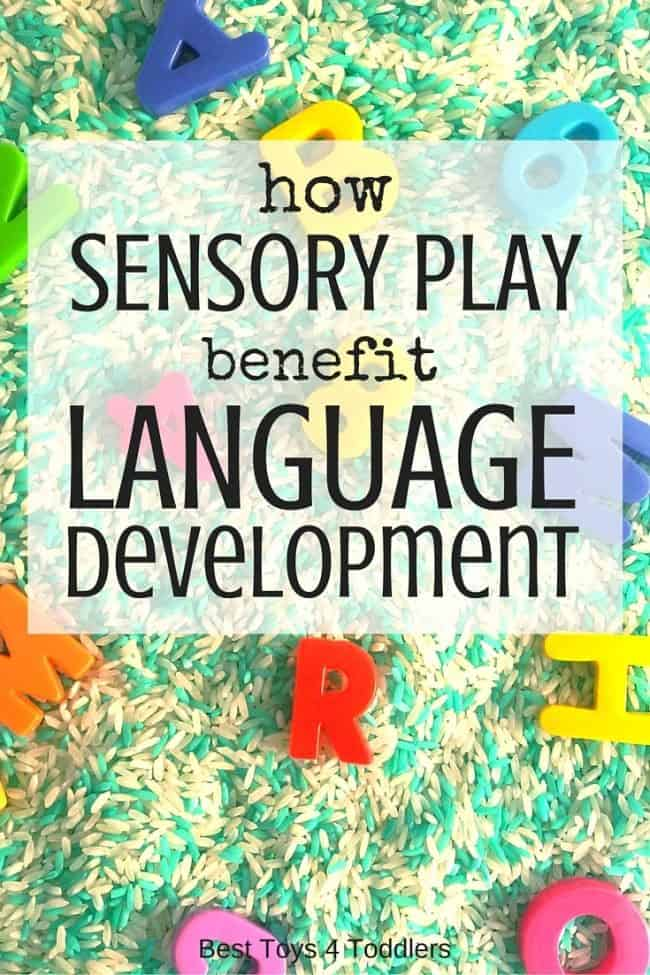
In this post, they explore fun-filled, language development activities that not only strengthen the bond between you and your baby but also lay the foundation for their communication skills. LINK»
How Sensory Play Benefits Language Development
Would you like to help your child work on their language skills in a fun and engaging way? Let’s see how sensory play benefits language development and what you can do to assist your baby, toddler or preschooler.
In this post, we’ll explore fun-filled, language development activities that not only strengthen the bond between you and your baby but also lay the foundation for their communication skills. LINK» How Sensory Play Benefits Language Development
It’s a Process
Speech development is more than speaking words. It is a complex system of verbal and nonverbal communication. To express emotions and thoughts you baby will first begin to cry to communicate his or her needs to you.
After communication crying, the sky is the limit for speech development and your baby!
But your baby needs your help along the way! The best way to develop language skills by year one is through imagination and play.
Each of the 21 activities below combines:
Imaginative play,
Simple instructions for you and baby to follow,
Activities involving both verbal and nonverbal speech.
So start playing some of these fun speech and language activities to give your baby a head start before he or she turns one!
Read more on how to utilize kids activities to reach developmental milestones! If your toddler already reached their wonderful twos, consider using Speech Blubs App in combination with offline games for kids to build their vocabulary.
Speech Development!
21 Kids Activities for Speech and Language Development
1. Animal Jam
Simply say phrases like:A cow goes ‘moo’
A duck says ‘quake’
A chicken goes ‘cluck’
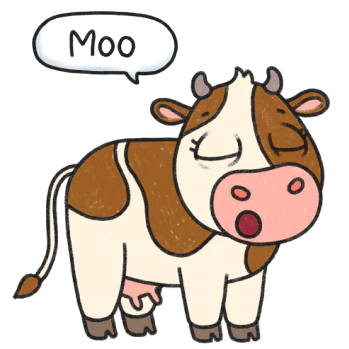
This helps your baby recognize the names of common animals along with their unique sounds. The best part about Animal Jam is it can be done anywhere, even in the car!
2. Sound Stories
Storytime is a wonderful time to bond with your baby. But it is also a way to enrich your baby’s language development. To learn speech skills, your baby also needs to learn nonverbal communication and sounds in response to everyday things. Instead of reading through a book, make reading fun by adding facial expressions, voice inflections, sound effects, and animal sounds.
3. Talk Back
Babies communicate by crying, cooing, and squealing to get your attention. When he/she is communicating with you, start talking back. If your baby coos, coo back. If baby smiles at you from across the room, smile back while saying ‘Hello’ and waving.
Babies learn through imitation. Over time your baby will not only smile, but say ‘Hello’ back to you while waving.
4. Name That Color
Everything is made of color. To help foster early color recognition, say the colors of everything you see.
For example: Name the colors of cars passing by while taking a walk to the park; tell your baby what color clothes he/she is wearing, toy colors, and more!
5. Karaoke
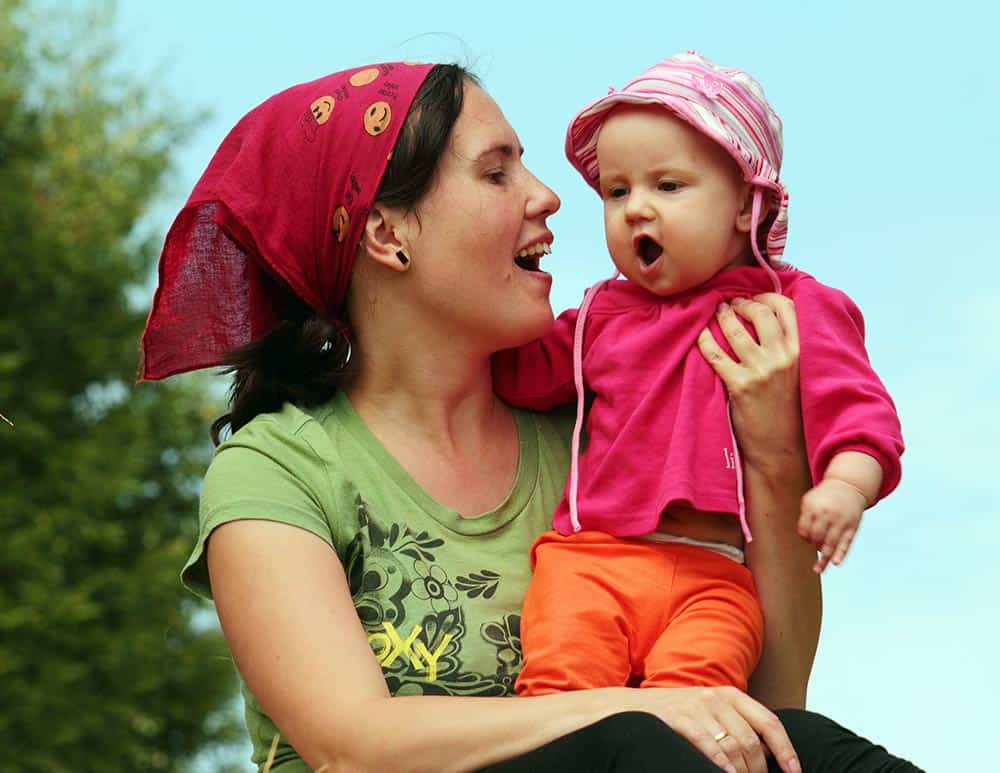
Whether you can keep a tune or not, your baby doesn’t care! Singing is a perfect way to provide a language learning opportunity that includes voice inflections, new words, and facial expressions. So go ahead and make a silly face while singing at the top of your lungs!
6. Monkey See, Monkey Do
“Monkey see, monkey do” is all about facial expressions. Facial expressions are an important aspect of speech development because they convey emotions. Research suggests that nonverbal forms of communication like facial expressions make up 60 to 65% of communication.
To encourage increased emotions through facial expressions, hold your baby in front of you and mimic his/her facial expressions. When your baby smiles, smile back. Better yet! Stick out your tongue, make a silly face, and watch to see if baby repeats your expressions.
7. Mirror, Mirror
Since tummy time is an essential part of a baby’s physical development, take advantage of tummy time by using a mirror. Not only will baby enjoy his/her reflection, but each time a coo or giggle is made your baby can see where the sound is coming from and his/her facial expressions when ‘speaking.’
8. Bicycle
After a diaper change or anytime your baby is on his/her back, take baby’s legs in move them in bicycle motions while singing a silly song or reciting a nursery rhyme. The bicycling motion will allow baby to focus on your face while you sing or speak to her/him.
9. Face-To-Face
Face-to-face is one of my favorite fun activities for promoting speech development! Lay on the floor with your little one and face each other. Point to areas of her/his face while naming the parts of the face. This will help your baby not only learn hand/eye coordination, but early recognition of parts of the face.
Better yet, take this activity one step further by doing the following example:
Point to baby’s nose and say ‘nose’
Take baby’s hand and touch your nose while saying ‘nose’
Having baby touch your nose allows her/him to understand that everyone has
similar body parts with the same names.
10. Repeat after Me
This simple game works best when facing your baby. Start making babbling sounds AKA baby talk (especially with vowel sounds) and wait for your baby to repeat them back to you. Some common coos and babbling sounds include: Oohh/aww; mamma/dada.
This type of speech normally does not develop until four months of age. So don’t be upset if your one-month-old is not catching on, just give it time. Before long you and baby will be chattering back-and-forth.
11. Say My Name
One of the biggest language developments a baby will make is learning/recognizing his/her name! While it’s different for every baby, most babies will recognize and respond to their names between 3 to 6 months of age.
To help baby along with this language development, say your baby’s name whenever possible.
Some fun ways to say your baby’s name include:
Adding his/her name to a silly song,
Asking a question with his/her name,
Replacing the names of book characters with your baby’s name.
12. Echo
To develop language babies need to repeat or ‘echo’ words. A great way to include new words and increase language skills is by adding expressive phrases to everyday situations.
For instance, if your baby drops his/her bottle on the floor say, “Oh no!”
I’ve found this activity also helps develop speech by adding sound effects to baby’s activities. Each time your baby jumps while holding him/her, add a sound effect like “boing, boing.” While trying to calm your crying baby, rock him/her back and forth while saying, “swoosh, swoosh.”
Over time, baby will begin to “echo” what he/she hears.
I know it seems silly, and that’s because it is! Echo is meant to be a fun learning activity for babies, so the sillier you get with sound effects and funny phrases the more baby absorbs new words, sounds, and phrases.
13. This Little Piggie
Next time, your baby is laying on his/her back, grab a foot and start saying the rhyme “This Little Piggie.” Since this game doesn’t number each of the five toes, the rhyme needs to be modified to help baby learn numbers.
Instead of saying “This little piggy went to the market” say, “The first little piggy went to the market; the second little piggy stayed home,” etc.
Another I’ve done the rhyme to help with number recognition is by saying the rhyme the following way:
“One little piggy went to the market”
“Two little piggies stayed home”
“Three little piggies had roast beef”
“Four little piggies had none”
“And five little piggies cried wee, wee, wee all the way home”
While this may give the rhyme much more little piggies, it still allows your baby to hear each number and count the number with each toe.
14. Carpool
Carpool is an activity that’s perfect for crawling babies! While baby is crawling, get down and your hands and knees and teach baby how to push a car or truck as she/he is crawling. Your baby doesn’t have to keep a constant hand on the car, just a little push in between crawling motions.
To include speech development, add car sound effects; tell a funny story about the car ride; sing “Wheels on the Bus/Car/Truck”; etc.
15. Roll-A-Ball
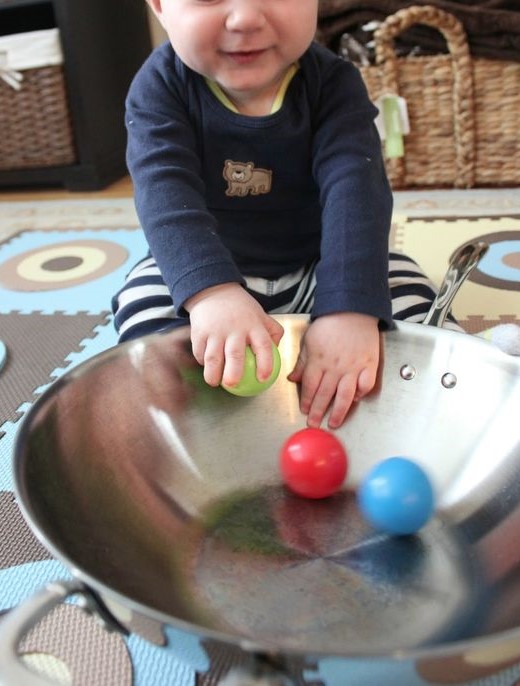
This game if perfect for babies who can sit unsupported and have decent hand/eye coordination. Simply take a (medium- to large-sized) ball and roll the ball directly toward him/her. Incorporate language skills by saying phrases like “Here is your red ball!”
Roll-A-Ball can become more advanced by helping baby understand simple instructions and responding to those instructions. Try rolling a ball over to him/her and asking him/her to roll the ball back.
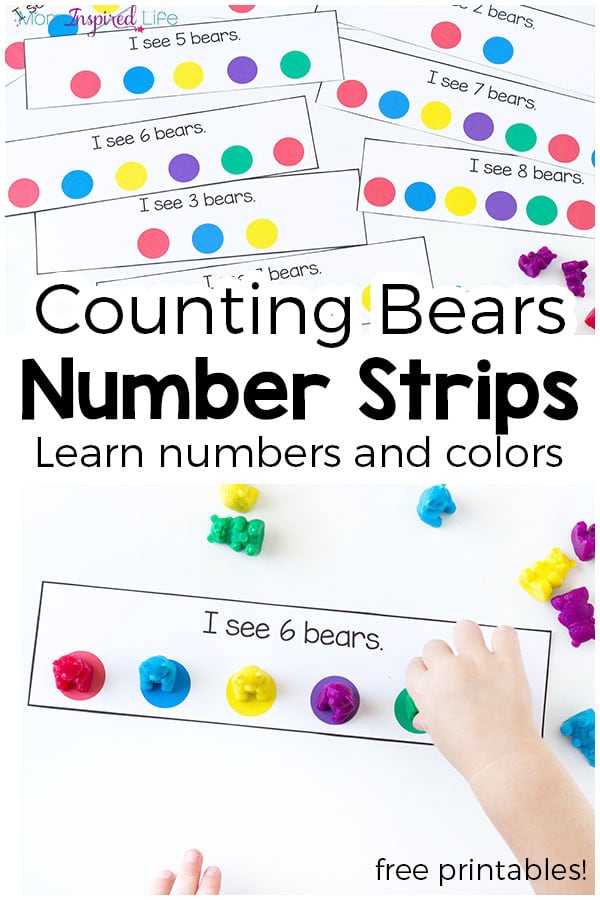
You can help your baby with learning numbers by counting out loud to him/her every day. This activity doesn’t require extra effort on your part, simply start talking and counting out loud.
The following are great ways to include number counting each day:
Count each stair step as you carry baby upstairs,
Count how many bananas you bought at the store,
Count baby’s fingers and toes.
17. Disappear, Reappear
Instead of playing a regular game of peek-a-boo, try playing with your baby’s favorite toy or stuffed animal. Hide his/her toy from view. Wait and few seconds and say “peek-a-boo.” You can also incorporate more speaking skills into the game by adding some creative dialogue!
Examples: “Peek-a-boo! There you are . . . Mister Bear missed you so much! Thank goodness you found him!”
18. Finger Puppets
Small finger or hand puppets are an amazing way to help develop language skills for your little one! By using finger or hand puppets to tell a story you are showing baby the following language and speech skills:
Different facial expressions to show emotions when speaking
Creative dialogue between two or more puppets (similar to speaking between two people).
19. Fruits and Veggies
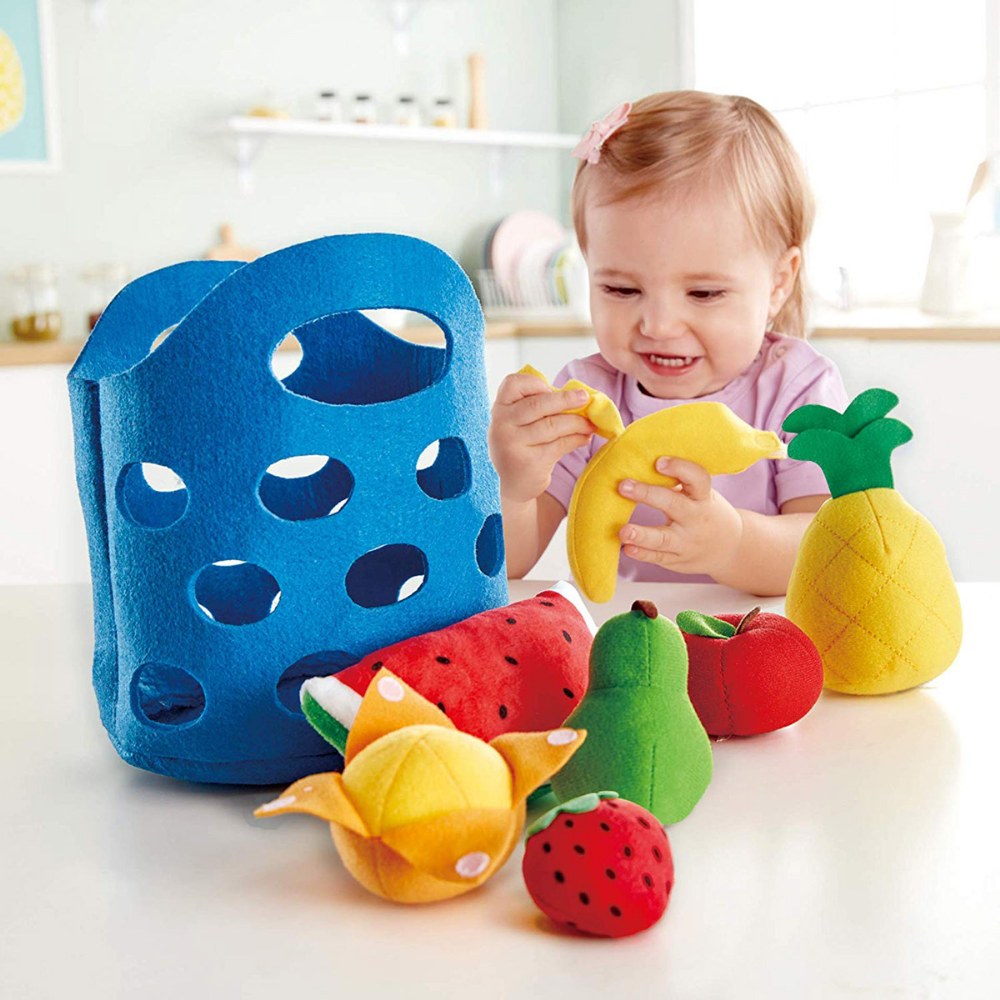
Much of a baby’s speech development has to do with repetitive hearing and use of everyday words. One way to help with word recognition of common fruits and vegetables is by playing pretend with plastic fruits and vegetables.
Although baby will need to be supervised with pretend plastic food because of small pieces, he/she will learn how to recognize a banana, carrot, pear, and more!
Also, don’t forget to count your fruits and veggies for number recognition!
20. Picture This
One of the easiest ways to help develop language skills in babies is through flashcards. Flashcards with pictures and writing help your baby begin to recognize what the picture or action is on the card along with the corresponding word or phrase.
While your baby won’t say the words out loud for a while, it helps him/her to recognize the picture with the associated word.
21. Build a Tower

Building a tower with blocks is perfect for developing hand/eye coordination. But this activity can also be used for encouraging language development in babies.
As you watch or directly help your child stack blocks, say the color of the block along with counting the blocks as the tower is being stacked. Many available baby blocks also have pictures in which you can describe the picture to your baby. For instance: If you have blocks with animals pictured on them, name each animal along with the sound the animal makes.
It’s a Process
Speech development is more than speaking words. It is a complex system of verbal and nonverbal communication. To express emotions and thoughts you baby will first begin to cry to communicate his or her needs to you.
After communication crying, the sky is the limit for speech development and your baby!
But your baby needs your help along the way! The best way to develop language skills by year one is through imagination and play.
Each of the 21 activities above combines:
Imaginative play,
Simple instructions for you and baby to follow,
Activities involving both verbal and nonverbal speech.
So start playing some of these fun speech and language activities to give your baby a head start before he or she turns one!
Read more on how to utilize kids activities to reach developmental milestones! If your toddler already reached their wonderful twos, consider using Speech Blubs App in combination with offline games for kids to build their vocabulary.
Baby Dolls + Stuffed Animals
For older infants and young toddlers, baby dolls and stuffed animals are often the first props in pretend play. Dramatic play becomes more complex as a child gets older and is valuable in developing language and communication skills.
At this age, they need you to model how to use toys in dramatic play. Model conversations, narrate caring for a baby doll, or have the toys act out simple social scenarios. Toddlers will be able to practice using the words and sounds they are learning.
Simple Instructions
Giving your child simple instructions is a way for them to build receptive language skills.
“Can you hand me that book, please?”
“Find your shoe and bring it here.”
“Toss that paper in the trash.”
Don’t use this activity to test how well your child can follow directions. Instead, you are using these opportunities to gently guide your child when they are confused or don’t understand a request. You are giving them the language they need to problem-solve.
“Oh, I needed the book. You gave me the box. The book is beside it.”
“Do you need help finding your shoe? Check under the blanket.”
“Hey, you found the trash can. Thanks for helping me clean up the kitchen.”
“Try asking mom where the cup is.”
Telling Stories
Telling stories builds language and can help a child learn more about their family or community.
This is a perfect activity to do while driving in a car or walking. You can tell stories from books, make up your own, or share stories from your own life.
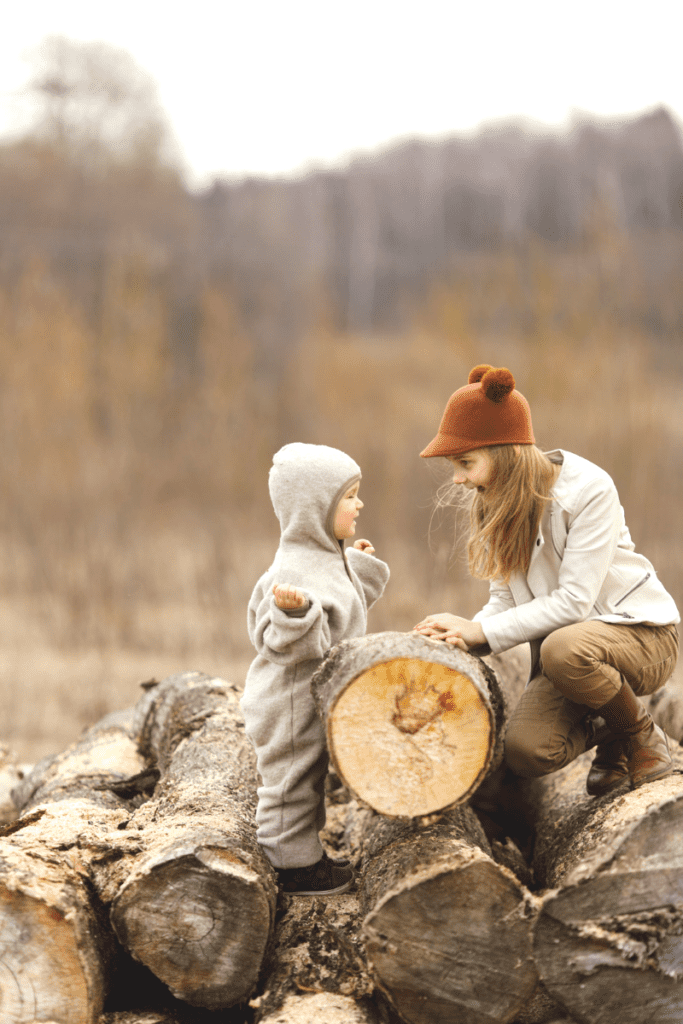
Art + Dictation
Asking your child to share about their artwork is a perfect way to build language. Toddlers can practice sharing what they created. Adding dictation to art helps capture your child’s words. Take a moment to write exactly how your child described it at the bottom of the art.
“It blue.”
“Dog.”
“I did it!”
As children get a little older, always ask permission before writing on their artwork. You can add a post-it note or write on the back if they want you to capture their description without altering their creations.
Talking During Care Routines
Nothing more personal than the moments you provide direct care to your baby or toddler. Rocking to sleep, bathing, changing diapers, feeding, and dressing are all very intimate moments. Use these times to really connect with your children and introduce language.
Narrate While Your Child Problem Solves
This activity will make any play more language-rich. It also helps your child preserve the information they just learned.
“Oh, that didn’t fit. Yes, try rotating the block like that.”
“You are trying so hard to reach that. You lifted up on your tippy-toes and reached the book.”
Exploring Outdoors
There are endless opportunities for language learning when you explore the outdoors. Point out different colors, shapes, sizes, and textures as you walk. Describe the actions of animals and people you see.
Ask your child questions about what they are experiencing.
“I see a red bird. Do you see it? It’s flying from that tree to the next one.”
“The wind is blowing. Do you feel it? It’s so strong!”
“That dog is so big! And he’s barking.”
“What do you think that kid is saying?”
Counting Activities
Yes, a math activity to promote language skills. When you count with your child, you are not only teaching them numbers but also new words. As you count different items with your child, help them describe what they are seeing.
“One, two, three, four blueberries. Can you eat one?”
“Five flowers. I wonder if bees are eating from all five?”
“Ten steps. Let’s see if we can take ten more.”
Describing Emotions
Labeling feelings is a great way to help your child understand and begin to regulate their emotions. It also helps them learn the words to express what they are thinking and feeling.
“You look so happy! Did something fun happen?”
“You seem a little sad today. Want to sit with me?”
Ways to boost language through out the day
Laying the Foundation for Talking:
Teaching Imitation Skills
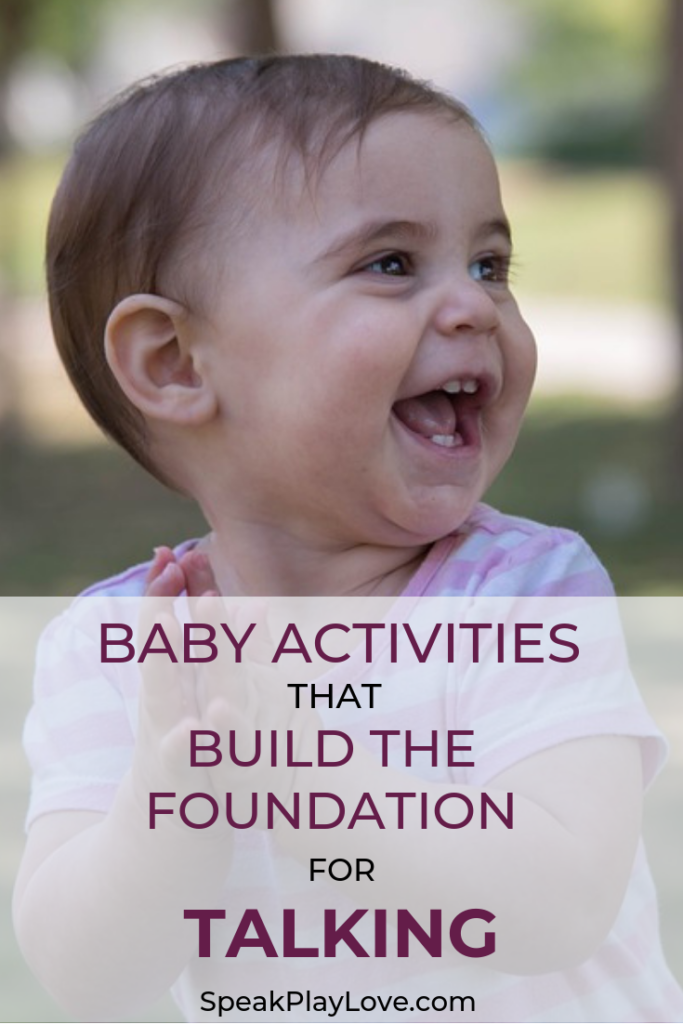
If you have a baby close to the one year mark, you might be hoping that your little one will start talking any day now.
Or maybe your have an infant (6-12 months) and are looking for some ways to build that foundation for talking.
Or you may have a late talker and are looking for some ideas. (If that is the case, I suggest you check out Toddler Talk for more in-depth ideas on how to work with your toddler to get him or her talking.)
Here’s a question for you: Is your child imitating you – your actions, your expressions, your sounds? If not, you may want to be teaching imitation skills!
Think about how babies learn say their early words – they imitate you or repeat after you. That’s why learning the skill of imitation, any type of imitation, is so important as a foundation. It seems simple enough, but there is actually a lot going on when a child is learning how to imitate.
Let’s say your child is going to imitate you clapping. To do this “simple” task, your child has to:

Pay attention to you – watch and process what you are doing
Have the initiative to attempt a try
Coordinate muscles
Try several times to practice and get the movement right
Watch for your response – When it is a positive that will make him more likely to try to imitate more things!
Start to understand social turn-taking (a building block for conversational turns)
If your child is not talking yet, a great way to build the foundation for future talking is by working on imitation. You can work on this in some fun ways to help your child imitate actions and then work up to sounds and then words!
How to Teach Imitation Skills
– Physical Imitation Activities:
Clapping and Arms Up
Clapping babies are so cute! Clapping and raising both arms in the air are some of the earliest actions that babies learn to copy (and do on their own). Encourage your child to clap with you by demonstrating and even guiding their hands the first few times to help them understand what to do.
For practicing Arms Up, try creating a verbal routine (something you say the same way each time) by asking your child, “How big is baby (or child’s name)?” and then answering, “So big!” as you raise both hands into the air. Once your child knows what to expect, you can ask the question and raise your hands up but then WAIT until she copies your action before you reward her by saying, “So Big!” This is sure to get lots of giggles!
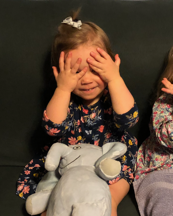
Peek-a-Boo
Peek-a-Boo is another classic for a reason. It’s very repetitive, which is perfect for very early learning. Plus, as babies learn about object permanence, having something (like your face) quickly “disappear” is exciting! You can try guiding your child’s hands a few times to help him get the idea.
Pointing
Pointing is great not only for imitating, but also as a foundation skill for early communication. Think about how much a child can express about what they want, need, or are interested in just by pointing!
How to encourage pointing: As you are out on a walk or looking through a book, point to something that your child seems interested in. Then you can guide her finger to do the same. Reward her point by telling her what the item is called. You are also working on filling her bucket with vocabulary that she will use later!
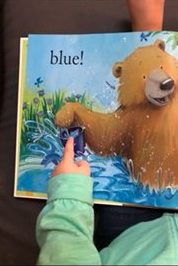
Try to read every day with your child to develop a routine that includes pointing to things in her favorite books. Remember, while you might be sick of reading Goodnight Moon, your child loves repetition! Plus, repetition is one of the best ways for her to learn.
RELATED: How to Raise a Little Bookworm
Sing Songs with Movements
Try singing songs that have movements that go along with them such as
“Ring around the Rosies”
“If You’re Happy and Your Know It, Clap Your Hands”
“Wheels on the Bus”
“Head, Shoulders, Knees, and Toes”
“Hokey Pokey”
RELATED: 12 Kid’s Songs for Language Development
Sign Language or “Baby Signs”
Once your little one is starting to imitate you a bit, introduce some simple sign language into the mix. You can teach this by modeling signs while saying the word, then guiding his hands to form the sign.
Try to do this during meaningful times. For instance, if he getting milk, then show him the sign for milk, have him make the sign, and then hand over the sippy cup. You can look up videos of how to form individual words in sign language here – just type in the word you are looking for.
Some useful first words to target through sign language:
More
All Done (in the ASL video dictionary, just search for “done”)
Milk
Eat
Drink
Book
How to Teach Imitation Skills
– Verbal Imitation Activities:
Once you’ve got your little one imitating some basic physical movements, it’s time to try out some verbal imitation activities.
Imitate Your Child’s Sounds
Okay – I know we are supposed to be talking about getting your child to imitate you, but this is a good place to start. You will peak your child’s interest by imitating his babbling – or any sound he makes. This can also teach him that it is a type of game that can be fun!
Sound Effects
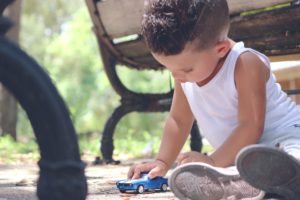
While playing with cars, try “Vrroom” or “beep beep.” Or while playing with a baby doll or stuffed animal, make crying sounds or drinking/eating sounds. This can be more enticing to some children to start making sounds with their mouths.
Animal Sounds
Making animal sounds is another fun, silly thing to try with your little one! You can do this while looking at an animal book, at pictures of animals, or with animal toys. Some easier animal sounds are “woof,” “moo,” “baa” and “meow” but any sounds that are motivating for your child is a great place to start!
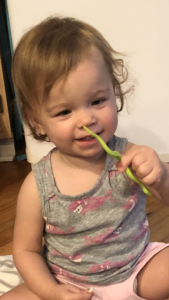
And once you’ve got your child imitating vocal sounds, then next step are those first words you’ve been waiting for!!
P.S. Here’s a link the book Toddler Talk that I talked about if you are worried about your toddler’s language development.
RELATED: 9 Tips to Get Your Toddler Talking
Fun Activities Support Infant Language Development
There is a magical joy in hearing your baby coo and babble, as these are the building blocks of their language development.
But did you know that you can play a crucial role in fostering your little one’s language skills?
Through simple, enjoyable activities, new parents can create a nurturing environment that promotes language development right from infancy.
During the first year, babies are like language sponges, keenly absorbing and responding to the sounds and movements in their environment.
One of the first skills they develop is the ability to make new sounds.
From cooing at around 2 months to babbling towards the end of their first year, these sounds are the early stages of speech development.
Imitation plays a critical role during this phase.
Infants observe and start mimicking gestures, sounds, and simple words that they see or hear frequently.
This copying behavior is a fundamental stepping stone in language acquisition.
Another pivotal skill babies work on is listening and reacting to sounds and voices.
Even before they can talk, they begin to understand the nuances of language.
They keenly observe intonation, pitch, and rhythm, which helps them to gradually recognize familiar voices or react to the emotional tone of a conversation.
All these skills work together to pave the way for your baby’s language and communication development.
Make Tummy Time a Positive Experience While Working on Communication Milestones
Believe it or not, tummy time can be a fantastic avenue to encourage language development in your infant. As your baby spends time on their tummy, they gain a new perspective of the world around them, stimulating their curiosity and interest. During this time, you can engage your child with different sounds, sing songs, tell nursery rhymes, or talk to them about their surroundings.
This can help stimulate their auditory senses and expose them to varied tones, pitches, and sounds of language.
Furthermore, responding to their coos and babbles not only makes tummy time a positive experience but also supports their communication milestones.
Remember, the more sounds, words, and positive vocal interactions they hear, the better for their language development.
Encouraging Communication Skills Through Daily Routines
Incorporating language learning into daily routines can be one of the best ways to grow your child’s vocabulary.
Everyday activities such as bathing, feeding, or changing diapers provide abundant opportunities for language exposure and reinforcement.
As you engage in these routines, be mindful and intentional in your interactions.
Narrate what you’re doing, describe objects around you, or even sing songs.
This not only introduces new words and sounds but also builds a comforting rhythm of repetitive practice, essential in language acquisition.
Over time, these structured, habitual interactions become a part of your baby’s daily life, seamlessly integrating language learning into their everyday experience.
The key is consistency and repetition, as this helps your baby recognize patterns and predictability in language, laying a strong foundation for their future communication skills.
For more easy ideas and activities on how to support your baby’s development CLICK HERE.
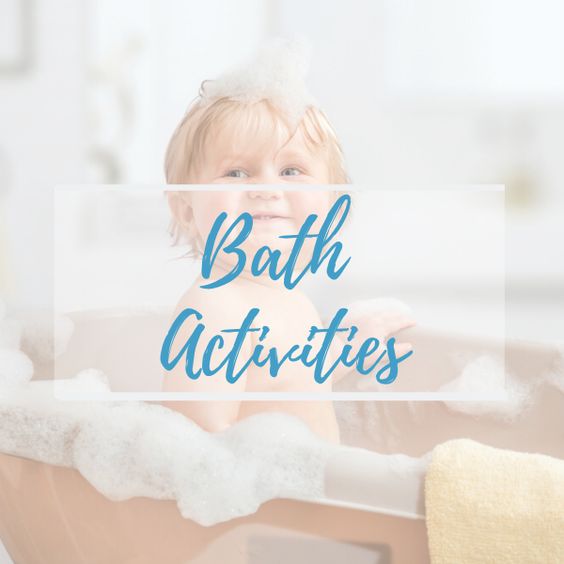
Work on Baby’s language skills during Bath Time
Bathtime offers a fantastic opportunity to work on your baby’s language skills.
The sensory-rich environment of splashing water, floating toys, bubbles, and warm towels can stimulate your baby’s interest and curiosity.
You can use this time to describe the different objects in the bath, introduce words related to temperature like ‘warm’ or ‘cool’, or even narrate a short, fun story about their rubber duck navigating the ‘ocean’ in their tub.
You can name body parts so that these important words become part of their vocabulary.
The echoey sound that is often found in a bathroom also makes sounds fun to try out.
Singing songs about bathing can also add a musical element to language learning.
Bath time, thus, becomes more than just routine hygiene; it is an educational, bonding experience that helps cultivate your baby’s language and communication skills.
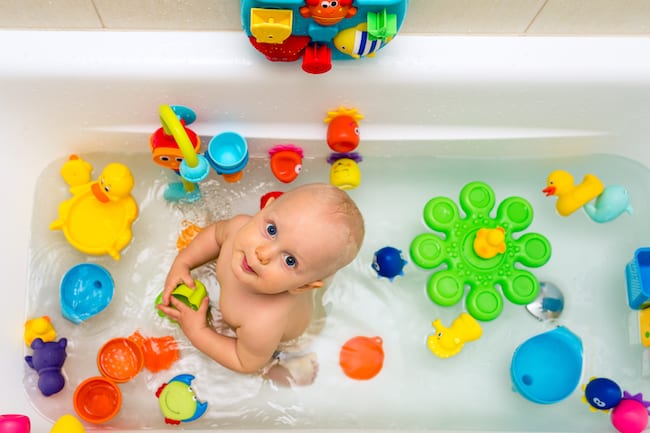
10 Best Baby Bath Accessories (Safe, Soft & Multi-Sensory)10 Best Baby Bath Accessories (Safe, Soft & Multi-Sensory)
Introduce New Words During Snack Time
Snack time can be an excellent opportunity to introduce new words and concepts to your baby. Use gestures or baby sign language as a way for your baby to communicate even before those first words come in. Signs such as “more” or “all done” can be perfect to model and teach during snack time. Snack time is a great time to help children learn words for a number of reasons, including:
Hearing new words: Talking with your child at snack time helps them hear new words and learn to associate words with objects.
Responding to interests: Responding to your child's interest in a word helps them learn it more quickly.
Repeating words: Repeating words often helps children link the word to the object.
Bonding: Spending time together at snack time can help you bond with your child.
BBC Chatting together at snack time - Why should you talk to your baby at snack time? Talking at snack time helps your baby hear...
You can also use this time to teach them words like ‘bite,’ ‘chew,’ and ‘swallow.’
Remember to make snack time interactive and fun. Encourage them to touch and feel their food, this can also be a great sensory activity. Respond to their reactions to different foods and reinforce the words you introduce, setting a foundation for their language comprehension and expression.
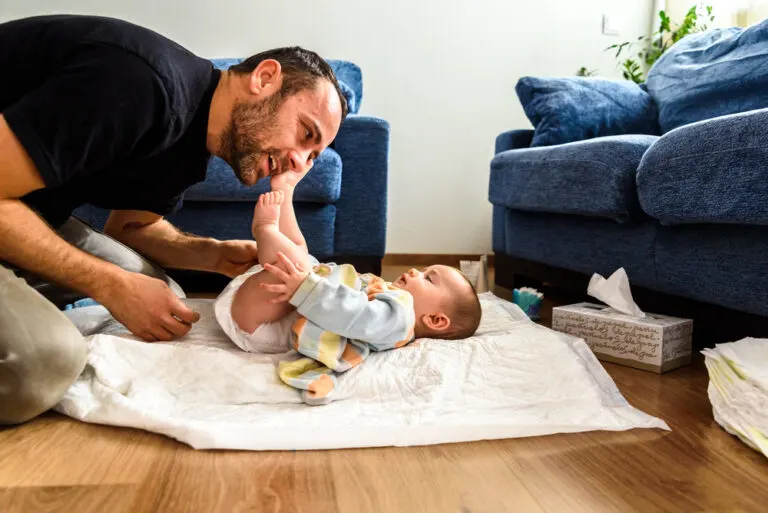
Work on First Words During a Diaper Change
Diaper changes, though seemingly mundane, are actually fantastic opportunities for language learning.
This is because they are routine, repetitive moments that happen numerous times throughout the day, providing ample practice for your baby.
What makes this time even more unique is the face-to-face interaction it allows.
As you change your baby’s diaper, you’re in direct eye contact with them, making it the perfect moment to model new words and sounds.
You can talk about what you’re doing, name the objects you’re using, and even introduce concepts such as ‘wet’ or ‘dry’.
This close interaction is vital for your baby to observe your mouth movement, which aids them in learning to form words.
Additionally, this can be a great time to incorporate a song or a fingerplay.
These rhythmic, musical elements can make language learning stimulating and fun.
Overall, diaper changes offer a unique, intimate setting for language learning right from infancy, turning mundane moments into enriching experiences.
Reading Books Supports Receptive and Expressive Language Development
Reading books to your infant is an incredibly effective method for bolstering early literacy skills and it is a great way to support language development.
It provides a structured setting for introducing new words and concepts, thereby helping to expand your baby’s growing vocabulary.
As you read aloud, your child is exposed to the sounds, rhythms, and patterns of language, which play a pivotal role in their linguistic and cognitive development.
Furthermore, books often include a myriad of topics, characters, and situations, offering a rich source of diverse vocabulary and complex sentences.
This consistent exposure to language aids in the development of both receptive language skills (understanding of words and language) and expressive language skills (ability to express oneself).
Reading is also a wonderful time for interaction.
When your baby responds to the images or the story, ensure to react and engage with them, as this active participation promotes their communication skills.
Therefore, establishing a regular reading routine not only paves the way for early literacy but also significantly contributes to your child’s language and communication proficiency.
So choose one of your favorite board books and take some time to read together!
Superscript
Making Connections
Baby's communication
(adapted from UNICEF)
In the first year of life, infants normally babble a variety of sounds with various inflections, first to practice and complete the feedback loop of hearing. At around 12-15 months, first words appear, followed by two-word phrases and oftentimes lots of jargon so that your child sounds like he is talking in sentences.
So what language development activities can you engage your baby in?
I have researched and compiled the most effective daily language activities for infants to support language development (so you don’t have to).
HOW TO IMPROVE LANGUAGE SKILLS
To help your baby develop their language skills, you don’t need any special training – you just need to make a conscious effort. Your baby’s first year is super important for their cognitive development, speech, and language, and they’re so eager to learn!
Creating a nurturing environment for listening and communicating can be super simple – you can do it right at home.
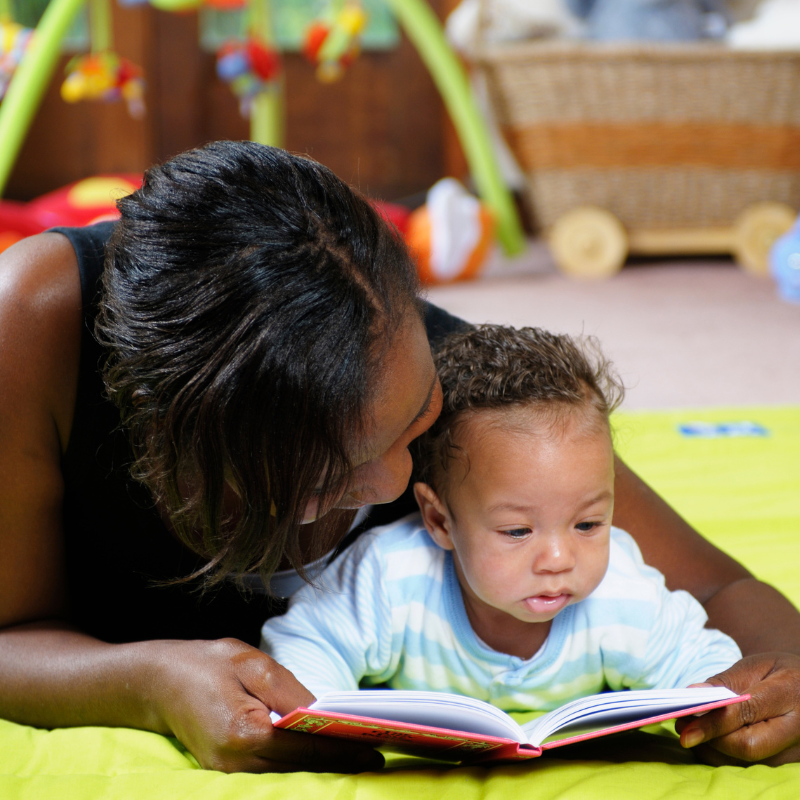
1. Read to your baby
Reading to your little one is such a wonderful way to introduce them to new words and language structures! Even if they don’t understand the words just yet, the rhythm and sound of language will still have a positive impact on your child’s speech development.
Board books with bright, colorful illustrations and simple, repetitive text are an excellent choice for reading to your child. Take the time to point out and name familiar objects in the pictures. This can help your little one connect words with objects and develop their listening skills.
Another great way to practice early literacy is to let your baby read a book themselves. Obviously, your baby won’t just start flipping pages and reading the words. Babies “read” with their whole bodies. They will grab a book and explore it by mouthing, shaking and chewing on it.
The best books for this are from the Indestructible Book Series. It is made specifically for the way babies “read” and they are safe to be chewed on and cannot be ripped apart (we tried!).
2. Play a simple game of peek-a-boo
Simple back-and-forth games such as peek-a-boo are a fun way to connect body movement with speech. Playing uncomplicated games with your little one is a wonderful approach to familiarize them with turn-taking, reaction, and exchange skills, which are vital for their language development in the future.
It’s important to incorporate these games into your daily routine to encourage language development right from the start.

3. Sing songs for your baby
Simple songs such as lullabies or common nursery rhymes are a phenomenal way to expand your child’s vocabulary. You can use them to name body parts (“head, shoulders, knees and toes”) or objects or to introduce some baby sign language.
It’s a great way to incorporate a fun activity into your day. Listening to your voice is comforting for a young baby and it might encourage them to join in very soon.
4. Babble with them and practice taking turns
When babies babble, they’re actually practicing different sounds and word combinations, which is why it’s so important for their language development. If you want to help your little one, you can repeat the sounds they make and even introduce new ones.
For example, if your baby says “ba,” you can respond with “ba ba” or “ma ma.” And when you mimic their babbling, you’re showing them that you understand and appreciate what they’re trying to say.
5. Narrate what you are doing
Talking around babies frequently and consistently can really help their language development. This is called language immersion and it’s the most efficient way humans learn languages.
Babies are very keen listeners and it is great to have them around while you talk to someone else or, if alone, when you narrate what you are doing. It’s almost like you are telling them a story.
For example, you could tell them what you are preparing for breakfast and how you are making it. Use simple and short sentences and emphasize the sounds of certain words, such as objects you are naming or activities you are doing.
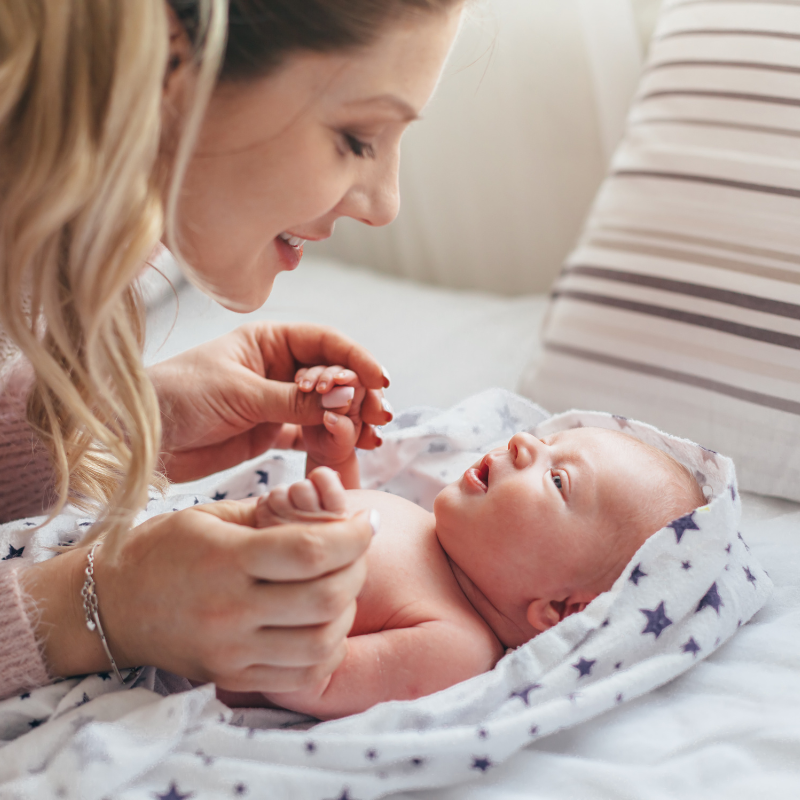
6. Engage in a baby conversation
7. Ask questions
8. Use gestures

Early Language Activities for Babies are Beneficial
Early language development is crucial for a child’s overall growth and future success. Children with a solid language foundation tend to perform better in school and achieve higher academic success.
Language skills are closely linked to cognitive development.
Children with strong language abilities tend to excel in problem-solving, memory, and attention-based tasks. Additionally, children with advanced language skills can better express their thoughts and emotions, leading to improved social and emotional development.
So make sure to talk to your baby often, even if it seems silly!
Simply engage all of baby’s senses every day and don’t feel pressured to do anything “special”.
Unsure whether your baby’s speech is on track?
You can use the table above to get an idea of where your infant should roughly be with their speech development throughout the first year. I’d suggest not to assume the worst if your baby develops their speech later than the table suggests. Every child and every culture and language are different so there is a wide range of normal.
If you do think you want professional support with your child’s language development after you have tried yourself, you may want to seek out a speech-language pathologist.
More Tips to Boost Your Child’s Speech
The Power of Play: How Games Can Help Your Kid Thrive
Why is child play so important? Play creates the perfect opportunity for learning more language. Whether it is finding new objects, learning new actions, experiencing…
Toddler Games, Books and Apps for Speech Development
These materials will target children who have been diagnosed with a speech delay, but can also be used for kids who have articulation deficits (can’t…
Conclusions
Fun Activities that Support Infant Language Development
There is a magical joy in hearing your baby coo and babble, as these are the building blocks of their language development. But did you know that you can play a crucial role in fostering your little one’s language skills? Through simple, enjoyable activities, new parents can create a nurturing environment that promotes language development right from infancy.
Here is a Awesome Incredible Kids PDF on supporting language development with specific toys and play.
Playing With A Purpose
IMPROVING SPEECH OR VOCABULARY
Growing Language- Using Play Themes
Playful Language Orientation
During the first two years, a baby’s development is the highlight of their life. From everything we do and teach them, this is how they will continue to learn. During this time, developmental language activities are important. Especially if genetics hint toward a learning disability or Autism Spectrum disorders. But they are also fun and simple!
Playing Peek-a-Boo
Not the usual covering your face Peek-a-Boo. The one where you take a toy as they’re watching you and hide it under a blanket or something, but leave a little bit of it sticking out.
Ask them “where is it?” and encourage them to look for it. Most babies will dive right for where you hid it. Once they have mastered this, start hiding it without having a little part of it showing. This is great for their fine motor skills and object permanence. This is a quick, fun AND easy baby developmental baby activity!
Stack Toys Together
You can buy stacking toys (click HERE for ours) or you can use plastic cups you have at home! Take turns stacking the stacking toys or cups.
Don’t be annoyed if you find your baby just knocking them down. My baby LOVES breaking down stacking toys and towers. This is normal as they find a lot of excitement in it, especially if it’s new! Just keep stacking and show them how to do it as well. This helps them learn cause and effect and is a great activity for your baby.
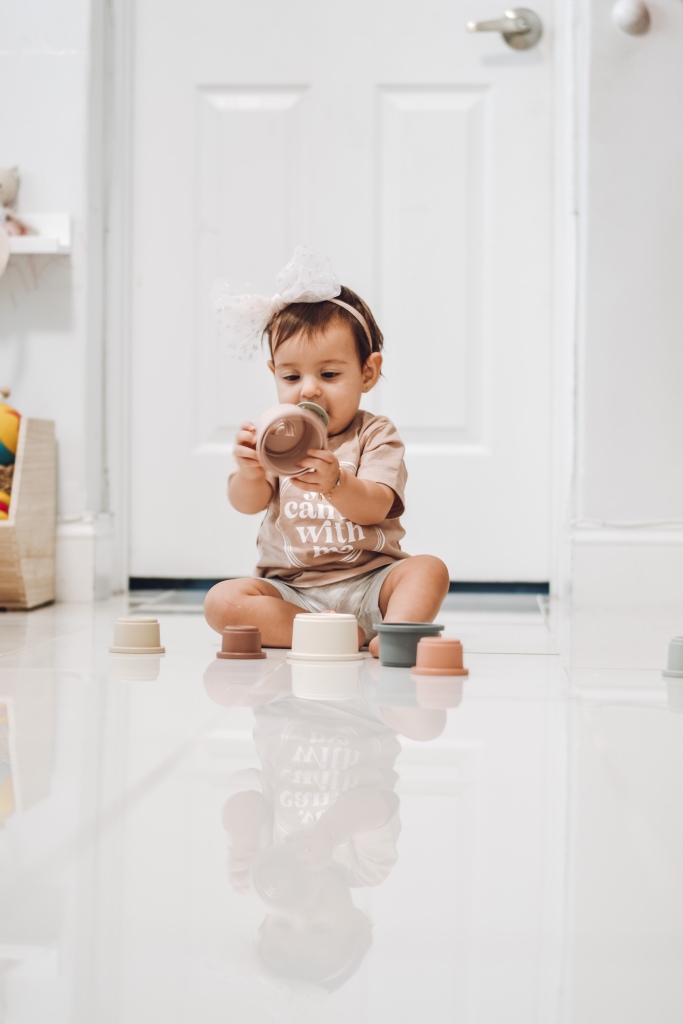
Wooden Puzzles!
Grab from the store any baby wooden puzzles. Maybe get them a custom name puzzle with pegs from HERE like the one we have. Make sure the pieces are big enough for their little hands and minds.
Start by introducing puzzles and encourage them to play with them at an earlier age. Play with them! Show AND tell them how to do it. Guide their little hands with the puzzle piece to where it belongs. Let them attempt it themselves. When they get it, cheer them on and make them feel happy and excited. Playing with puzzles helps them with problem solving, visual skills and fine motor skills. Puzzles are fun baby activities (6-months and older)!
Read them Books
What baby doesn’t like looking through picture books? Get them ones that have many colors and pictures to look at. Sit with them and read it to them, but make sure to use different voices and expressions to make it more fun and exciting. Let them help you turn the pages. Be sure to also point to pictures as you are reading. Reading is great for their language development and listening skills making this not only fun, but a bonding time for mom and baby!
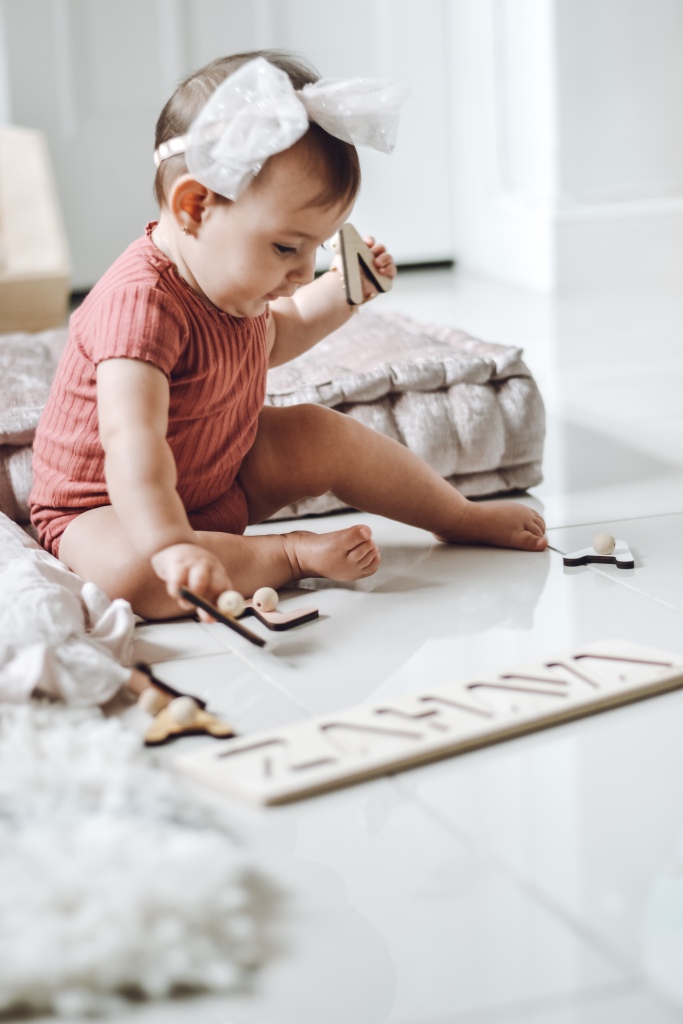
Make them a Bottle Rattle
Have empty water bottles lying around? Fill it up with some beans or rice (or anything else!) and glue the top shut. Give your baby the rattle and watch them shake it and see their expression when they hear the noise they are creating. Especially since they usually know that bottles themselves do not make noise, this will be a surprise to them.
Since it is surprising to them, this brings in the element of being surprised into their development. It also is great for their fine motor skills, auditory discrimination and cause and effect. This is one of those baby activities that are fun for them because if your baby is anything like mine and loves water bottles, this will be exciting!
Disappearing Baby “Snack”
This is such a fun and engaging activity for babies! Take a smaller finger food snack your baby likes (like cheerios) and take 2 plastic cups. Cover the snack with one cup and let the baby figure out where it is. Use 2 color cups and show them which is covering the snack, move the cups around and see if they remember which cup it is under. Once the baby masters that, do it with the other cup.
This is a great and simple developmental baby activity for reinforcing object performance as well as developing their attention skills and memory.
{Want to try out a new baby snack? Read about YUMI ORGANIC BABY FOOD}
Ziploc Finger Painting
Grab a gallon size Ziploc (or any bag of your choosing) and add some washable non-toxic paint inside. Seal it shut, and better to use duct tape to make it even more sealed and safe. Spread the paint around and then lay it flat for the baby to play with on the floor or high chair. For better playing, tape it down to the area they will be playing on.
Let your baby play around with with their fingers making squiggly lines and whatever else their fingers make. Making marks on the bag helps with their sensory development, fine motor skills, cause and effect and early writing skills. Plus, with this baby activity, they may develop into a mini Picasso!
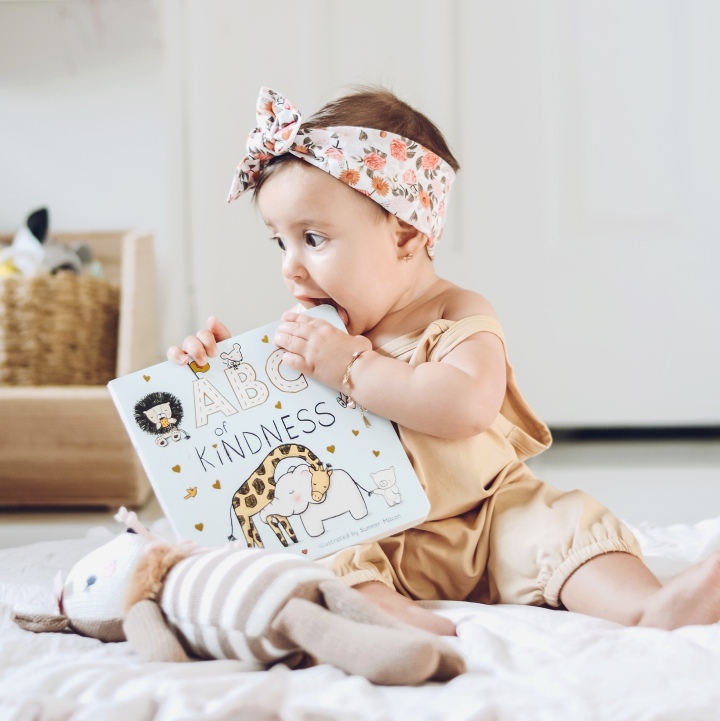
Container Play
Take a container large enough to fit some of their toys. Put in balls, pegs, whatever your baby likes to play with. Hand it to them and see what they do. At first, they may find it more fun to just turn it over and dump the entire thing out. But soon enough they will realize that there are toys inside and will start banging and shaking the container with the toys inside, as well as grabbing some toys out.
Reload the container until they slowly figure out how to put the toys back inside themselves. Once they master this, you can start using smaller containers! This is great for object manipulation and orientation skills.
Introduction to Language Play For The Home
I understand the crucial role parents play in shaping toddlers’ language development. Early on, we have the power to influence their communication skills in meaningful ways.
I’m excited to share my favorite play-based, nurturing language activities that will not only enrich your toddler’s language journey but also make learning fun and interactive.
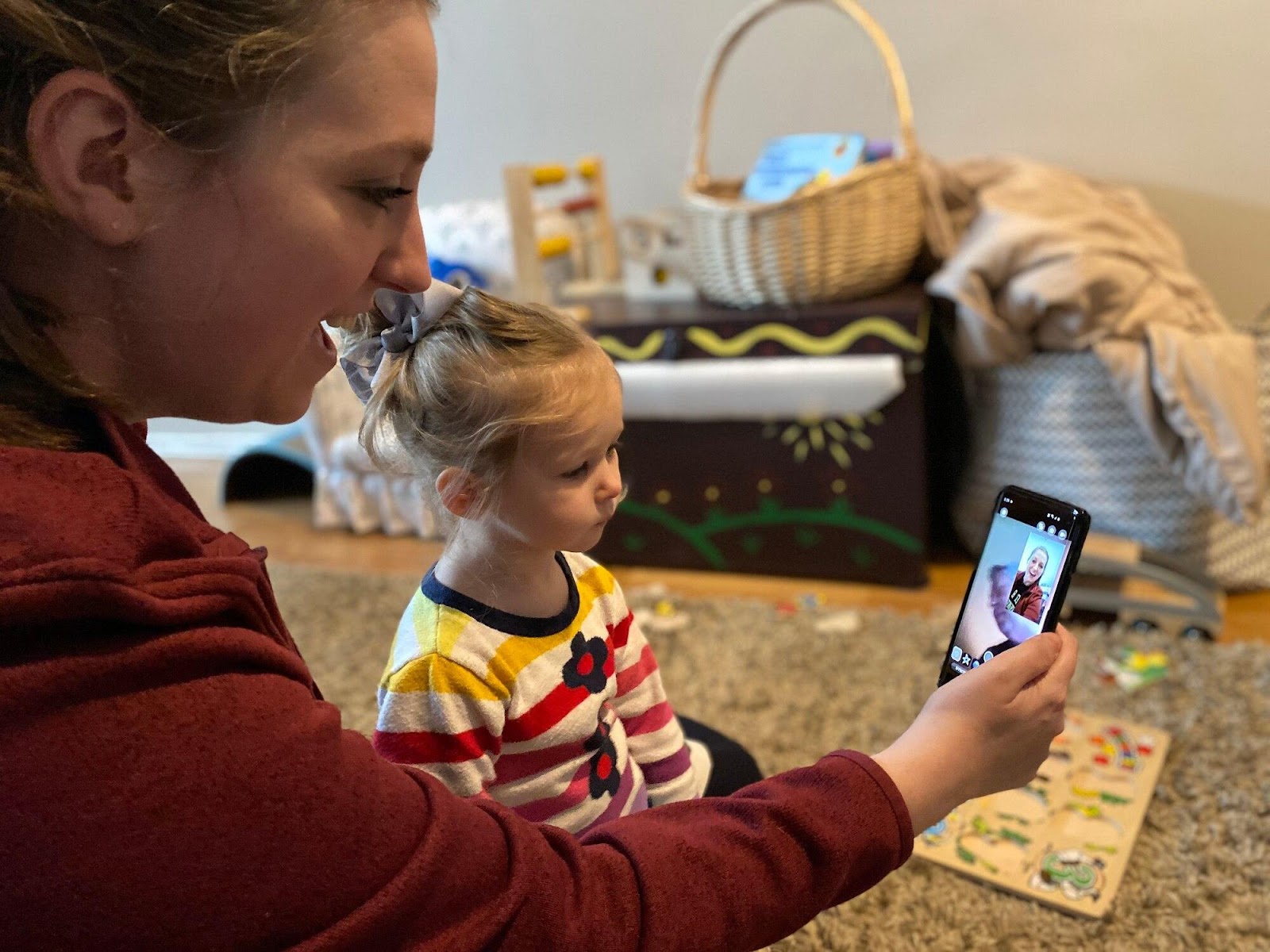
Importance of Toddler Language Development
Language development in the early years can impact a person’s ability to communicate and understand language over a lifetime. A child’s vocabulary starts to snowball during the second year.
As communication skills develop, parents and educators need to ensure they are creating a language-rich environment. This is also the time to closely monitor language development to catch speech and communication delays early.
Montessori Language Activities
- Examples and how to keep them relevant.
Above pictured are some of the recent language baskets and trays I've used with Weston (18 months). My approach with Weston is slightly different to what I used with Richie. I've made sure that all of Weston's language materials are relevant to him and our family. The animals are animals that he has seen, the vehicles have been seen in our community, the workers are those that Weston knows, the flowers and herbs are from our very own garden. There are no Australian animals, no African or Arctic animals, we will introduce these later, once they become relevant to him. I've also tried to include items that interest him.
Toddlers are absorbing so much and learning about the world around them, they are trying to make sense of the world around them. We can assist them with language, by giving them the names, the words of things. Why not start with the things that really exist around them.
Dogs / Birds
Transport / Insects
Community Workers / Farm Animals
Root Vegetables / Fruit
Herbs / Flowers
Language baskets are primarily about language, teaching the names of things, to increase knowledge, expand vocabulary and comprehension.
At home, language baskets can also be used for open-ended play and loose parts. We can take them into the kitchen and cut the foods open and taste them, admire what is inside. We can use the language baskets for a three-period lesson. I keep in mind to use accurate language and scientific names. At 18 months we haven't used any language cards or started any matching activities. Weston is really absorbed in his current materials, this will be a natural progression.
We are also constrained by our environment and resources. I love looking at language baskets in toddler classrooms. Often I've seen miniature work tools, model gardening materials, holiday clothes (often doll sized), beach clothes and equipment all in language baskets. Please note that you may want to use less objects in your language baskets than we have in ours pictured, often it's best to start with fewer object especially if they are new to the child or if the child is younger.
Montessori language baskets are a way to introduce infants and toddlers to new vocabulary, increase knowledge and comprehension of the objects being introduced, and a sensorial extension to the language learning experience.
Beyond their simplicity, they are also a simple and versatile tool to expand language at home. They can easily be adapted to make the contents relevant to the seasons, holidays, your child’s unique interests or your family. We love using them to explore items specific to the seasons or a place we are about to visit. The baskets serve as 3-D flash cards that they can touch and see from all angles.
In their early stages (without the use of cards for matching), language baskets are a useful language tool for infants and toddlers alike. Children as young a 12 month olds can engage in sensorial exploration of the items they are learning about, while older toddlers can still benefit from having items to explore (without the cards), when they are learning about them for the first time. So, even with an older toddler, don’t discount the value of presenting new items or replicas alone before introducing matching cards.
Progression of the Language Basket Material at Home
From items on their own, to matching cards, and the different options: here’s how to get started implementing this material at home
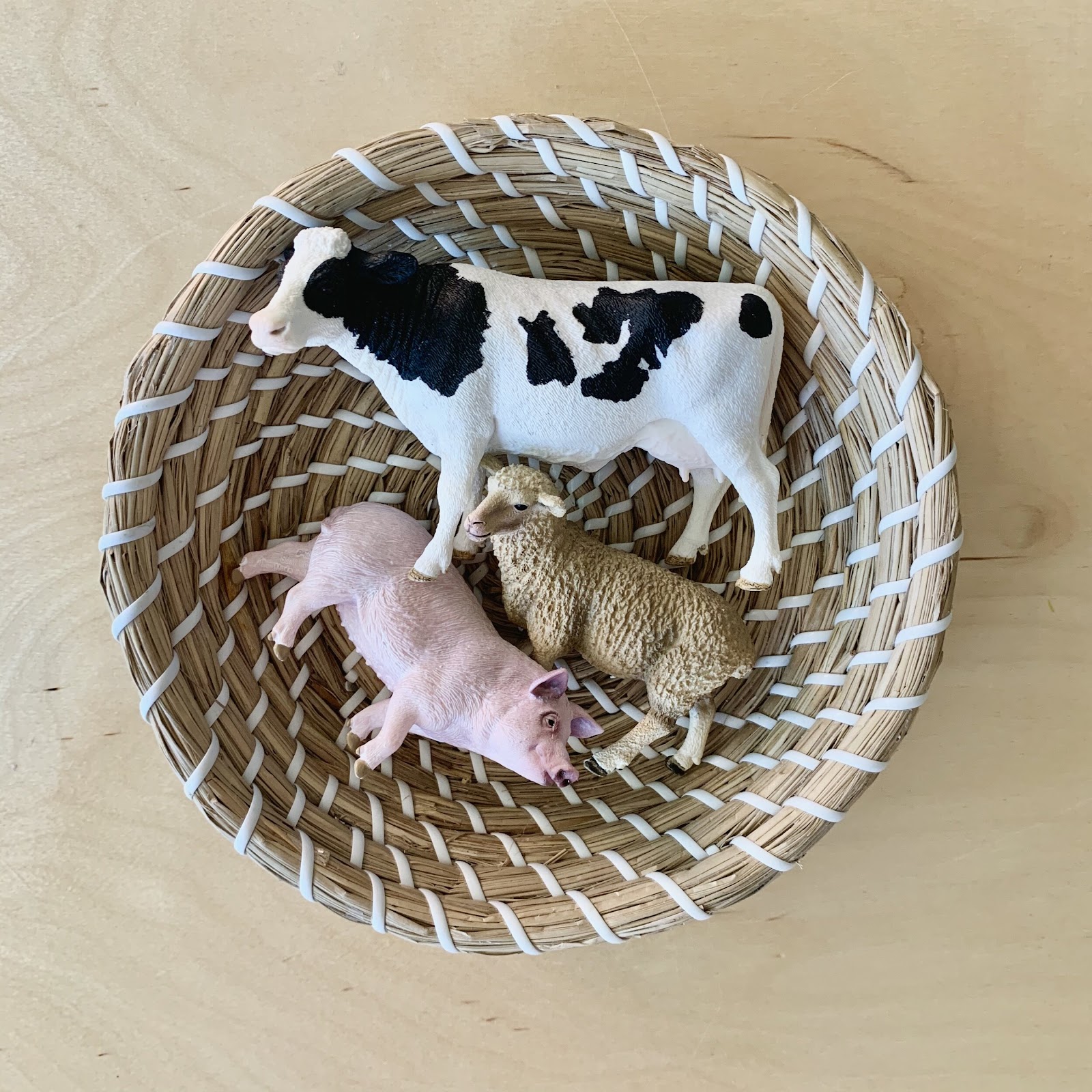
Objects only
First, start by presenting 3-4 replicas or real life instruments in a basket, simply naming the object “this is a cow.” Simple but accurate labels along with exploration of the object. If you are introducing the item and vocabulary for the first time, focus on the word and your child’s exploration of the item, before expanding on more description of the object (“look at the colors, what does it feel like”). Simply label objects as you show them, as they pull them out of the basket to explore and play, and as they get put back in the basket during clean up. Remember that this items-only step is not exclusive to infants, and is a mindful approach for introducing new vocabulary through toddlerhood as well.
Identical matching cards
Next, offer cards for matching to identical images, also working with only 3-4 items at a time in the early stages. You can take pictures of the objects and print them; aim to keep the image small or same size as the object once printed, if possible. It’s not necessary for your child to have full verbal mastery of the objects, but to be able to concentrate, observe as you guide use of the material, and to show an interest in language and the materials you are introducing it with. Follow your child as you determine readiness to introduce this step, sometime between 18 and 24 months.
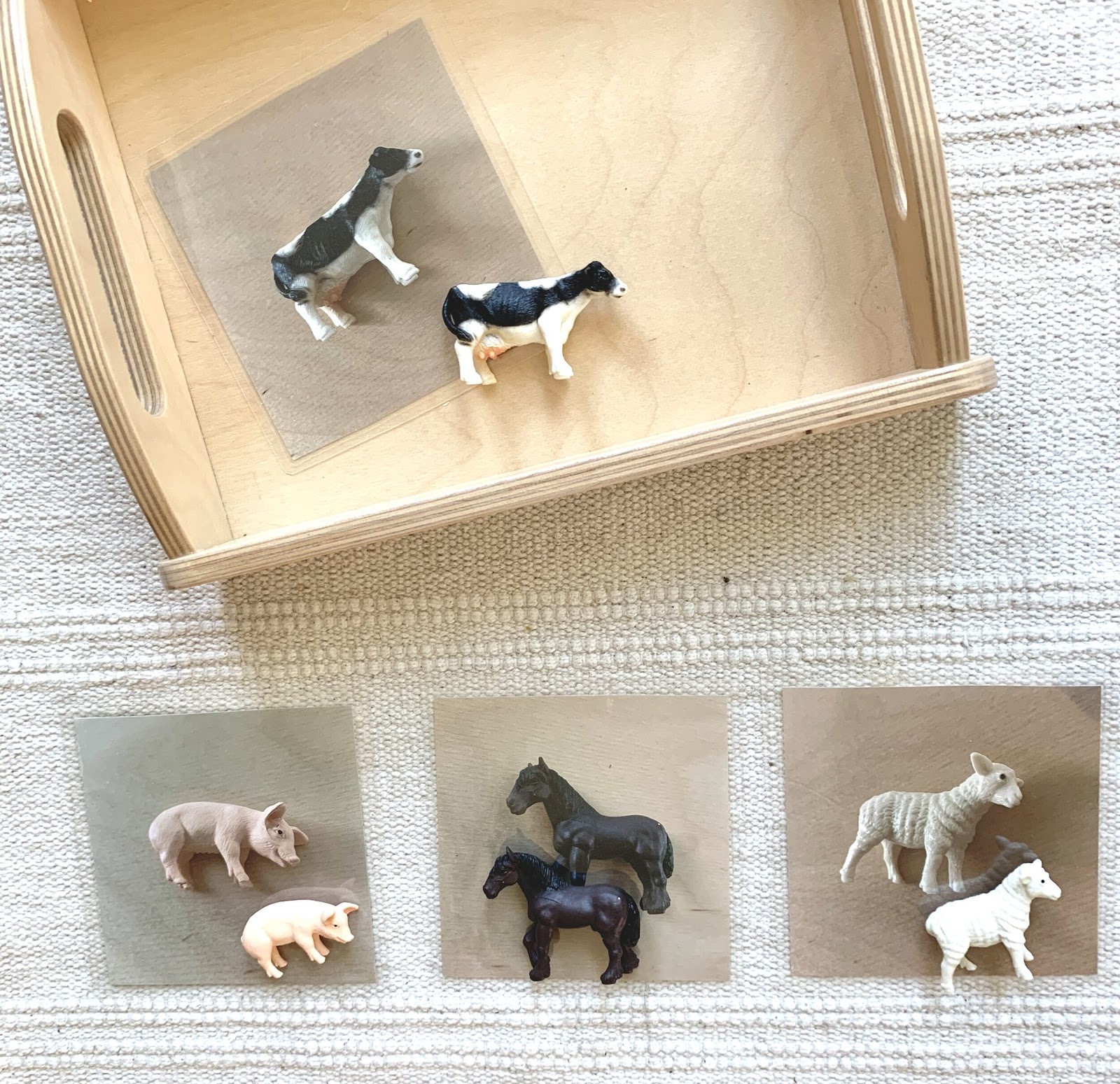
Similar matching cards
After plenty of practice matching to identical images, present replicas an objects to match cards with “similar” pictures, such as a real life picture of the item in its natural context, in use, or a in a different color. Again, follow your child’s lead, interest and knowledge of the items introduced as you consider presenting matching with “similar” pictures.
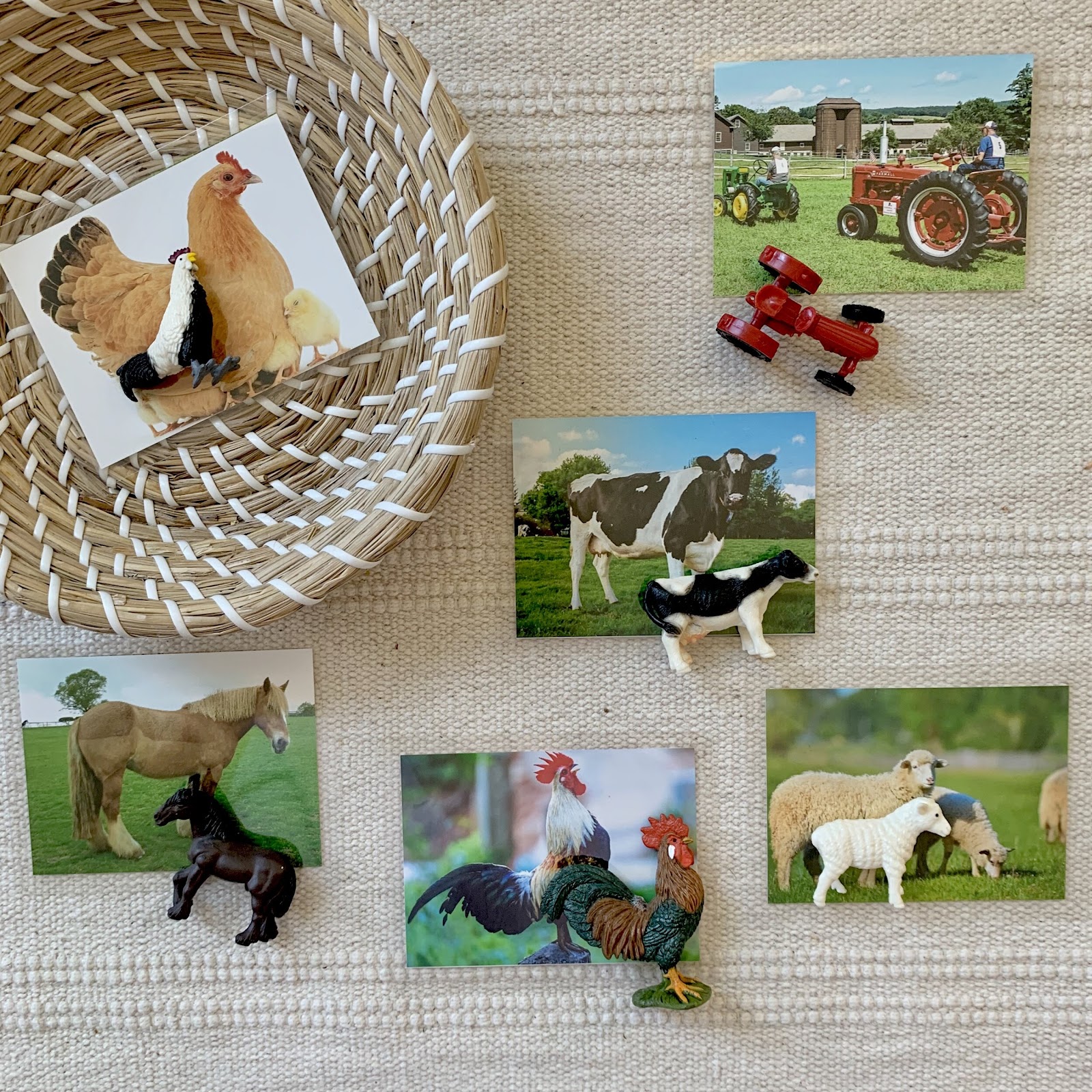
Things To Consider
Group items in categories
Items within the basket should remain in the same category, such as animals categories, instruments, kitchen tools, sea life items, etc.
Items and replicas
We love using replica objects such as theSafari LTD farm animals andSchleich animals pictured here, but don’t forget that you can present vocabulary from items already found in your toolbox, closet or kitchen drawer.
Age appropriate items
With small replicas and objects, always exercise caution and supervision, as with any use oof materials with small parts.
Don’t forget to check—ourFREE printables with pictures from language cards.
10 activities to help develop your
child's speech.
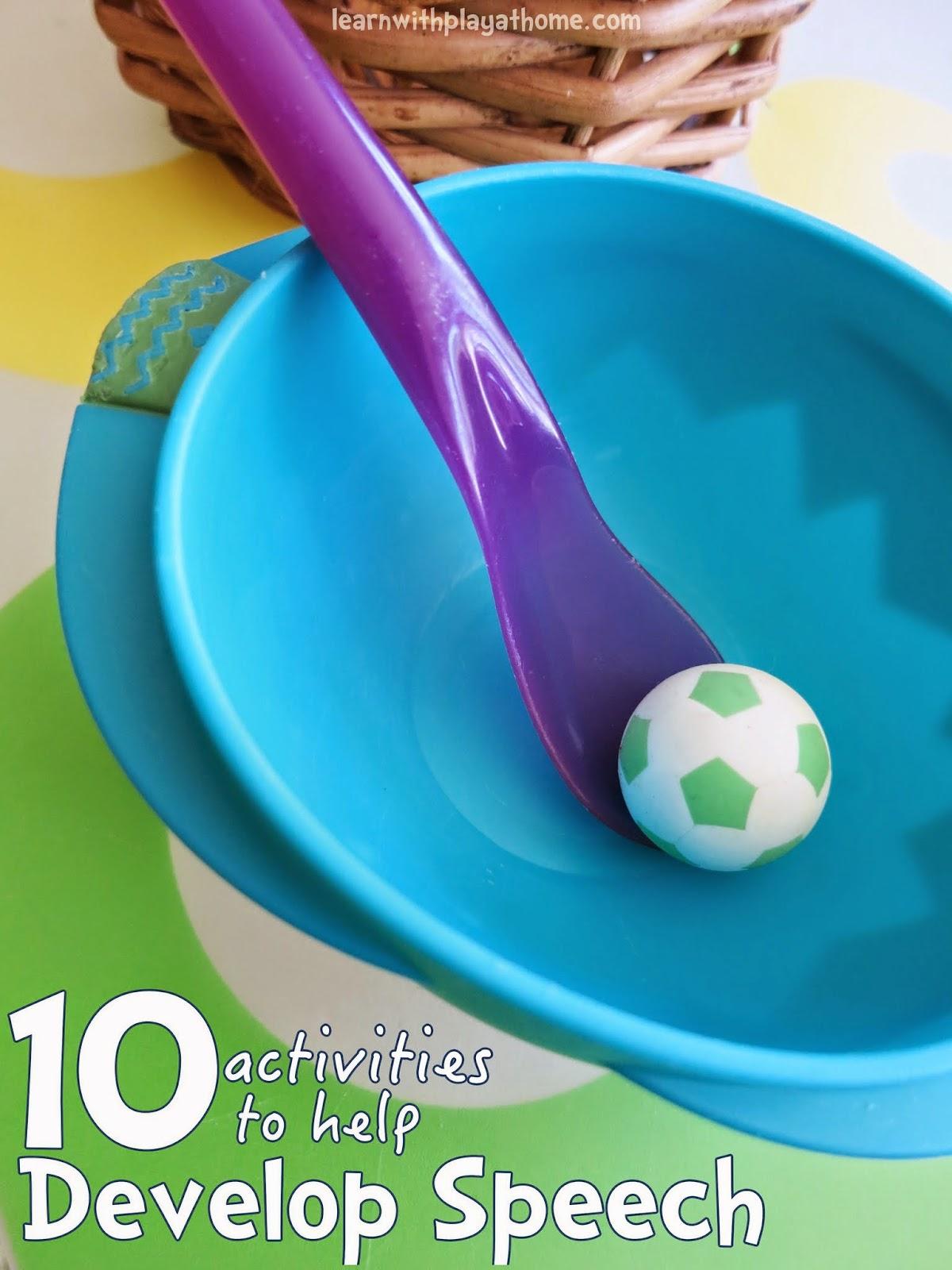
The best way to help a child's speech and language developmentis through play.
Here are 10 simple activities that you can do at home, including the key vocabulary to focus on, to help develop your child's speech and oral language.
The key to these activities is about engaging with the child and using simple, useful language that matches the actions of play.
This puts the language into context with what they are experiencing and gives them opportunities to hear, use and practice the language in a way that makes sense to them.
Often the simple phrases are repeated over and over again in the same activity which is what you want. The words that you can focus on are listed for each activity under "Language" but you can still use them in correct sentence structure whilst focusing on the key words.
For example, "Ball. You have a ball" and "Give ball. Give me the ball please."
For more specific information about how to develop your child's speech through play and to hear our personal journey with oral language concerns, see here.
Ball Play
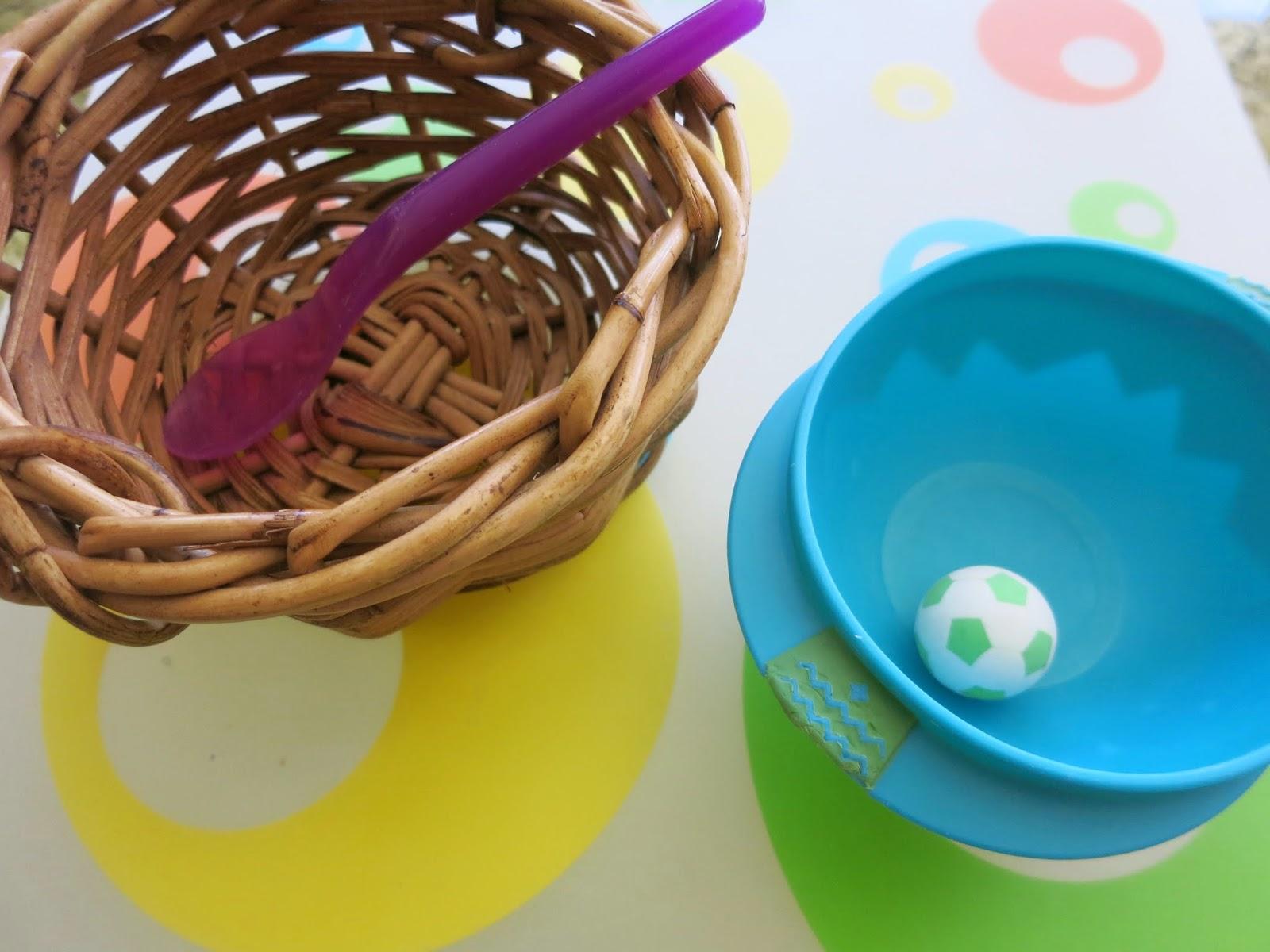
Materials
little ball
bowl
basket
spoon
Language (to match the actions)
throw ball
get ball
give ball please (simple instructions for them to follow)
ball in basket
ball out of basket
ball on floor
ball on spoon
ball fell off spoon
pick up ball
Pasting
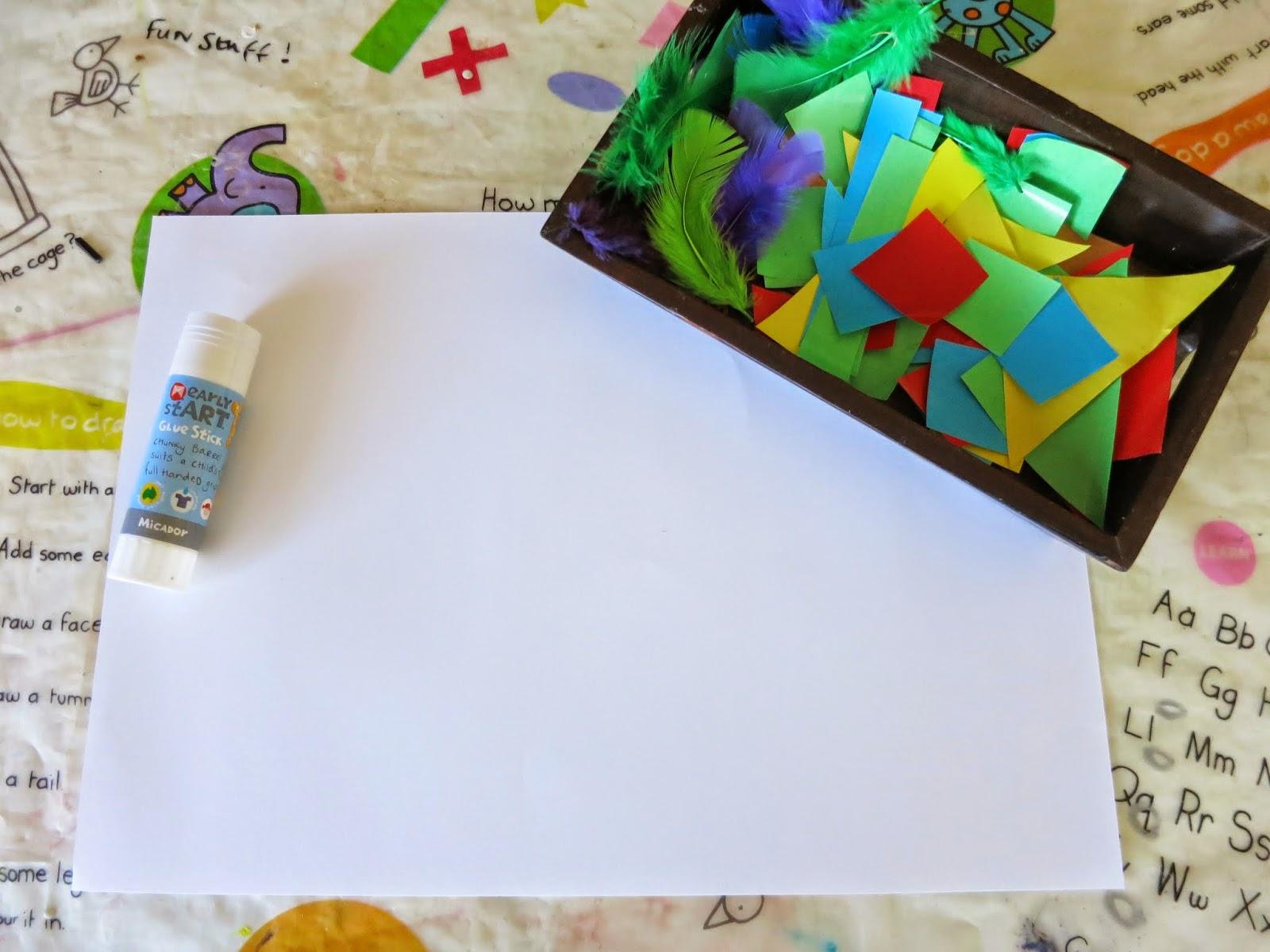
Materials
Glue stick with lid
large sheet of paper
scraps for gluing (paper/felt/feathers etc)
Language (to match the actions)
lid off glue
glue on paper
stick on paper
lid on glue
glue on hand
sticky hand/ your hand is sticky
sticky paper
red/blue/green etc paper (saying colour names as they are used)
put lid on
"Child's name" give lid please (try simple instructions for them to follow)
Trucks and Ramps
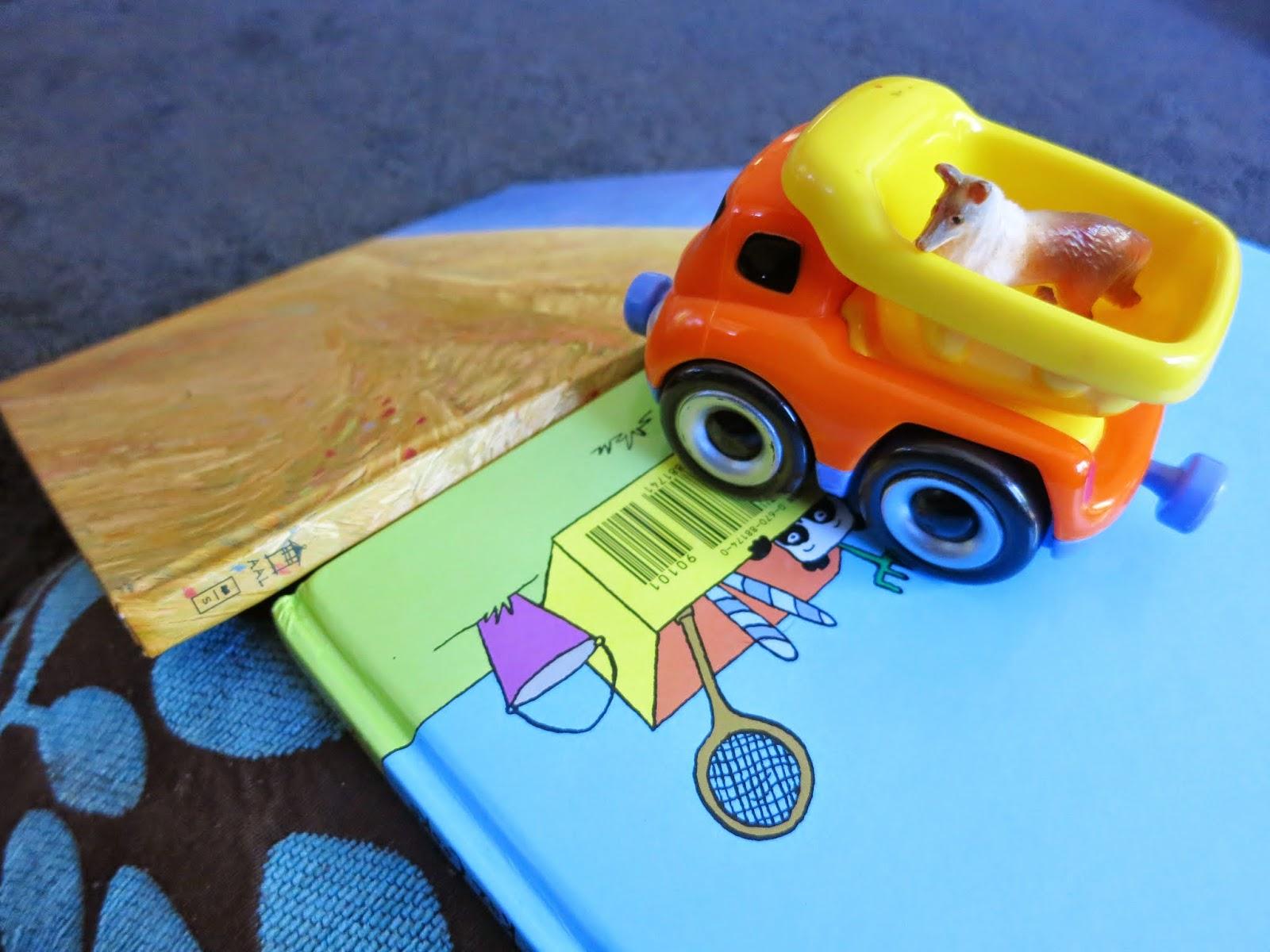
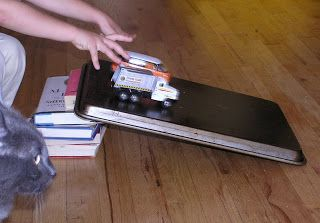
Materials
little truck
ramp (use hard cover books for ramps) or a cookie sheet
small toy animal that will fit in truck/trailer (eg. dog, cow)
Language
Go!
brooooom!
Ready, set, go
Go truck!
truck on ramp
truck go down ramp
truck at top
truck at bottom
"dog" in truck
"dog" out of truck
"dog" on ramp
"dog" on floor
put dog in truck (simple instructions for them to follow)
Making a Snack
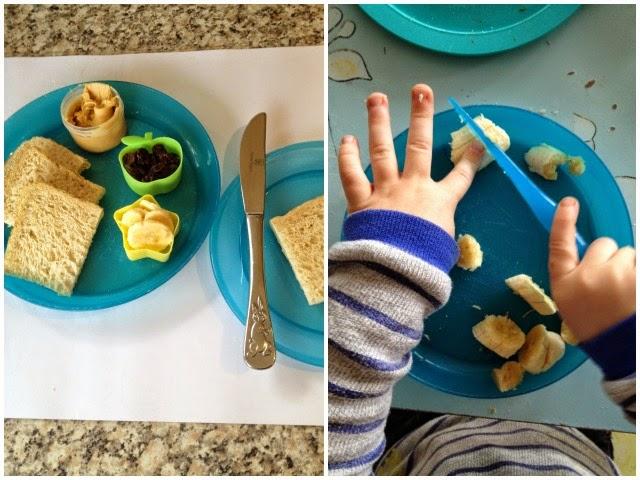
Instead of preparing a snack for your child, provide materials for them to make their own snack and then use the language that naturally goes with the processes.
Materials
Little containers
fruit (eg. banana, strawberries)
plastic knife
savory cracker
spread (eg. cream cheese, peanut butter)
sultanas
plate
Language
yummy
eat food
hungry
snack time
cut up banana
peanut butter on cracker
put in container
more?
you like?
3 sultanas. 1, 2, 3.
strawberry on plate
strawberry off plate
in mouth
Pom-pom Play
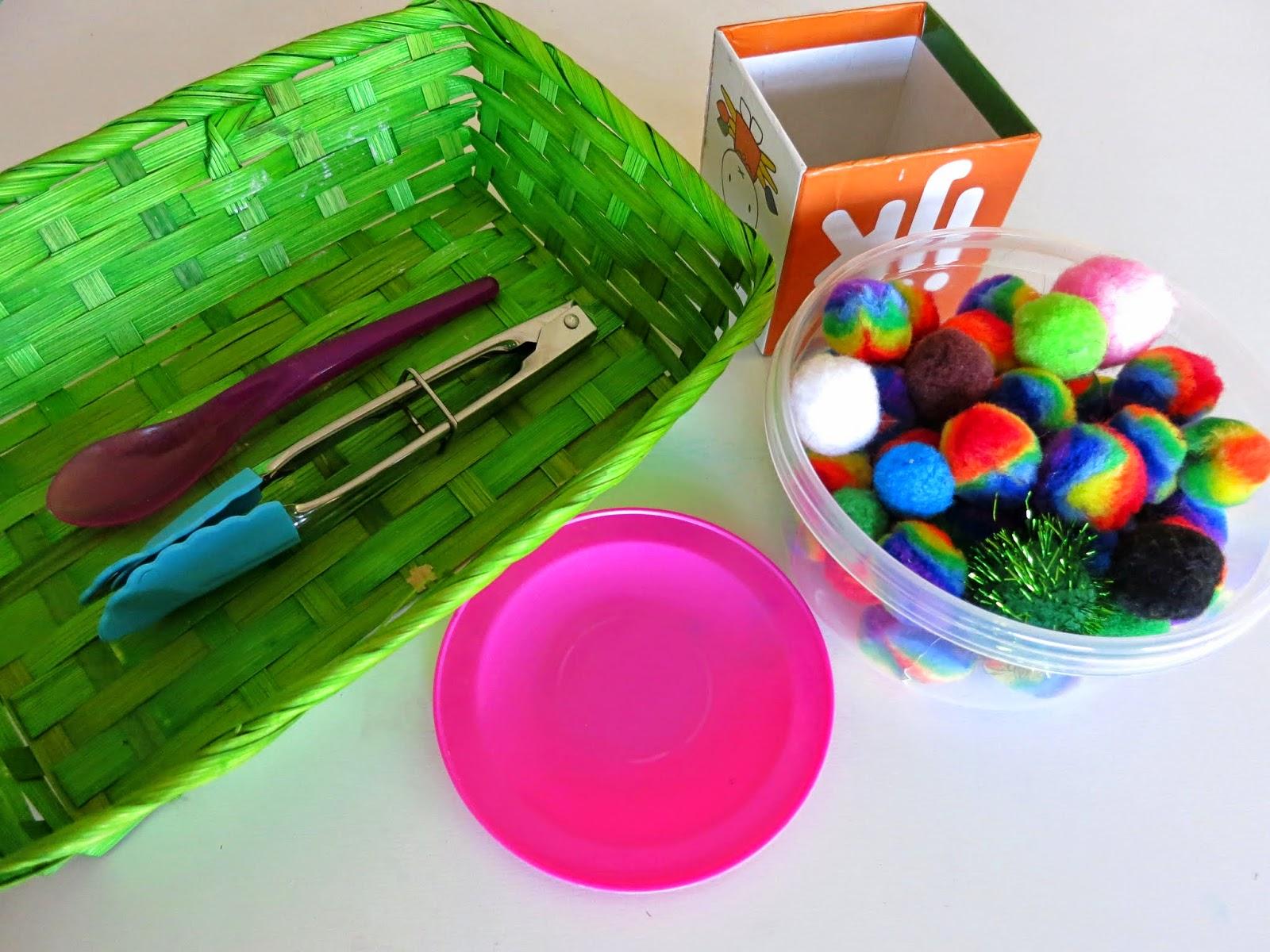
Materials
pom-poms
basket
box
plate
spoon/tongs
Language
pom-poms on floor
pick up pom-poms (can use simple instructions for them to follow)
pom-poms in basket
pom-poms in box
pom-poms on plate
pom-poms off plate
pom-pom on spoon
"red" pom-pom
3 pom-poms. 1, 2, 3
more
all gone
tip pom-poms
Ring-Ring
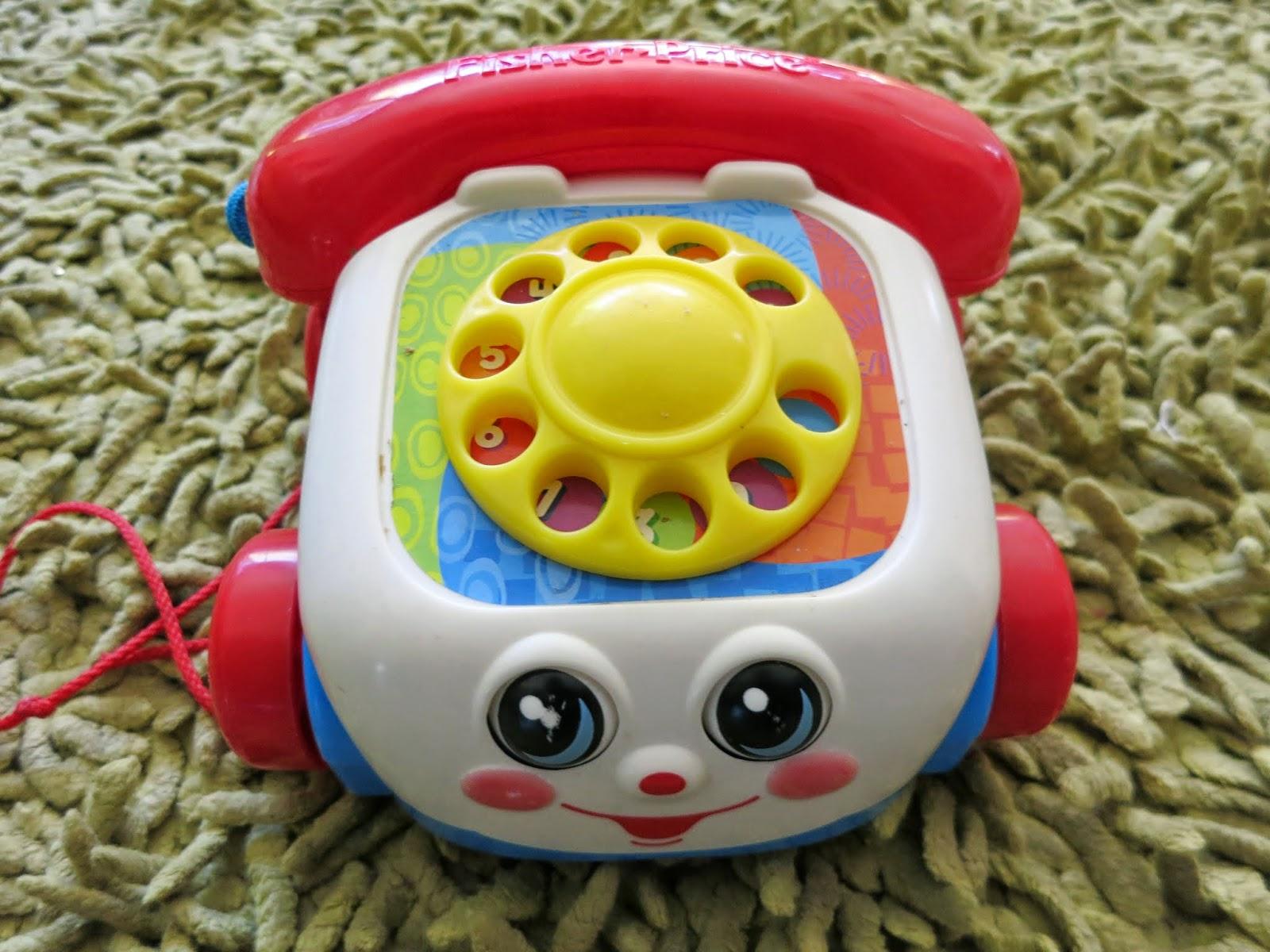
Materials
toy phone
Language
hello
yes
thanks
ok
press buttons
ring-ring
who's there?
bye
Mama, Daddy, Nanna, etc.
Let's build
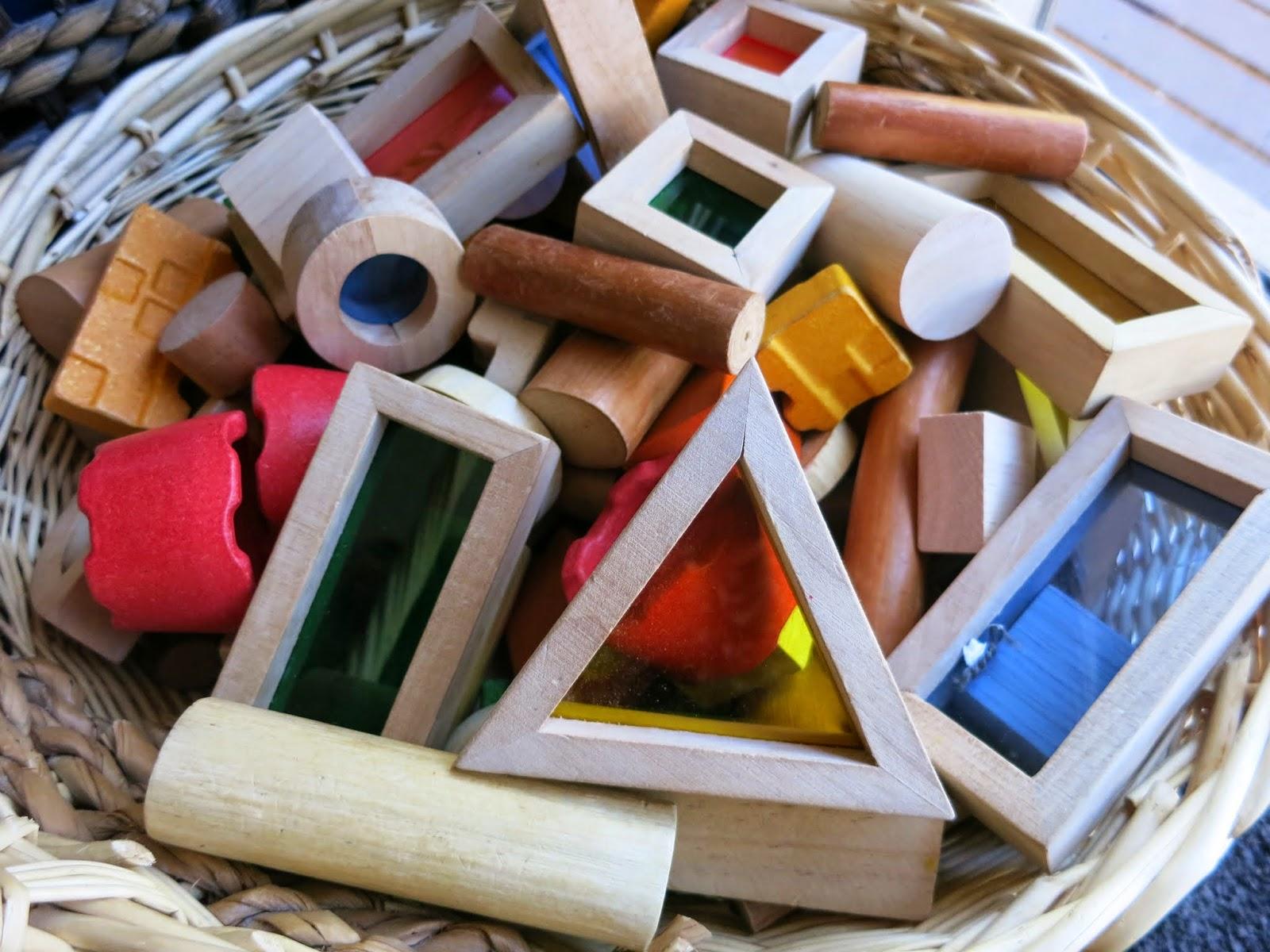
Materials
variety of different blocks (shapes, sizes, colors etc)
Language
build up
block on top
put on
fall down
big tower
tall tower
very tall
put block on (following simple instructions)
big block
little block
"red" block
more
Animal Tracks
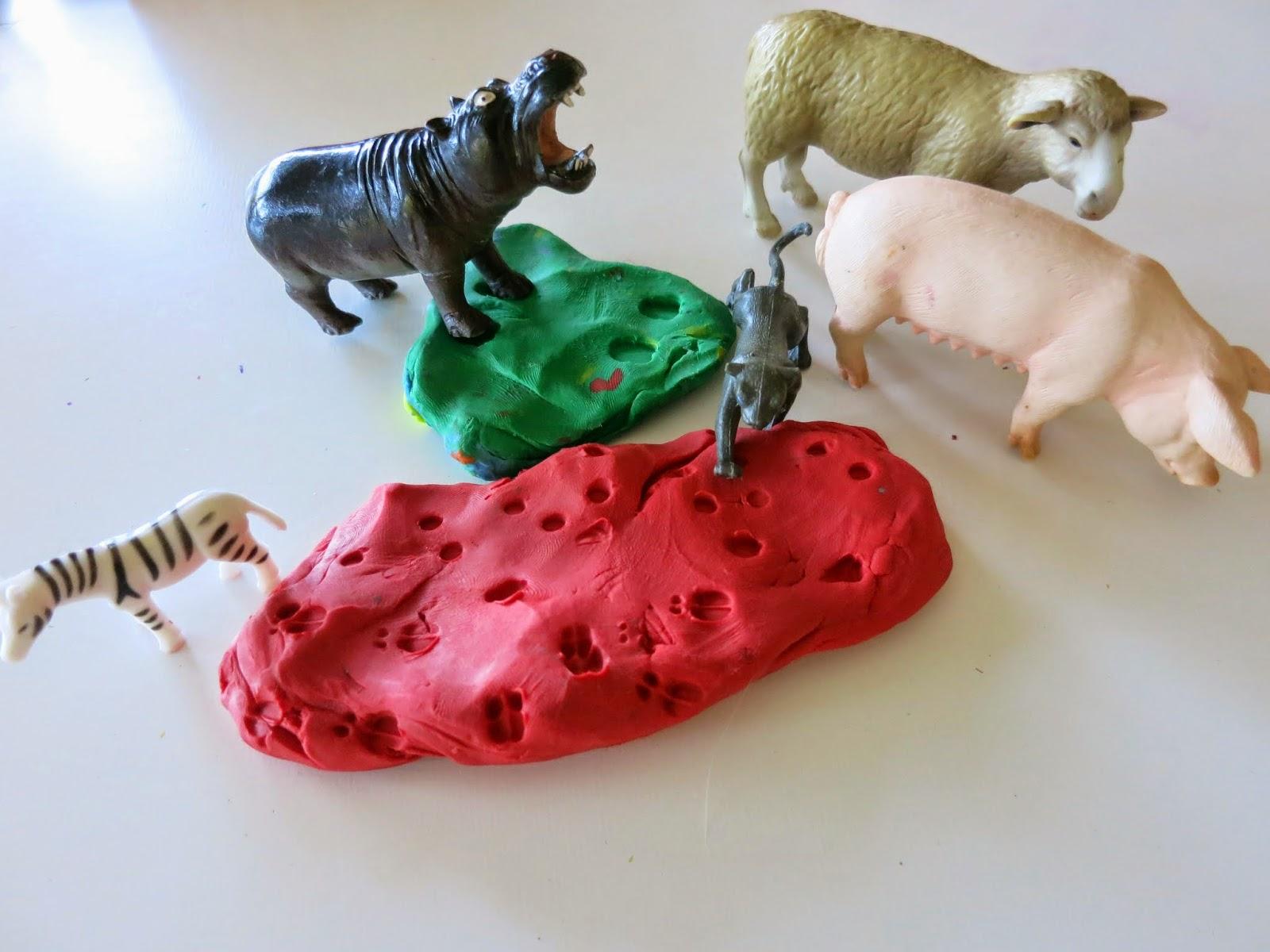
Walking plastic animals over clay/playdough to leave footprint impressions. Focus the language on the movements and animal sounds.
Materials
clay/playdough
plastic animals
Language (match the actions being used)
roll clay
squishy clay
kangaroo jump/ jump jump jump
marks in clay
footprints in clay
more?
snake slither/ sssssss
frog jump/ jump jump/ ribbit ribbit
lion roar/ roaaaaar
animals walk
walk on clay
I'm a Chef
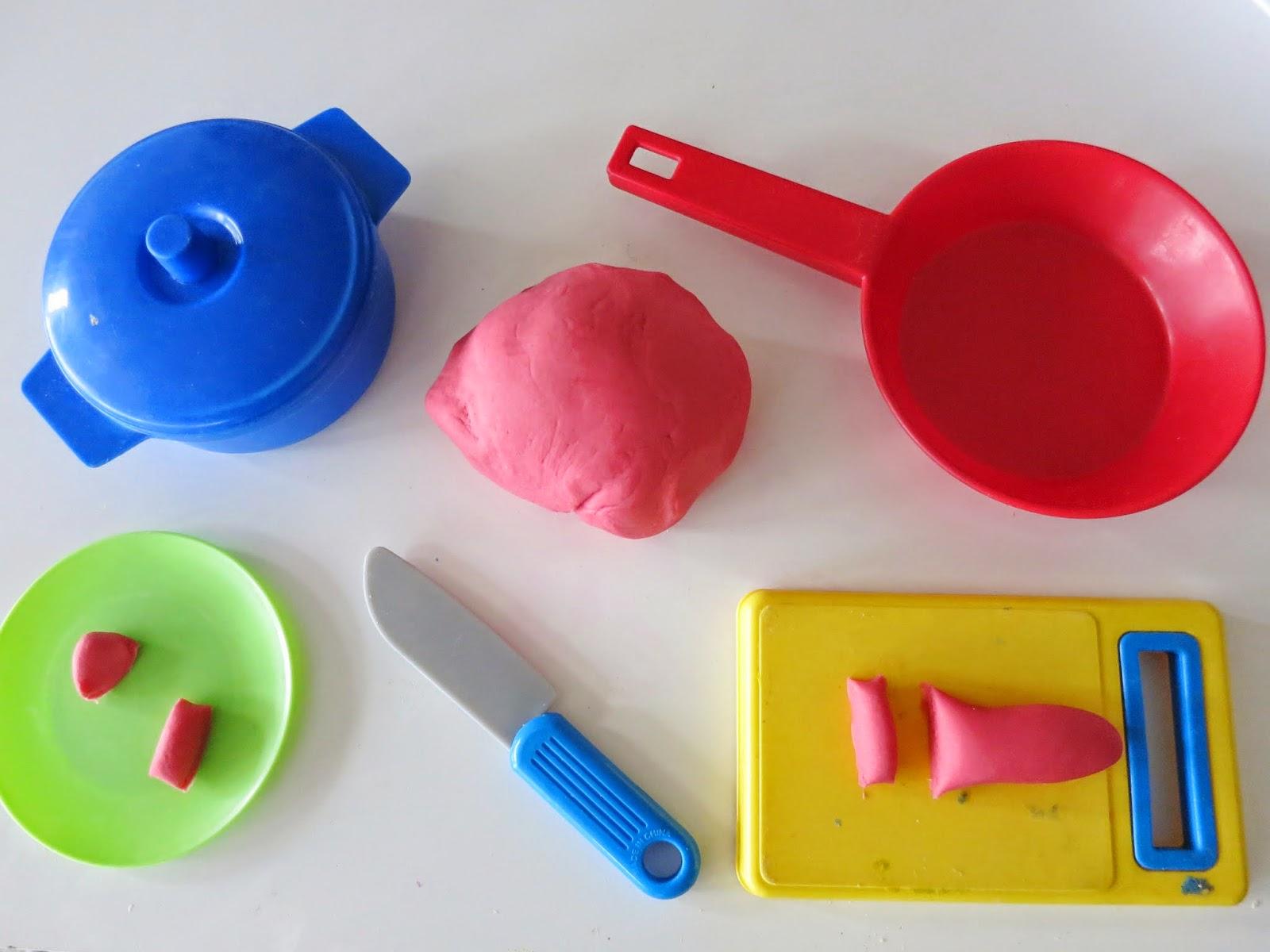
Pretend cooking play using playdough and various kitchen implements. You can roll some sausage shapes etc. to help encourage other actions that allow you for other language use.
Materials
playdough
plastic pot w/ lid
plastic frying pan
plastic knife
plastic plates
Language
cut "playdough" (or, "sausage/carrot" etc.)
roll playdough
in pot
out of pot
in pan
out of pan
lid on pot
lid off
on plate
more?
no more
all gone
yummy
what are you making?
Sandpit Play
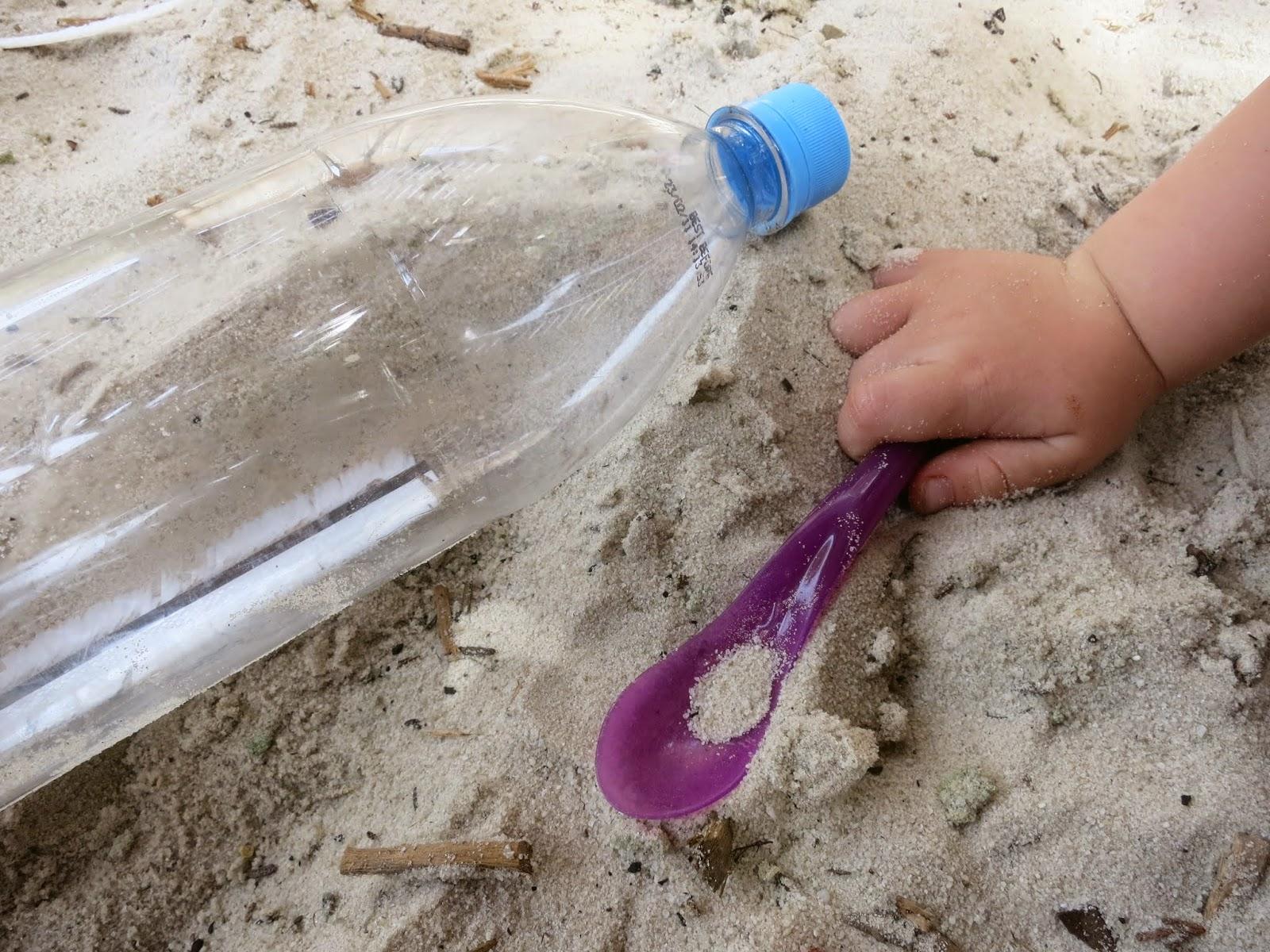
Sensory play is great for young children and for developing language. Children are able to match what they are seeing/hearing/smelling/touching or tasting with the words that go with the sensory experience. This makes the experience very tangible for them.
Materials
sand
plastic bottle with lid
spoon
Language
lid on bottle
lid off bottle
sand in bottle
scoop sand
pour sand
give spoon
tip sand
empty bottle
sand all gone
sand on spoon
Handy Tips:
- Generally, just asking my child if they would like to play with me is enough to entice them to participate in some one-on-one time, however if they are hesitant (code for, my toddler wants to do what he wants to, not what I want him to) I will get out the materials and start playing with them myself. The more fun I'm having on my own, the more they usually want to join in.
- If your child really isn't in the mood for your planned play, I wouldn't force it. Instead, try to find a way to engage with what they are interested in playing and try and use and encourage them to practice the language that naturally comes with that activity.
- Read my tips on the best way to approach these one-on-one play times with your child.
- It is very important to allow your child time to respond to any questions you ask and for them to attempt to use or mimic the language.
Encourage and praise their attempts at oral language.
- You will most likely find, during the course of your one-on-one play, that other language (other than what's listed above) naturally occurs due to the direction that your play takes.
This is of course perfectly fine. Just try and keep the language short, clear, relevant and useful during this time. Repetition is important.
- There are lots of great
kids books that encourage speaking and making sounds
. A favorite of ours is, "Mr Brown can Moo. Can you?" by Dr Seuss.
Easy And Interactive Themes
All About Themes For Speech Development
Kids thrive when therapy feels like a fun adventure rather than a task they have to complete.
Want to know one of the most effective ways to do this? Speech therapy themes! Incorporating a fun and unifying theme into your plan, it can turn even the most routine sessions into exciting, memorable experiences.
To help, we’re taking a closer look at speech therapy themes while providing creative and engaging ideas for any sessions. Whether you’re a therapist, a parent, or a caregiver trying to make speech therapy more fun, this guide will give you a wealth of inspiration to use every single day.
What Are Speech Therapy Themes?
Speech therapy themes are any broad, creative topics you can base therapy activities on. It serves as the central idea for a set of exercises, games, or lessons that revolve around a particular subject. Themes can be seasonal, animal-related, or based on a child’s favorite topic, such as outer space, pirates, or superheroes. The idea behind using a theme is to tie together different speech therapy objectives into a fun, cohesive package.
For example, if your theme is “the ocean,” you might use games, flashcards, and books about sea creatures to work on a variety of skills such as articulation, language comprehension, or social communication. The theme not only helps to keep the child engaged but also provides structure to your therapy sessions, making them more predictable and exciting.
By integrating fun topics into your lessons, you make speech therapy feel like less of a chore and more like an enjoyable activity. What’s more, you can tailor these themes to a child’s interests, which increases their motivation and enthusiasm.
How Do Themes Help with Speech Development Sessions?
Incorporating a theme into a speech therapy session has many benefits. Here are a few reasons why speech therapy themes are so effective:
Increased Engagement
Children, especially younger ones, can lose focus quickly if they’re not interested in what they’re doing. By using a theme that piques their interest, you can keep their attention for more extended periods, making them more likely to participate and retain information.
Encouraging Creativity
Themes enable a wide range of creative activities that can be tailored to various speech therapy goals. From storytelling to arts and crafts, incorporating creativity into therapy sessions lets children feel like they are having fun while simultaneously working on their speech and language skills.
Promoting Social Interaction
Some themes lend themselves well to group activities or role-playing scenarios, which can help children practice social communication. Themes such as “superheroes” or “pirates” can encourage turn-taking, sharing, and using appropriate social cues in a natural context.
Variety and Structure
Having a theme provides structure to a session while still offering a variety of approaches to achieve speech therapy goals. For example, one session might include storytelling, another could involve games, and yet another might focus on identifying and naming objects related to the theme.
Supporting Vocabulary Growth
Themes are a fantastic way to introduce new vocabulary words in a context that makes sense to the child. For example, a space-themed session might introduce words related to the planets, stars, and space travel. This helps children learn words in a meaningful way rather than just memorizing a list of unrelated terms.
Building a Sense of Accomplishment
As children work through various themed activities and tasks, they can gain a sense of accomplishment. Completing activities related to a fun theme can boost confidence and encourage children to continue progressing in their speech therapy journey.
How to Use Themed Articulation
Word Lists in Speech Development
Speech development should be meaningful and motivating.
Do you agree?!
One way we can make practicing articulation in speech development meaningful is to choose words that are related to the theme and activity that we are doing (what four year old says the word, “thimble”??). Using speech sound targets that are related to the theme will help you easily incorporate words into any of your themed speech development activities - books, games, songs, and toys! You can use these tips during speech development with preschoolers, toddlers, or school aged children.
Here are seven easy ways you can use themed articulation word lists
Pair with a quick themed turn taking game for lots of practice.
Write your target words on a sticky note and have them handy when playing with themed toys. Sometimes I like to think of how I will elicit the words in play before the session (for more information about how to elicit speech sounds in play, check out this blog post).
Give your student’s teacher target words to practice that are part of a theme being used in the classroom.You can even encourage the teacher to write them on the whiteboard/smart board to remember to use them!
Use a themed picture book to go on a picture scavenger hunt for your target words.
Send it to parents to use during home speech development activities! It is much easier for parents to practice speech sounds if the words are naturally occurring in everyday conversation!
Mix up the word lists! Read words from different lists and have the child say the word and then tell you if they are part of your theme or not. You can ‘keep’ the words that are part of your theme and use them in a later activity.
Choose a few target words before a session and try to plan activities that feature those words.e.g. t with a pet theme -> choose pet, cat, and sit to play with a toy store and cats). When your play activity is already loaded with the target sound, the child will have so much fun PLAYING they won't even know they're practicing!
If you're looking to save yourself time from brainstorming themed words - I got you!
I created theseThematic Articulation Word Lists that you can simply print and use!
They are sorted by phoneme, so you can save time and energy and head into your sessions confident that you will be able to practice words in a functional and meaningful way.
To use themes for toddler speech development, select a broad topic—such as animals, transportation, or seasons—and integrate it into every part of their play and routine. This approach builds a meaningful context that helps toddlers connect new words to familiar concepts.
1. Select an Engaging Theme
Choose topics based on the child's natural interests or daily life to increase motivation.
Familiar Routines: Bath time, eating, or sleeping.
High-Interest Topics: Farm animals, dinosaurs, vehicles, or "under the sea".
Seasonal relevance: Holidays like Halloween, or weather changes like snow in winter.
2. Gather Multi-Sensory Materials
A "true" themed approach goes beyond just graphics; the actual activities must center on the topic.
Books: Use both fiction and non-fiction. For a farm theme, point out animals and imitate their sounds (e.g., "moo," "baa").
Sensory Bins: Fill a bin with theme-specific items. For a beach theme, use sand and plastic sea creatures to build vocabulary and practice following directions.
Songs and Movement: Use repetitive songs with actions, like "The Wheels on the Bus" for a transportation theme, to help toddlers mimic words.
Props and Toys: Use physical objects like toy rockets for space or mini-figurines for a zoo theme to make the topic immersive.
3. Implement Speech & Language Targets
Use the theme to sneak in specific speech goals during natural play.
Vocabulary Building: Introduce new nouns (cow), verbs (jump), and prepositions (in the barn) related to the theme.
Articulation Practice: Use a "Themed Word List" to target specific sounds. For example, if working on the /s/ sound during a food theme, practice words like "soup" and "sip".
Pretend Play: Act out sequences with a beginning, middle, and end, such as "cooking" a meal or "caring" for a sick stuffed animal.
Repetition: Stick with one theme for 2–5 weeks. Constant exposure to the same vocabulary across different activities helps toddlers retain and generalize new skills.
For visual examples of how to structure a themed session with a toddler:
30 Ideas for Creative Speech Therapy Themes
Here are some fun and themed ideas anyone can use to enhance therapy sessions. Whether you’re working on articulation, language skills, or social interaction, there is a theme to suit every goal.
1. Space Exploration
Blast off into space and talk about astronauts, planets, stars, and rockets. This theme is perfect for practicing vocabulary and prepositions.
2. Dinosaurs
Bring the prehistoric world to life with dinosaurs. This theme is excellent for teaching big and small, as well as colors and actions like “roar,” “stomp,” and “chomp.”
3. Princesses and Princes
Royalty-themed therapy activities can help work on following directions, storytelling, and pretend play.
4. Animals
From farm animals to jungle animals, animals are an evergreen theme for practicing animal sounds, names, and action words.
5. Under the Sea
It is a classic theme that introduces sea creatures, underwater environments, and vocabulary words related to water, colors, and textures.
6. Seasons
Spring, summer, fall, and winter offer endless possibilities for theme-based activities focused on weather, clothing, and nature.
7. Superheroes
Let your clients take on the role of their favorite superhero while working on articulation and social communication skills.
8. Pirates
Ahoy matey! Pirates are perfect for practicing “arr,” “shiver me timbers,” and other fun phrases, along with action verbs and storytelling.
9. Transportation
Planes, trains, and automobiles — transportation-themed activities are fantastic for teaching vocabulary related to movement, directions, and places.
10. Construction
Dig into the building with a construction theme. Talk about tools, machines, and construction sites while practicing sequencing and action verbs.
11. Fairy Tales
From “Cinderella” to “Little Red Riding Hood,” fairy tales are great for teaching sequences of events, new vocabulary, and moral lessons.
12. Food and Cooking
Who doesn’t love food? Whether you’re talking about fruits, vegetables, or meals, the food theme is ideal for teaching naming, categorizing, and adjectives.
13. Mythical Creatures
From dragons to unicorns, mythical creatures spark imagination and enable role-playing, storytelling, and the practice of descriptive language.
14. Holiday Themes
From Christmas to Halloween, holidays are perfect for reinforcing seasonal vocabulary and concepts. Think decorations, traditions, and celebrations.
15. Weather
Rain, snow, sunshine — explore the changing weather while working on adjectives, sequencing, and descriptive language.
16. Outer Space
Similar to the space theme but more focused on astronauts, moon landings, and space travel, making it perfect for a vocabulary boost.
17. Safari
Go on a safari to talk about wild animals, landscapes, and safari adventures while focusing on pronunciation and naming.
18. Robots
Bring technology into the picture with a robot theme. Work on problem-solving language, sequencing tasks, and following complex directions.
19. Monsters
Monsters are fun for drawing, storytelling, and practicing sounds. Think about the goofy noises they make and how they move.
20. Insects
Bugs and insects can be a great way to introduce fun action verbs, such as “buzz,” “crawl,” or “fly,” as well as environmental vocabulary.
21. Sports
Sports are a wonderful way to incorporate action words, turn-taking, and social interaction through games like soccer, basketball, or even the Olympics.
22. Under the Big Top (Circus)
The circus theme is perfect for learning about different characters, including clowns, acrobats, and animals, while practicing descriptive language and emotions.
23. Farm Life
Go on a trip to the farm to learn about animals, crops, and daily routines while using descriptive language and categorizing terms.
24. Haunted House (Halloween)
If you and your kiddos are looking for some spooky fun, the haunted house theme is great for using creepy adjectives and practicing storytelling.
25. Space Pirates
Mix space and pirates for double the fun and a chance to work on vocabulary related to both worlds.
26. Beach
A relaxing beach theme offers a chance to talk about the ocean, sandcastles, beach toys, and more while working on sensory descriptions.
27. Camping
Camping involves a variety of activities and items — such as tents, campfires, and marshmallows — that are ideal for teaching specific action verbs and concepts.
28. Jungle Adventure
Take a trip to the jungle to talk about the animals, trees, and sounds you might encounter while reinforcing vocabulary and social skills.
29. Zoo
A zoo theme is a fantastic way to talk about the diversity of animals while reinforcing naming, categorizing, and action words.
30. Nighttime
Explore the world after dark, using vocabulary related to the moon, stars, bedtime routines, and nocturnal animals.
Tips for Integrating Themes into Your Speech Therapy Lessons
If you want to put these exciting speech therapy themes to work, here are some tips on how to effectively integrate them into your therapy plans.
Incorporate Visuals and Props
Props are essential for bringing speech therapy themes to life. You can use themed flashcards, toys, pictures, and even simple drawings to engage the child in the topic. For example, if you are focusing on a space theme, you could bring in toy rockets, astronaut figurines, and images of planets.
Adapt to Individual Needs
While a theme can provide structure, remember that every child has different needs. Tailor the level of complexity for each child’s individual speech goals. Some might focus more on vocabulary building, while others might work on pronunciation or sentence formation.
Make Use of Multi-Sensory Learning
Children often learn best when they can engage multiple senses. For a “sea life” theme, you might bring in ocean-scented air fresheners, create textured sea creature cutouts, or have children engage in water play. This will make the theme more immersive and memorable.
Use Storytelling
Storytelling is one of the most powerful tools in speech therapy. Incorporating a theme like pirates or princesses into a storytelling activity encourages creativity while promoting speech practice, especially if you prompt the child with questions like, “What do you think happens next?” or “How does the princess feel?”
Consistency and Routine
While themes are fun, it’s also important to maintain consistency in your therapy. Always include familiar activities, such as a warm-up or review session, but integrate them into the theme effectively. This gives the session structure while still keeping it exciting.
Incorporate Interactive Games
Games are a great way to keep things engaging and entertaining. Utilize board games, card games, or digital tools that relate to your theme. For example, a “dinosaur scavenger hunt” game, where children have to find various dinosaurs around the room, can teach new vocabulary while keeping them moving and engaged.
Work Into Everyday Routines
Themes can easily be incorporated into daily home routines. Suggest activities related to the theme for parents or caregivers to work on outside of therapy, like asking children to describe animals they see in a book or using action words during playtime.
Making Speech Therapy Engaging and Fun
Speech therapy themes are a powerful tool for increasing engagement, creativity, and progress in therapy sessions. By incorporating fun, personalized topics like animals, seasons, or outer space, you create an environment where children are more likely to participate, learn, and grow. The key is to make therapy sessions feel like an exciting adventure — one where speech and language skills develop naturally through play, exploration, and interaction.
Whether you’re a therapist, a parent, or a caregiver, speech therapy themes are a great way to bring more fun and focus to each session. The team at Care Options for Kids believes that by making therapy fun and engaging, we can help children and families reach speech milestones while encouraging therapists to pursue rewarding and fulfilling careers.
So, why not start planning your next themed session today? The more creative and immersive you get, the more progress your kiddos make!
To build speech with play themes, choose engaging themes (like bakery, zoo, or space), use relevant toys/props, and embed language goals naturally by modeling, narrating, asking open-ended questions, and setting up scenarios (like "tea parties" or "grocery store") that require communication, focusing on themes, repetition, and following the child's lead to build vocabulary, social skills, and sentence structure in a fun, low-pressure way.
1. Choose Your Theme & Materials
Broad Themes: Start with broad themes like "Food," "Animals," "Transportation," or "Colors".
Gather Resources: Find a book, toy, game, and sensory bin related to the theme (e.g., farm animals, plastic food, hay/feathers).
Incorporate Senses: Add multi-sensory elements, like scented playdough for a "bakery" theme or water play for "sea life".
This video shows how to use pretend play themes to build speech:
Teachmetotalk YouTube • Mar 4, 2022
Model & Narrate: Talk about what you're doing and what the child is doing (e.g., "Wow, you're chopping the apple!").
Vocabulary Building: Introduce new words related to the theme ("Look at the astronaut!" or "Let's stir the soup").
Asking Questions: Ask "Wh-" questions (Who, What, Where, When, Why) and offer choices, keeping a 3:1 comment-to-question ratio.
Action Words & Phrases: Practice verbs (run, jump, open, close) and simple phrases (e.g., "I want more," "Let's share").
You can also watch this video to learn how to use action words in play:
The Gift of Gab Speech Therapy YouTube • Oct 7, 2024
Role-Playing: Set up pretend scenarios like a tea party, grocery store, or doctor's office to practice social language (please, thank you, I need help).
Hold Back: Give a toy or food item in small amounts and wait for the child to request more, prompting words or sounds.
Repeat & Reinforce: Repeat words and phrases often in different contexts within the theme to build familiarity and confidence.
Follow the Child's Lead: Let the child's interest guide the activity, as this increases motivation and participation.
This video demonstrates how pretend play can help with language development:
Emerge Pediatric Therapy YouTube • Apr 5, 2022
4. Structure the Session (Optional)
Start with Drills: Briefly do structured drills (e.g., 5 mins) for specific sounds, then transition to natural play.
Mix Activities: Combine a book, a movement activity, a sensory bin, and a structured game within the theme.
BABY READY TO GO PLAY THEMES
Are You Excited to Try Play Based learning?
My granddaughter wants to learn about everything, Its really cool to watch a child invent how to play with just anything like it is meant for play. The boys were great at this but Hope could really get inventive. Even to this day she invents new uses for what she has at home in a matter of seconds. Which is great as a new mom. Sky will surely gain that skill just by living with her.
Now you may wonder where to start. I live amongst Amish families and they give me the best answer… teach what they want to learn and need to learn in everyday life. Parents and educators can use the known preferences and interests of the child and what is relevant to their daily life as a start. They work on physical strength and coordination the first year. Then move into communication and life skills as a second year long priorities. Allowing daily life to provide the opportunity and pace in learning about home environment and family life. Allowing a lot of time (90%) for unstructured play and exploration on their own.
Baby Bins are designed specifically for the 12-24 month old child. Every activity can be used at home with one or more children or adapted for use in a day care/preschool classroom.
Baby Bins are all about exploring and learning together while exposing children to rich language, fine motor skills, sensory learning, and a variety of basic concepts. All activities have been designed as taste safe (but not always TASTY) for curious little learners that still put everything in their mouths.
Here is the most current calendar of baby bin themes:
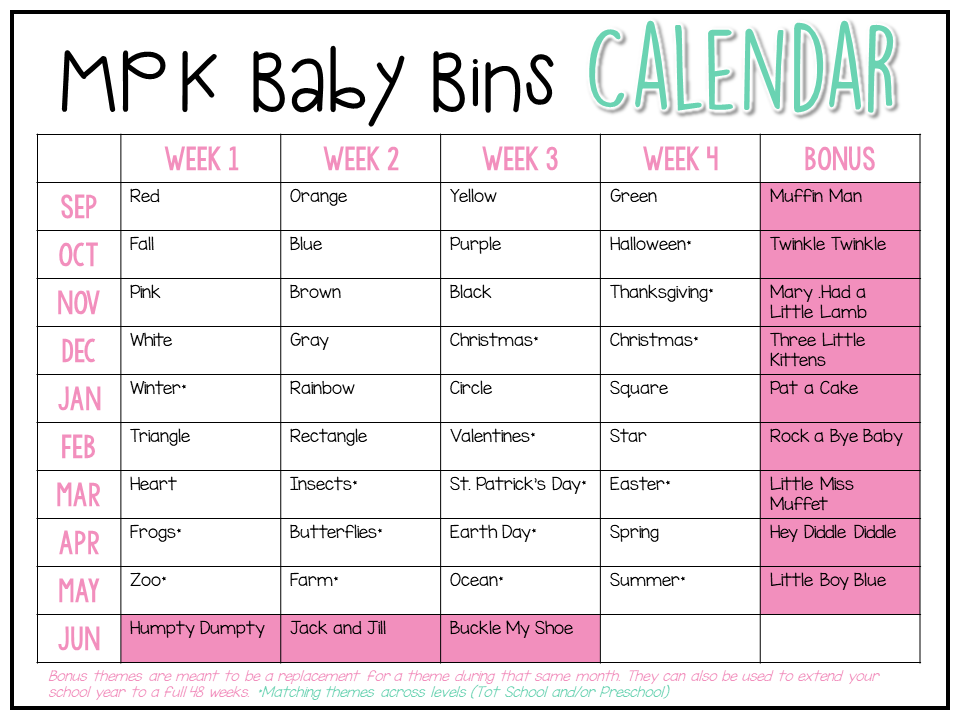
Click the
See all of our baby activities in action in our themed blog posts! Each theme consists of 5 engaging activities and one 5 book suggestion for each unit. Activities include a mix of fine motor, gross motor, and sensory bin/sensory play suggestions every week.
BABY BOOK BASED BINS & COLOR THEMES
Red , Orange , Yellow , Green , Blue , Purple , Pink , Brown , Black , White , Gray , Rainbow
Links for Shape Baby Book Based Bins & Activities
Circle , Square , Triangle , Rectangle , Star , Heart
BABY PLAY: BOOKS BASED BINS AND ACTIVITIES FOR SEASONAL & CELEBRATIONAL THEMES
Fall , Halloween , Thanksgiving , Christmas 1 , Christmas 2 , Winter , Valentines , Easter , Earth Day , Spring , Summer
BABY PLAY: ANIMAL BOOK BASED BINS AND ACTIVITIES
Insects , Frogs , Butterflies , Zoo , Farm , Ocean
Toddler Quick Links
Play Themes With Books
Fall:
Winter:
Spring:
Summer:
Incredible Themed Speech & Language Activities!
There are SO many advantages to incorporating themes into therapy! Therefore, Holly of Spiffy Speech and I have teamed up once again to bring you the ULTIMATE list of themes and activities that are tailored to teletherapy! This post is packed with ideas for distance learning with ALL ages, including at least one green screen activity for every theme and tons of amazing free websites.
So without any further ado, please enjoy (and don’t forget to bookmark for later!)…
Back to School Theme
Activities for Younger Students:
The Truth About My Unbelievable School book read-aloud on YouTube
Froggy Goes to School book read-aloud on YouTube
We Don’t Eat Our Classmates book read-aloud on YouTube
Elmo’s School Friends Game on PBS Kids - includes problem-solving, feelings, and a variety of classroom stations with activities like dress-up
Daniel Tiger Classroom Helper Game on PBS Kids - includes animated actions as characters complete classroom jobs, great for expanding utterance length, using a variety of “ing” verbs
All About Me Game on ABCya - students answer questions about themselves, great for use during social groups where peers can take turns asking/answering social questions
Make a Backpack Game on ABCya
School Bus Pickup Game on ABCya - good for sequencing (first, next, last) and concepts like close/far
Back to School Bingo by Speech Therapy Plans
Green Screen Activity: Back to School I Spy! ThisFREE Spot It Scene is great for the first few weeks of school. Students can practice describing, compare/contrast, listening comprehension, WH questions, and so much more! Click the photo/link above to download!
Activities for Older Students:
Virtual Interactive Folders by The Speech Express - editable folder templates using JamBoard (a Google Chrome extension) that includes an INTRO folder with tons of get-to-know-you prompts and activities (such as: Favorite meme, favorite joke, would you rather, describe a pet, two truths and a lie, and fun questionnaires)! In addition to tons of goal-specific activities and strategies, these folders can also be used to monitor progress, take data and attendance, as a parent communication log,, activities for mixed groups, independent activities, for homework, and more! Interested in learning more? Head tothis blog post about using virtual, interactive folders in speech and language therapy!!
Girl Meets World School Dance Shuffle Game on Disney LOL - complete tasks to get ready for the school dance given a time limit, includes reading comprehension and provides an opportunity to practice executive functioning skills like time management
Back to School Jokes - great for explaining multiple meanings and sound-alike words
Back to School MadLibs online by Amy’s Wandering - includes many school-themed MadLibs and an About Me MadLib great for the first day
What’s Your School Personality? Personality Quiz on AllTheTests.Com
Dear Holly: Advice Column for Middle and High School Students - discuss scenarios and feelings with students, have students come up with their own advice for the kids who wrote in or explain why they agree/disagree
Two Truths and a Lie/Wish: This game is a common icebreaker activity in which students tell three facts about themselves - two true, and one false. Others must guess which statement is the lie. However, a fun spin on the activity is, instead of telling a lie, students describe a ‘wish,’ or something that has not happened yet. This is a great segue into talking about goals - both in speech/academics AND in life!
Beach/Summer Theme
Activities for Younger Students:
The Crabby Crab book read-aloud on YouTube, also available on Education.com
Pete the Cat - Pete at the Beach book read-aloud on YouTube
The Truth About My Unbelievable Summer book read-aloud on YouTube - great for making inferences, retelling the story with elementary schoolers
That’s Silly Beach Scene from Highlights - spot what’s wrong with the picture, works great as a green screen background!
Beach Coloring Pages from Super Coloring - color online using annotate or the coloring tools provided
Balloon Pop game (with fish and water) on Toy Theater - great for taking a quick break between activities
Abby’s Sandbox Search Sesame Street game
Daniel Tiger Sandbox Game on PBS Kids
Pretend Play PowerPoint game by Spiffy Speech - choose characters and vehicles, pretend to pack a suitcase and then travel to the beach, great for virtual social skills groups
Free 3 In a Row Summer Boom Cards by PlayLearnTalk
Free Beach What Do I Need? Boom Cards by MsTonisSpeechTools
Green Screen Activity: Change yourvirtual background to any photo of a beach bucket or a swimming pool. Using a green pocket or tube, “pull” household items or beach-themed pictures out of the bucket or toss them into the pool after having the student name them from a verbal description.
Activities for Older Students:
Summer Themed Mini Unit by The Speech Express - address all goals including artic, reading comprehension, vocabulary, critical thinking, figurative language
Summer Reading Comprehension Paragraphs by Spiffy Speech - great for stating the purpose, stating main idea, writing intro/conclusion sentences, finding the evidence, answering “why” questions (available on TpT and Boom)
Beach Themed No-Print Language Cards by The Speech Express - target just about ANY language goal with these digital cards! They are perfect for pairing with any activity or game and can be used for ALL of your groups right in a row - no prep, no sweat!
Lego Stop Motion Beach video on YouTube - great for making inferences, narrating, answering critical-thinking questions
Funny Beach Jokes on YouTube - great for explaining multiple meanings, the difference between sound-alike words (ex: popsicle, possible), and word relationships
Beach Memory Game online on MEMOZOR
Summer MadLibs online on Amy’s Wandering
Swimming Pro Racing Game - great as a quick break between activities
Free Beach Sequencing Cards on TpT by The Spark Innovations - black and white so students can also color them in on screen
Make a summer bucket list of activities or projects you want to do this summer (type into the white board)
Pick a vacation destination and make packing list after researching activities, weather, etc. (type into the white board)
Pirate Theme
Activities for Younger Students:
Jake and the Neverland Pirates games on Disney LOL, check out the Jake Sticker Scenes game
Pirate Party articulation Boom card game by Speechable Moments
Snoring Pirates game on ABCYa
Treasure Island Adventure Boom card board game by Speech Safari
Pirates Love Underpants - book read-aloud on YouTube, mute and pause to read aloud yourself
Pete the Cat and the Treasure Map - book read-aloud on YouTube, mute and pause to read aloud yourself
Peg and Cat Hungry Pirates game on PBS Kids
Virtual Ride - Peter Pan at Disneyland on YouTube
Virtual Ride - Pirates of the Caribbean at Disneyland on YouTube
Free Pirate Barrier Game Boom Cards by The Crafter Teacher
Free 100 Trials Articulation Pirate Treasure Challenge on TpT by Peachie Speechie
Free App: Comomola Pirates - Explore the seas with this adventure
Green Screen Activity: Change yourvirtual background to a pirate ship. SLP bonus points if you wear an eye patch or a pirate hat during this activity! Print/cut pirate-themed pictures that can be added to the ship (ex: pirates, eye patch, hat, parrot, sword) by sticking them onto your screen screen. Or, use household objects or pictures of items that the boat accidentally bumped into while sailing in the water. You can pretend to reach into the water over the side of the boat and pull things out or you can throw the objects overboard.
Activities for Older Students:
Pirate Themed Mini-Unit by The Speech Express - address ALL goals including arctic and higher-level language
Pirate Facts on DK Find Out - work on reading comprehension, inferencing, vocab
5 Pirate Myths that are Actually True video by Nat Geo on YouTube
Pirate Online MadLibs on Scratch
Pirate Online MadLibs by Glow Word Books
Pirate Jokes on YouTube - great for explaining multiple meanings, sound-alike words, and word relationships
How Pirate Be Ye? Personality quiz on CBC Kids - hilarious quiz that requires translating pirate speak, great for determining meanings of vocab and expressions from context clues
Escape from Treasure Island Escape Room online by Andover Public Library
Free Pirate Talk Conversation Topics on TpT by Nichole Brezel
Lemonade Theme
Activities for Younger Students:
Lemonade Stand Game on Nick Jr
Elmo and Grover’s Lemonade Stand on Sesame Street
Peg and Cat Lemonade Stand video on PBS Kids
Pinkalicious Lemonade Stand video on PBS Kids
Daniel Tiger Mad at the Lemonade Stand video on PBS Kids
Olivia Opens a Lemonade Stand book read-aloud on YouTube
Splat the Cat and the Lemonade Stand book read-aloud on YouTube
Free No Print Lemonade Language Activities on TpT by Sensory Speechies - describing, expanding utterance length, location concepts
Language Lemonade Stand Boom Cards by Speechable Moments - includes language activities like sequencing, guessing the lemonade stand customer from a description, problem-solving and listening for absurdities
Green Screen Activity: Change yourvirtual background to a picture of a lemonade stand. Print/cut pictures of lemonade components (a pitcher, lemons, sugar, water). Stick each component onto the green screen as the student tells the steps to make lemonade. Role-play having a pretend play lemonade stand where the SLP and student (or multiple students in a social group) take turns being the seller or customer.
Activities for Older Students:
Lemonade in Speech Activity on TpT by Spiffy Speech - including “sweet” or “sour” (expected/unexpected) social scenarios, photo sequencing cards for making lemonade, lemonade recipe for retell, and other language activities like lemonade-themed sentences with context clues
Chilled Paper Lemonade Craft on ABCya - work on narrating or retelling steps to create the craft
13 Lemonade Flavors You Have To Try This Summer on Spoon University - use for describing, comparing/contrasting, paraphrasing or making inferences about captions accompanying each picture, guessing ingredients based on the photo/description
Lemonade Facts for Kids on Kiddle - use for vocab and reading comprehension
A Surprisingly Disgusting History of Lemonade Stands - high-level reading comprehension for high schoolers
Lemonade Jokes - great for explaining multiple meanings and word relationships
Wizard Theme
Activities for Younger Students:
Harry Potter iSpy Game by Paper Trail Designs
Harry Potter Lego Stop Motion Video on YouTube - great for describing, retell, vocab, answering basic “wh” questions
Wizard Exams Boom Card Game (for language goals) by Spiffy Speech
Harry Potter Pets Memory Matching Game by Match The Memory
Free What’s Behind the Hat Boom Cards Game by SlpYogi - great for describing, labeling nouns or answering yes/no & 2 choice questions to label objects
Free Harry Potter Articulation Game on TpT by Achieve Beyond
Green Screen Activity: Change yourvirtual background to a magical cauldron. Using a green tube or pocket, pretend to place objects into the cauldron or pull out the finished product that you created using a magic spell!
Activities for Older Students:
Hogwarts Escape Room online by Peters Township Public Library
Mila’s Magic Shop Game on ABCya
Wizarding World - create a free online account to access crosswords, Harry Potter articles, quizzes
Harry Potter Online MadLib on MadTakes
Harry Potter Jokes - great for explaining multiple meanings, sound-alike words, and word relationships
Harry Potter Quotes - work on reading comprehension, paraphrasing, making inferences about character traits
Harry Potter Spot the Difference on Buzzfeed - use for comparing/contrasting, describing, formulating a sentence containing a target word
25 Best Harry Potter Characters (with photos and descriptions) Slideshow on IGN - great for reading comprehension, comparing/contrasting, describing
16 Magical DIY Crafts - great for having students narrate, describe, or tell steps in each procedure
Free Harry Potter Character Riddles on TpT by Apples’nABCs
Free Harry Potter Descriptive Writing Activity on TpT by Cyndy’s Creations
Free Harry Potter Guess Who on TpT by Sarah Miout
Free Root Words and Affixes with Harry Potter on TpT by Teacher Tessa - research names used in Harry Potter to determine how/why J.K. Rowling came up with them!
Parks / National Parks Theme
Activities for Younger Students:
Nature Cat Park Builder Game on PBS Kids - great for following directions, describing, location concepts
Rocky Mountain Roundup Game on PBS Kids
Arthur’s Park Board Game on PBS Kids
Hello National Parks - book read-aloud on YouTube
Shark in the Park - book read-aloud on YouTube
Sesame Street National Park Series videos - explore the Grand Canyon National Park and Gateway National Park
Visiting The Park Memory Matching Game by Match the Memory
Green Screen Activity: change yourvirtual background to a park with a picnic table or a picture of an open picnic basket. For the picnic table, have the student name items you describe, describe items, request, or compare/contrast before you place them on the table. For the picnic basket, use a green pocket or tube and pretend to add food/drink items to the basket or pull them out. While the background is up, play the game, “I’m going on a picnic and I’m bringing…” where players take turns saying an object and trying to recall everything said before their turn. Pretend to throw each item into the basket (no pictures or actual objects required!)
Activities for Older Students:
Weird But True: Unbelievable Facts About America’s National Parks on Nat Geo
Here’s How the National Park Service Got Started video on YouTube by History Channel
Virtual Tours of National Parks by Travel and Leisure
National Parks Online Activities by National Park Service - lots of activities for reading comprehension, interviewing, crafts for sequencing, and more
National Parks Activity Map on National Park Foundation (NPF) Kids - students can do research online to answer questions about our national parks or make inferences based on icons and locations
Which National Park Should You Visit Quiz on How Stuff Works
The Redwood Forests of California article on NewsELA
Green Screen Activity: change yourvirtual background between various national parks. Have students make inferences about each park such as about which states this park might be in, which park this might be (from among different choices after hearing brief descriptions of each), what activities they could do there, what the weather is like, etc.
Dinosaur Theme
Activities for Younger Students:
Dinosaur Train games, field guide with dino facts, videos on PBS Kids, check out the Dino Car Designer game which has sticker scenes!
Ernie’s Dinosaur Daycare game on PBS Kids, feed and wash dinos
The Great Dino Dig articulation Boom card game by Speechable Moments
Pete the Cat Cavecat Pete - book read-aloud on YouTube
Crunch Munch Dinosaur Lunch - book read-aloud on YouTube
Green Screen Activity: Change yourvirtual background to a dinosaur scene that has a cracked egg. Print/cut pictures of dinosaurs that are different sizes, colors, and have different features. Pretend that the egg is hatching and using a green pocket or tube, make each dinosaur come out of the egg one at a time. Use the dinosaur pictures to practice describing, comparing/contrasting, and location concepts.
Activities for Older Students:
What Dinosaur Are You? Personality Quiz on Nat Geo Kids
Virtual Tour of Dino Hall at the Natural History Museum LA
Virtual Tour of Smithsonian National Museum of Natural History including dino exhibits
Dinosaur Facts sorted on Facts Just for Kids sorted by type of dinosaur
Green Screen Activity: Change yourvirtual background to pictures of dinosaur types one at a time. Have the student make inferences about each dinosaur and explain their guesses-- for example, do you think the dinosaur was strong or weak? Where do you think you would find this type of dinosaur (air, water, sky?) What do you think this dinosaur might have eaten?
Ocean/Water Theme
Activities for Younger Students:
Sticker Book Scene: Oceans! by The Speech Express - these super fun, no prep pages allow students to place clip art stickers on an ocean background to create a digital picture! Students can describe each animal or object they want placed in the scene and then use prepositions to describe where in the scene they want their sticker placed! This simple activity is great for targeting just about any goal.
Virtual Aquarium Tours -Monterey Bay Aquarium,Georgia Aquarium,National Aquarium,Seattle Aquarium
The Rainbow Fish book read-aloud on YouTube
Splash and Bubbles Games on PBS Kids
Splash and Bubbles Ocean Guide (sea creature facts) on PBS Kids - presents a few facts about each (verbally), great for working on auditory recall/comprehension!
Sink or Float Video by PBS Kids - great for making predictions
Wild Kratts Creature Powersuit Underwater Challenge Game on PBS Kids
Shark Attack Lego Stop Motion Video on YouTube
Green Screen Activity: Change yourvirtual background to an aquarium, underwater scene, or ocean wave. Print/cut pictures of various ocean animals, plant life, or other things that can go in water (ex: a surfboard). Pretend that different sea creatures are swimming over to you or that different objects are being washed up towards you. Describe them for the student to guess. You can also have the student name ocean items and then “toss” them into the water.
Activities for Older Students:
Sharks Trivia Quiz on Nat Geo Kids
Which Shark Are You? Personality Quiz on Nat Geo Kids
Ocean MadLibs online by Glow Worm Books
Strange Sea Creatures (with photos) by Nat Geo Kids - great for describing, comparing/contrasting, reading comprehension
Weirdest Animals of the Deep Sea by The Kid Should See This - has captions and includes higher-level vocab for reading/listening comprehension
Lego Theme
Activities for Younger Students:
Virtual Tour of LEGOLAND Florida - includes LEGO MOVIE World, LEGO Kingdoms, VR Ride
Lego Coloring Pages - color online using annotate or the coloring tools provided, great for describing, vocab, and following directions
Lego Stop Motion Videos on YouTube - great for artic, describing, vocab, answering basic “wh” questions
I’m Fun Too Lego Book read-aloud on YouTube - good for teaching emotions vocab, answering basic “wh” questions
Lego City Adventures Fire Truck to the Rescue Book read-aloud on YouTube
Green Screen Activity: Change yourvirtual background to a scene from the Lego Movie, Lego Batman Movie, a picture of a Lego City backdrop, or Lego bricks. Print/cut pictures of Lego movie characters or just Lego people that have different appearances/occupations. Describe characters for the student to guess and then stick them somewhere in the background. The student can work on location concepts, describing, comparing/contrasting. Have the Lego people engage in conversations while moving around or have the student generate a narrative using the characters.
Activities for Older Students:
Explore Lego Characters - for describing, comparing/contrasting, and the short descriptions of characters are fantastic for auditory recall/comprehension
Lego Stop Motion Videos on YouTube - great for artic, narrating the plot, answering basic and inference questions
Mecabricks Virtual Lego-Like Builder Online - students can give or follow specific directions to build objects with bricks like LEGOs
Lego Photos - explore photos of kids’ LEGO creations, can be used to work on describing, comparing/contrasting, formulating a sentence given a target word
Lego Games - tons of options, click any game title that have a computer symbol to play online
Lego Facts by Nat Geo Kids
Lego Jokes (with pictures) on Beano - great for explaining multiple meanings, sound-alike words, and word relationships
Camping Theme
Activities for Younger Students:
The Cat in the Hat Camp Time game on PBS Kids - set up a tent, roast marshmallows, etc., great for pretend play
Dinosaur Train Buddy’s Camping Adventure Game on PBS Kids
Pete the Cat Goes Camping - book read-aloud on YouTube
A Camping Spree with Mr. Magee - book read-aloud on YouTube
Mia’s First Camping Trip - book read-aloud on YouTube
Scaredy Squirrel Goes Camping - book read-aloud on YouTube
Free Camping What Do I Need? Boom Cards by MsTonisSpeechTools
Going on a Bear Hunt song on YouTube by The Kiboomers - great for preschoolers
Green Screen Activities:
1) Change yourvirtual background to a camping scene such as one that has a tent or an open backpack. Print/cut pictures of objects that you would take camping (ex: marshmallows, sleeping bag, flashlight). Have the student name objects that you describe and then place them in the scene or use a green tube or pocket to make them disappear into (or emerge from) the tent or backpack!
2) Print out a flashlight and tape green paper on the light part. Set your green screen as a camping scene with objects for students to spot (e.g. tent, campfire, river, canoe, bear, etc.). The background will only show up on the green portion of the “magic flashlight” as you move it around the screen. You could also use or print out binoculars for this activity!
Activities for Older Students:
Camping Themed Language Cards by The Speech Express - These CAMPING themed digital task cards are perfect for targeting ANY language goal and even some social skills goals too, including perspective-taking, problem solving, and conversation (asking questions/making comments)
Camping Safety for Kids by AAA State of Play - great for reading comprehension, main idea, vocabulary
15 of The Best Places to Camp Around the World by Rough Guides - great for reading comprehension and loaded with high-level, tier two vocabulary, has gigantic photos for describing or comparing/contrasting
Indoor S’Mores Recipe from Kids in the Kitchen - great for retelling steps in a procedure
Camping Conversation Starters (including Would You Rather) questions
Green Screen Activity: Pack for a camping trip or for wilderness survival - set your virtual background as a picture of a camping location (i.e. mountaintop, lakeside, desert, beach, etc.) and have the student create a packing list for that spot using the whiteboard tool
Zoo or Wild Animals Theme
Activities for Younger Students:
Wild Kratts Games on PBS Kids including Baby Animal Rescue, Creature Mobile, Photoshoot Game, Monkey Mayhem
Goodnight Gorilla Wordless Picture Book (animated!) on YouTube
The View at the Zoo book read-aloud on YouTube
Never Ever Shout in a Zoo book read-aloud on YouTube
Class Two at the Zoo book read-aloud on YouTube
Green Screen Activities:
1) Change yourvirtual background to a picture of a zoo scene or safari scene. SLP bonus points if you wear a safari hat or have actual binoculars or a camera! Print/cut pictures of various wild animals. Have the student name animals that you describe or have them describe an animal that you have placed into the scene by sticking it onto your green screen. You can pretend to search for animals using your binoculars before each one appears and/or can pretend to snap a picture of the animal with your camera after it appears. For greater language opportunities, make sure that your wild animals are performing various actions (ex: elephant spraying water, hippo swimming, tiger sleeping).
2) Change your virtual background to a giant panda. Have students tell you to feed the panda food items or pictures that you have printed.
Activities for Older Students:
Wild Cats Reading Comprehension and Visuals by The Speech Express - 10 passages about various wild cats, each with targets for predicting, text structure, context clues, literal and inferential comprehension questions, main idea/summarizing. Visuals are also included for each goal area
What Animal Pattern Are You? Personality Quiz on Nat Geo Kids
Wild Cat Personality Quiz on Nat Geo Kids
Cute Baby Animal Personality Quiz on Nat Geo Kids
Amazing Animals and Funny Animal Videos on Nat Go Kids
Green Screen Activity: Change yourvirtual background between various zoo animal parts (ex: an extreme closeup of a tiger’s tail). Have the student make inferences about what animal it might be and why.
Pets Theme
Activities for Younger Students:
Martha Speaks (dog) Games on PBS Kids like Scrub a Pup
Arthur’s Animal Home Builder Game on PBS Kids - great for describing, requesting, following directions
Pet Themed Games on Disney LOL like My New Puppy
Giant Hamster Run Game on ABCya
Rescue Dog Mission - great for reading/listening comprehension, describing, and making inferences for elementary schoolers
Arthur’s Pet Business book read-aloud on YouTube
My Pet Wants a Pet book read-aloud on YouTube
Pete the Cat A Pet for Pete book read-aloud on YouTube
Simon’s Cat Wordless Animated Shorts on YouTube - pause the videos and they become coloring pages, color one part of the picture using the Annotate tool to direct the child’s attention when answering q’s! You can also give directions for the student to color
Green Screen Activity: Change yourvirtual background to a pet store scene. Print/cut pictures of pets and pet supplies (ex: chew toy, bone, leash). Have the student name pets/supplies from a description and then tell you where to place them in the scene using specific location concepts. Stick pictures onto your green screen to arrange them in the scene.
Activities for Older Students:
Search for pets on Petfinder.com - use photos for describing, comparing/contrasting and use descriptions for reading comprehension, context clues, making inferences about ideal owners
Pip Animated Short Film on YouTube - this wordless short features a young puppy that is learning to be a seeing eye dog. It’s great for inferencing, retelling/narrating the plot!
Funny Pet Video Compilation (this is one of many) on YouTube - great for inferencing, answering “why” qs, describing what happened in each clip
Which Cat Breed Are You? Quiz on PlayBuzz
“Shop” for a pet on Amazon!
Have the student write a persuasive paragraph or essay convincing a parent/caregiver to let them get a pet of their choice
Disney Theme
Activities for Younger Students:
Disney Games on Disney LOL - Tons of games featuring popular characters like Mickey Mouse, Cars, Disney princesses, Frozen
Disney Coloring Pages on Disney LOL - color online using provided coloring tools or annotate feature
Green Screen Activity: Change yourvirtual background to the outside of a castle such as Cinderella’s castle. Print/cut pictures of Disney characters and/or magical objects (ex: the genie’s lamp from Aladdin). Describe characters or objects for students to name and have them tell you where to put them in the castle scene. Stick them to the green screen in the various locations.
Activities for Older Students:
Walt Disney Facts for Kids on Kiddle
Disney Would You Rather Game on Oh My Disney
Disney Personality Quizzes and Trivia Quizzes on Oh My Disney
Cinderella Escapes Escape Room by Henika District Library
Escape From Wonderland Escape Room by MCCLS
Magical Disney Lock-In Escape Room by Richmond Hill Public Library
Star Wars Digital Escape Room by Dover Area Library
Green Screen Activity: Change yourvirtual background to a photo of the outside of a castle. Change your backgrounds to different rooms within the castle so that the student can go on a virtual castle tour. Have the student make inferences about the different rooms (ex: Which room is this? How do you know? What might someone do in this room?)

Superhero Theme
Activities for Younger Students:
Superhero Coloring Pages on Hello Kids
Ten Rules of Being a Superhero read-aloud on YouTube
Super Hero Adventures - These are the Avengers book read-aloud on YouTube
Even Superheroes Have Bad Days book read-aloud on YouTube - great for social skills and loaded with tier two vocab
Green Screen Activity: Change yourvirtual background to a picture of a city such as Gotham City. Print/cut pictures of familiar superheroes. If the kiddo is into Legos, you can also use printouts of Lego superheroes. Have students describe and compare/contrast the superheroes. They can use location concepts to request where they should go in the scene. Attach superheroes to your green screen to arrange them. Have the student come up with dialogue for the superheroes or generate a narrative that includes characters, setting, problem, and solution.
Activities for Older Students:
Marvel Games on Marvel HQ
Marvel Characters Descriptions on Marvel HQ - reading comprehension, describing, comparing/contrasting
Marvel Comics on Marvel HQ - great for reading comprehension, emotions, inferencing, and loaded with tier two vocab
15 Surprising Facts About Your Favorite Superheroes on Reader’s Digest - reading comprehension, vocab / context clues
Superhero Personality Quiz on Nat Geo Kids
Marvel Avengers: Escape from the Hyrda Base! Escape Room by Richmond Hill Public Library

Outer Space Theme
Activities for Younger Students:
Ready Jet Go! Games on PBS Kids
Martha Speaks Socks in Space Game on PBS Kids
Ready Jet Go! Tour Of The Solar System video (and other activity ideas) on PBS Kids
If I Were an Astronaut book read-aloud (read by an astronaut!) on YouTube
Me and My Place in Space book read-aloud on YouTube
Pete the Cat Out of this World book read-aloud on YouTube
Green Screen Activity: Change yourvirtual background to an outer space scene. Print/cut pictures of outer space items (ex: star, planet, rocket, moon). Have the student name each item from a description and then tell you where to place the item in the scene as you stick them onto your green screen.
Activities for Older Students:
Space Explorer Training Escape Room (ages 11 and up) by Campbell County Public Library
Parts of Speech Asteroid Game on ABCYa
Outer Space Jokes for Kids on Funology - great for explaining multiple meanings, sound-alike words, and word relationships
Space MadLibs Online on Nasa
Spaced Out MadLib Online on Nat Geo Kids
Which Planet Should You Call Home? Personality Quiz on Nat Geo Kids
Space Facts on The Planets - reading comprehension, vocab, context clues
Virtual Field Trip - Slime in Space by Nickelodeon on YouTube
Virtual Field Trip - Johnson Space Center on Boeing Future
Green Screen Activity: Change yourvirtual background to a blank Tic Tac Toe board. Print/cut pictures of a few outer space items like astronauts and planets that can fit inside the squares. Play a game of Tic Tac Toe where each player uses a space-themed item inside of an X or an O. Require students to use specific location concepts to request where items should be placed relative to one another (ex: in the top row, in the middle row next to the ____).
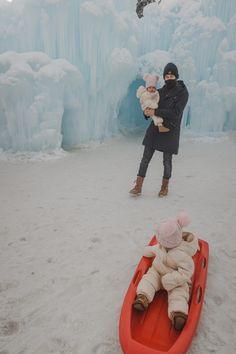
Snow Day Theme
Activities for Younger Students:
100 Snowballs Game on ABCya
Make a Snowman Game on ABCya
Snoring (Winter Edition) Game on ABCya
The Ruff Ruffman Show Fish Force Game on PBS Kids
Sid the Science Kid Snowflake Match Game on PBS Kids
Sid the Science Kid Snow Search Game on PBS Kids
Winter Games on Disney LOL
Sneezy the Snowman book read-aloud on YouTube
Snowman Magic book read-aloud on YouTube
At Home With Olaf video clips on YouTube
That’s Silly Winter Scene by Highlights - works great as a green screen background
Green Screen Activities: Change yourvirtual background to a snowy day scene.
1) Print/cut pictures of snowman components (ex: three snowballs of different sizes, a carrot, pieces of coal, scarf, etc.) Have the student sequence steps to build a snowman and request each component. Stick pictures onto the green screen to assemble the snowman. For more opportunities to request, describe, and compare/contrast, print multiple options for clothing items (ex: scarves that are different colors, carrots that are different sizes).
2) Pretend to dig in the snow using a real shovel that you have at home. Describe items for the student to name and then pull them out of the snow magically using a green tube or pocket. These can be pictures of winter items, pictures of arctic words, or actual household objects.
Activities for Older Students:
Winter MadLib Online (Funny Fill-In) on Nat Geo Kids
Snow Sculptures Gallery on Nat Geo Kids - great for describing, comparing/contrasting, formulating sentences about a picture given target words
Snow-Themed Articles on Nat Geo Kids
Snow Jokes by Fun Kids Jokes - great for explaining multiple meanings, sound-alike words, and word relationships
Which Winter Activity Should You Do? Personality Quiz by Beano
Winter Themed Mini Unit by The Speech Express - address all goals included reading comprehension, context clues, inferencing, articulation
4th of July or Patriotic Theme
Activities for Younger Students:
Daniel Tiger Daniel’s First Fireworks book read-aloud on YouTube
Daniel Tiger First Time for Fireworks video on PBSKids
Fourth of July Mice book read-aloud on YouTube
The Night Before the 4th of July book read-aloud on YouTube
How to Make a Cherry Pie and See the USA book read-aloud on YouTube
July 4th History for Kids video on YouTube
Fireworks Song - can be used as a warm-up with preschoolers
4th of July Coloring Pages on Hello Kids
Virtual 4th of July Parade on YouTube
Free 4th of July Picture Scene Boom Card Game - use to work on prepositions, direction-following, vocab, describing, and more
Free 4th of July Bingo Boards - use for naming to description, cross off items as they’re named
Free 4th of July Facts Boom Cards by SpedEdLove - great for basic listening comprehension/recall
Green Screen Activities:
1) Use avirtual background (click for 200+ free backgrounds) of the night sky and print/cut pictures of fireworks that are different sizes/colors. Whenever the student answers a question, says their target sound, describes a picture, etc., add a firework to your green screen so that it appears in the sky! Use the fireworks themselves to work on making choices (ex: between two types), describing, comparing/contrasting, or location concepts. You can find a free sound clip of a firework exploding to play as you add each firework to make the activity even more realistic!
2) Use avirtual background of a backyard barbecue with an open grill. Print/cut pictures of barbecue food items to “cook” on the grill. Use food items to work on describing, talking about food likes/dislikes, comparing/contrasting, or categorizing into barbecue / non-barbecue foods.
Activities for Older Students:
4th of July Jokes on imom.com - great for explaining multiple meanings, sound-alike words, and word relationships
The 4th of July Facts by Kids Konnect
7 Myths About the 4th of July on beliefnet
History of the 4th of July Article on History.com
4th of July Crossword Puzzle on allfreeprintable.com
4th of July Photos on Pixabay - use for describing, comparing/contrasting, formulating a sentence given a target word
What is Your 4th of July Anthem Personality Quiz on Playbuzz (song plays at the end!)
U.S. President Personality Quiz on Nat Geo Kids
Bug Theme
Activities for Younger Students:
Curious George Bug Catcher Game on PBS Kids
Good Luck Charlie Bugs Be Gone Game on Disney LOL
How to Make a Bouncy Butterfly (Craft) video on ABCya - great for retelling steps in the procedure, describing supplies
Bug Games on Pest World for Kids - check out Bug Builder and Sort the Bugs
Plant Monster PowerPoint Game by Spiffy Speech - includes a variety of language visuals and activities
Bug Hunt book read-aloud on YouTube
Heads and Tails Insects book read-aloud on YouTube - great for naming bugs from a description
The Bugliest Bug book read-aloud on YouTube - loaded with tier two vocab!
Green Screen Activities:
1) Change yourvirtual background to a picture of a flower garden. Print/cut pictures of bugs that have various sizes, colors, and attributes. Stick bugs all over your green screen and use a real net to “catch” the bugs. Have the student request bugs for you to catch, name bugs that you describe, describe the bug you catch, or compare/contrast two bugs. SLP bonus points if you pretend to scream and run away from the bee! 2) Change your virtual background to a picture of a garden with dirt. Use a real shovel and pretend to dig in the dirt for the bugs.
Activities for Older Students:
Pest Detective Game on Pest World for Kids - great for reading comprehension, critical thinking
Pest Rangers Game on Pest World for Kids
Wacky Weekend Bizarre Bugs on Nat Geo Kids - great for describing, comparing/contrasting, writing captions
Experts Answer 20 Common Questions About Bugs on Scholastic
Bug, Spider, Insect Jokes and Riddles on Enchanted Learning - great for explaining multiple meanings, sound-alike words, and word relationships
Yummy Bugs on Science News for Students - reading comprehension
Pizza Theme
Activities for Younger Students:
Make a Pizza Game on ABCya - great for turn-taking, describing, requesting, direction following
Peg and Cat Pizza Place Game on PBS Kids - great for direction-following, describing, quanitity concepts
Pete the Cat and the Perfect Pizza Party book read-aloud on YouTube
Secret Pizza Party book read-aloud on YouTube
Curious George and the Pizza Party book read-aloud on YouTube
Cooking with Pixar Forky’s Pizza Planet Pizza video on Disney LOL - great for retelling steps in a procedure, describing actions
Green Screen Activity: Change yourvirtual background to a pizza parlor scene that has a large crust. Print/cut a picture of sauce, cheese, and various toppings. Have the student sequence steps to make a pizza and request each ingredient. Add ingredients to the pizza by sticking them onto your green screen.
Activities for Older Students:
Crazy Pizzas Around the World - great for vocabulary, paraphrasing, expressions/idioms
Pizza Party MadLibs Online by Glow Word Books
Alan’s Pizzeria Game on ABCya - great for sequencing steps in procedures
What Your Favorite Pizza Topping Says About Your Personality on Little Things
Pizza Jokes on Pug Jokes - great for explaining multiple meanings, sound-alike words, and word relationships
36 Amazing Facts You Didn’t Know About Pizza by Deniro’s Pizza
Sweet Treats Theme
Activities for Younger Students:
Make a Cake Game on ABCya
Make a Cupcake Game on ABCya
Make an Ice Cream Game on ABCya
Cookie Friend Game on Disney LOL
The Ruff Ruffman Show Ruff’s Cookie Creator Game on PBS Kids
Cookie Monster Games on PBS Kids
Free Create Your Own Ice Cream Boom Cards by Teacher Kimmy
Daniel Tiger O Drops His Ice Cream video on PBS Kids
Arthur An Ice Cream Experiment video on PBS Kids
Splat the Cat Scream for Ice Cream book read-aloud on YouTube
Groovy Joe Ice Cream and Dinosaurs book read-aloud on YouTube
Curious George Goes to an Ice Cream Shop book read-aloud on YouTube
Monster Bake Shop Boom Cards andMonster Sundae Shop Boom Cards by Speech Safari for direction-following, describing with attributes
How to Make Ice Cream video on YouTube
Green Screen Activity: Change yourvirtual background to a candy world or ice cream parlor scene. Print/cut pictures of cones, bowls, spoons, various ice cream scoops, and toppings such as m&ms, fudge, or a cherry. Have the student request each component to describe their desired ice cream as you stick each piece onto your green screen to assemble it.
Activities for Older Students:
Virtual Tour - Ben & Jerry’s Factory on YouTube
Nouns and Verbs Ice Cream Game on ABCya
Ice Cream Personality Quiz on Nat Geo Kids
11 Fun Facts About Ice Cream You Probably Didn’t Know on Stanpac - reading comprehension
Dessert Jokes on Jokes4Us - great for explaining multiple meanings, sound-alike words, and word relationships
33 Easy Dessert Recipes (photo slideshow) on Delish - use photos for describing, formulating sentences given a target word, comparing/contrasting, and use recipes for retelling steps in a sequence
Chocolate MadLib Online by Glow Word Books$50-$100
PLAY PERKS REWARDS
Toy Guides
Explorative Play
Let’s Go Exploring
Exploratory play is a type of play that allows children to learn about their environment through their senses. It's the first type of play that babies and toddlers engage in.
Children learn about themselves and their world through sensory awareness of their surroundings. Sensory exploratory play involves action, movement, texture, color, sound, vision, fine and gross motor skills. Through play, a child explores their environment, discovers, examines, and learns.
Basic exploratory play includes use of balls, sand, water, toys of all kinds, age appropriate playground equipment, tricycles, scooter boards, finger paints, bubble play, empty boxes, musical toys, and so on.
Exploratory play helps children learn body awareness, fine and gross coordination, early cognitive processing and learning, and develop feelings of self confidence through learning new skills during play with new experiences and opportunities.
Some examples of exploratory play activities include:
Sensory bins: These open-ended play areas can be filled with a base material like pasta or rice, along with toys and tools for fine motor skills.
Container play: This activity encourages children to try new things with familiar objects and toys.
Nature walks: Take children on a scavenger hunt to find different textures, such as rough, smooth, hard, soft, or spiky.
Playing with water: Children can play at a water table, in the sink, tub, or play pool.
Playing with sand: Children can play at a sand table or in a sandbox.
Playing with bubbles: Children can blow, chase, poke, kick, or stomp on bubbles.
Playing with toys: Children can play with musical toys, mobiles, or toys they can grip, touch, and suck.
Playing with large boxes: Children can pretend that large empty boxes are forts, stores, cars, or pirate ships.
Playing with playdough: Children can play with playdough.
Playing with mud: Children can make mud pies with paper bowls or aluminum pie pans.
Explorative Play | NHS GGC
Exploratory play involves the child using all their Senses. They will examine objects by looking, touching (with hands and mouths)
Exploratory Play | Launch Your Child's Exploration!
It means to search, discover, and learn more about something. Exploratory activities are a way to immerse your child in…
Children learn about themselves and their world through sensory awareness of their surroundings. Sensory exploratory play involves action, movement, texture, color, sound, vision, fine and gross motor skills. Through play, a child explores their environment, discovers, examines, and learns.
Basic exploratory play may include the use of balls, sand, water, toys of all kinds, age appropriate playground equipment, tricycles, scooter boards, finger paints, bubble play, empty boxes, musical toys, and so on.
Exploratory play helps children learn body awareness, fine and gross coordination, early cognitive processing and learning, and develop feelings of self confidence through learning new skills during play with new experiences and opportunities.
As with any sensory activity, never force a child to participate. You may need to present an activity numerous times before they will interact, accept, or tolerate the item or activity. Continue to offer the experiences and activities giving the child some control as to whether or not they will participate. For some children, just being next to and looking at certain items is a start.
If your child withdraws or becomes overwhelmed with any of the activities or media presented, move on to something else! Your child may only tolerate one or a few of the ideas suggested – remember it’s trial and error and giving your child some control over what they will work with will help in preventing sensory overload.
Some exploratory play activities you may choose to do with your child include:
Toss and catch balls of different sizes
Play at a sand table or in a sand box
Play at a water table, in the sink, tub, or play pool
Push toys
Pull toys
Laying on a scooter board (on their stomach or back) and “cruising” around the room
Riding a tricycle
Riding in a “kid car” that involves pedaling
Playing with finger paints
Playing with bubbles inside and outside (blowing, chasing, poking, kicking, stomping on)
Playing with large empty boxes (let them pretend they are forts, stores, a car, a pirate ship, etc)
Playing with musical toys
Sensory slime activities
SeeSensory Blogs here at TheraPlay4Kids.com
Pots and pans with utensils for playing with, banging on, stacking, etc
Make mud pies with paper bowls or aluminum pie pans
Backyard seek and find activities and/or scavenger hunt (for colors, shapes, items, bugs, etc)
Give your child variety and new experiences for continued learning
The next stage occurs when children understand that they can influence their surroundings through their actions and that not every behavior defines their core personality. This critical moment is known as exploration.
Exploration is one of the primary triggers of critical thinking. Exploration activities provide valuable experiences, help children discover the world, and shape their conceptual understanding of reality. They also significantly contribute to the dynamic development of critical thinking in their world.
Children are natural scientists. They are curious, love to explore, and ask a lot of questions. But you don’t have to have all the answers! Help your child develop the skills needed to think like a scientist, which will allow him or her to understand increasingly complex science concepts. Here are some ways to do that:
Model your own curiosity. Wonder out loud by saying things like, “I wonder what would happen if . . .” or “I am curious about . . . .”
Listen carefully to what your child is saying and encourage your child to explain why he or she thinks a certain way by asking questions such as, “Why do you think the snail is eating that leaf?” “What other animals eat leaves?”
Don’t immediately correct your child if he or she says something that is scientifically incorrect. For example, if your child says, “Only birds can fly,” you can ask, “What does a bird have that helps it fly?” Then ask, “What other animals or things have wings?” Guide your child to name some animals and objects with wings, such as “bees and airplanes.” Then ask, “Can they fly?”
Encourage your child to make observations and then to record those observations, by writing, drawing a picture, taking a photograph, or making an audio or video recording. They can even act out what they saw happen. Give your child a special notebook for recording these observations, and ask him or her to tell you about them.
Engage your child in simple investigations, such as rolling different balls down a ramp to see which one goes farthest. Before you begin an investigation, encourage your child to predict what will happen. Afterward, talk about the results.
Encourage your child to compare and contrast things they see in the world around them, for example, “How are these two trees the same, and how are they different?”
High-quality educational media can be a catalyst for real-world exploration. For example, if you and your child watch a video about how a roller coaster works, say, “Let’s build our own roller coaster!” Then gather simple materials such as paper towel tubes, construction paper, and blocks to build a coaster for a toy car or marble.
Through exploration, children learn to move beyond observed patterns and established experiences. Thanks to exploration activities, they begin to consider alternative scenarios and introduce new modalities into their understanding of the world. They push boundaries, learn how their surroundings react to their actions, and develop the ability to identify the conceptual scope of their language. If you want to encourage critical thinking in your preschool, you should provide ample opportunities for unrestricted exploration in a safe, supportive environment with your patient guidance and participation.
Why Open-Ended Materials Are Key for Independent Play
The educational process, which for children primarily takes place through play, should be structured with maximum flexibility, openness, and the use of open-ended materials. These materials allow children to freely experiment, experience, analyze, and understand phenomena while expressing them in ways that feel appropriate for their developmental stage. Nothing hinders learning more than rigidly structured play or education. The more closed and pre-organized play is, the less control children have over its fluidity. However, it is within independent play that children truly engage with concepts and experience genuine learning.
If you want to provide children with the freedom to grow intellectually and socially, supporting independent play through the use of open-ended materials is essential. These materials empower children to create freely, without imposing restrictive boundaries.
With open-ended materials, the child decides how to use them and in what context. The material does not dictate its function—the child does. The essence of creativity lies in viewing objects or tools with a broad perspective, adapting them to current needs. If we teach children to use specific tools or materials in a narrowly defined, highly structured manner, we significantly limit their opportunities for creativity and critical thinking.
It is also important to remember that mess is a natural part of the creative process. Activities that appear chaotic at first glance are often crucial elements of intellectual development.
Top Exploration Activities
Once children develop an intuitive understanding that stepping beyond conventional patterns and structures can yield valuable benefits—such as discovering new, better solutions—they become motivated to experiment. As they grow comfortable with the flexible nature of exploration and, with parental guidance, learn where critical boundaries lie, any activity can serve as a powerful catalyst for exploration activities.
Building with Blocks
One of the most accessible and universal exploration activities that also strengthens critical thinking is playing with modular toys, commonly referred to as blocks. Every activity involving these materials offers tremendous benefits. Some blocks may be more open-ended than others, but all of them encourage children to use their imagination and translate their ideas into reality.
It is magical to watch children invent new constructions, often practical, or create objects they have never seen before. This activity is a treasure trove of critical thinking in preschool and exploration activities.
Nature Exploration
The complexity and diversity of nature make it the best teacher of critical thinking for children. Nature is a blend of contradictions, often difficult even for adults to comprehend. Yet, within its structured chaos, children intuitively grasp its principles. In today’s world, which is highly structured by human intervention, nature provides an essential openness. It teaches that where there is a need, there is a solution and that structures are, in fact, fluid mechanisms.
Creative Art
We tend to define art as any activity involving materials that allow for self-expression. This kind of activity does not impose a fixed interpretation. In creative exploration activities, children learn to look inward, explore their understanding, and challenge rigid concepts of the modern world. Using as many open-ended materials as possible—building, constructing, painting, drawing, gluing, molding—enhances creativity. Such materials allow even younger children, who may struggle with fine motor skills, to express themselves without limitations.
Using Play Prompts to Foster Creativity in Toddlers
Role-Playing and Reenacting Everyday Play Scenes
This is not only a way to develop social skills but also a means to understand how children interpret different situations. In play prompts that involve role-playing and reenacting, children grasp the essence of certain interactions and learn to introduce flexibility into them, benefiting their development on multiple levels.
Playing with Musical Instruments
Exploring sounds on their own terms, feeling the music, and understanding its language are just a few of the benefits of allowing children to freely engage with musical instruments. Using this play prompt, try guessing which sounds are happy or sad. Experiment with different objects around the house—filled bowls, empty containers—and even hold a kitchen utensil concert!
Thematic Projects
Thematic projects are a goldmine of exploration activities and opportunities to develop critical thinking. All you need is a theme, and the possibilities are endless. Is your preschooler fascinated by dinosaurs? Create a dinosaur world—read, draw, sing, and act as dinosaurs. Organize a dinosaur sound concert, search for fossils, or even hatch a dinosaur from an ice egg! If your child is particularly interested in a topic, embrace it—sensitive periods are key learning moments and perfect opportunities for exploratory play.
Unconventional Everyday Activities
To offer valuable play prompts, use what is readily available around you and introduce everyday activities in an unexpected way. Even routine household tasks can become engaging learning experiences. Cooking dinner? Sprinkle some flour on a tray and show your child how to draw patterns or write letters. Provide bowls for pouring and transferring liquids. Our surroundings are filled with potential play and learning materials, and even daily routines can be transformed into countless opportunities for exploration and fun.
Infants and toddlers use creativity in every part of their lives — whether they're finding new things to do with familiar objects, making up novel sounds and words, or using their imagination in make-believe play. Creativity is the driving force!
Recognizing "teaching moments" with toddlers means noticing natural situations or questions that arise during everyday activities where you can introduce new concepts, vocabulary, or skills, often sparked by the child's own curiosity and interest, allowing you to capitalize on the moment for learning.
Curious about the power of teachable moments and seeking real-life examples? Join me, an experienced Montessori elementary teacher, in exploring these spontaneous opportunities for impactful learning.
“By being alert and interactive in these moments, we can teach unplanned but important lessons.”
Key signs of a teachable moment with a toddler:
Asking questions:
When a toddler asks "why" or "what is that," it's a clear indication they want to know more and are open to learning.Showing curiosity:
Observing a toddler intently looking at something new, touching objects, or exploring their environment can be a teachable moment.Imitation:
When a toddler copies your actions, like pretending to sweep or talk on the phone, it's a great opportunity to reinforce vocabulary and behaviors.Natural occurrences:
Everyday situations like bath time, mealtime, dressing up, or going outside can be used to teach about colors, shapes, numbers, or body parts.Play-based learning:
During play, whether with toys or everyday objects, you can introduce new concepts or practice skills like sorting, matching, or following directions.
Examples of teachable moments with toddlers:
During bath time:
Pointing to different body parts while washing them, saying "This is your nose," or "Let's wash your toes."Reading a book:
Pausing at pictures to ask questions about what's happening, naming animals or objects, or describing colorsAt the park:
Discussing the different types of swings, slides, or climbing structures, explaining concepts like "up" and "down"Playing with blocks:
Teaching basic shapes by asking "Can you find the square block?" or "Let's build a tower with the rectangular blocks."Mealtime:
Introducing new food names, talking about different textures, or asking the child to identify colors of vegetables
How to maximize teachable moments:
Be present and observant:
Pay attention to your toddler's cues and interests to identify potential learning opportunities.Use simple language:
Explain concepts in clear, short phrases that are easy for a toddler to understand.Ask open-ended questions:
Encourage conversation by asking questions that require more than a "yes" or "no" answerMake it fun and engaging:
Use playful tones, gestures, and songs to make learning enjoyableRepeat and reinforce:
Consistently use new vocabulary and concepts throughout the day to help with learning retention
What is an invitation to play?
An invitation to play is simply a collection of resources/materials set up together in an inviting way which helps to encourage children to explore the resources that are offered to them and learn through play.
The process of laying out an invitation allows children to be creative and the play that comes from it is not directed by an adult but instead child led.
Try to think of an invitation as a prompt for children to play in a different way that they may not have tried before. They can use their imagination to extend on the invitation however they please.
There is no right or wrong way for the child to engage with the materials offered and they are an easy, simple way to get children playing creatively and independently.
Where should I set it up?
They are best set up at a table at your child’s height or on the floor depending on the size of the resources and how you think they might use them.
Invitations are a great way to get children to play with resources that they may not have taken off their shelf in a while!
What can I create an invitation to play with?
You can offer an invitation to your child with anything you already own using existing resources, recycled or bought. I find that open ended toys and loose parts always seem to lead to the most play with my kids!
If you would like to read more about open ended play have a read of another one of my blogs, ‘Engaging in Open Ended Play.’
Where do I start?
Now the most daunting part is getting started and worrying if you’ve done it right but I’ll tell you that it's not hard!
Start by observing your children and creating an invitation around their interests. For example, if your child is enjoying pushing vehicles around the house a great invitation would be laying out something to push the cars on such as Waytoplay roads, Building Boards or Connetix. Place the cars in a basket beside them or join just a few pieces together and put a car on top.
If you need a bit more help in observing your child’s play, have a read of another blog, ‘Schemas, how to spot and support them.’
When creating an invitation remember these tips!
Observe your child’s interests and extend on them
Gather resources from around your home (toys and household items)
Keep it simple
Leave room for your child's imagination
Place resources together at your child’s level
Creating an Invitation to Play & Explore
Start by selecting a few resources that work well together or by taking an activity apart such as a puzzle. Take all the pieces out of the puzzle and put them in a basket or wrap the pieces up to make the activity a bit harder.
Take the resources off the shelf and put them on a low table or on the floor together.
Let your children play with the invitation however they would like, try not to tell them what to do or how to do it and let them enjoy the resources by exploring and using them however they please!
I try not to tell my children what to do or how it could be used unless they ask me. I try to get them to lead them and get them to use their own imagination and curiosity.
Some children need a bit of help when engaging in invitations to play and open-ended play at first and they may want or need you to give them some ideas or guidance and that’s okay! Sit with them and play beside or with them to try and encourage some different ways to play.
If they do ask for some ideas I would say "Could these be flowers in a garden? Maybe you could line them all up? Have a play and let’s see what you can create!" Another great way is to prompt them to say “I’m trying to make the sea, can you find me some water?” They are then more likely to use their imagination to find a solution.
As children become more experienced with open ended play you may find that they will start to combine their play with other resources around them past the invitation and extend the time that they are playing.
Another approach to an Invitation to Play is just putting a game out in a different location than it normally would be and setting it up to get children started and interested. See below an example of that with a family favourite, Buildzi.
How long should it take to set up?
The simplest invitations always lead to the most play as they leave a lot of room for the child's imagination. Mine usually take under a minute to set up and any play that is enjoyed past the set up time is a winner!
Depending on the age of your child their attention span will vary but on average a child will engage in an activity for 2-4 minutes for each year of their age. For example a 2 year old would be 4-8 minutes.
Of course every child is different and some may play for longer or shorter.
How often should I create an invitation to play?
I first began creating invitations when my eldest was about 9/10 months old with simple items such as a posting box or bowls to transfer objects between.
Have a look at the blogDiscovery Baskets - What, When, How and Why for more ideas.
I used them most when my eldest was about 18 months old when I was heavily pregnant with my second. This was great for her to learn how to engage in them before the birth of her sister and then I used them when I was breastfeeding or busy settling the baby!
At this stage I would use them about 3 times a day but as she grew older and was more patient with me and her sister I didn’t need them as much. I would often still create one in the morning for her to wake up to which always bought me a bit of time to get myself and the baby dressed before we got on with the day.
You can also use invitations to assist children in building their independent play to engage them at an activity whilst you step away for a few minutes to cook dinner or do the dishes. I should stress that an invitation to play should never be something you make a child do, it is still their choice as to whether they engage with it or not.
Invitation to match an object to letter by sounding.
Different ways to use LEGO blocks
Untraditional ways to explore these popular toys!
7 ways to play with food
The goal of these activities is to explore the sensory characteristics of food.
10 ways to enjoy your yard
Now that flowers and gardens are planted and the grass is green, it's finally time to relax and enjoy your yard.
10 ways to play with toy cars
Activities that go beyond simply rolling cars around on the floor.
5 ways to use clothespins daily
Great ideas for exercising little fingers and creating tools.
10 things to do with cotton balls
For a special indoor physical activity, pour the contents of two ...
10 ways to play with felt
Bouquets galore soft puzzles, setting the table, young jewelry designers, fun tic-tac-toe, colorful, shape-filled pockets, my star-filled sky, fun emojis, sewing projects and more?
10 ways to use paper plates
Indoor Frisbees, targets, homemade twister, emoticons, steering wheels, ready-to-eat meals, castanets, cardboard necklaces, giant wreath, memory game.
10 ways to use drinking straws
Colorful hair, raised letters, enclosures, fences, and roads, pickup straws, fine paintbrushes, utensil challenge improvised necklace beads?
10 ways to reuse tissue boxes
Games, crafts, and activities that will keep tissue boxes out of your recycling bin.
Different ways to explore an apple orchard
Ideas that go above and beyond apple picking.
10 ways to use disposable drinking glasses
colorful patterns, simplified dice rolling, cardboard constructions, tiny plantations, paint distributors, color recognition, simple bracelets, fist puppets, miniature homes, three-dimensional memory
Nine Ways Babies Can Put Laundry Baskets To Good Use
Has it ever crossed your mind that laundry baskets have endless possibilities to amuse babies and toddlers?
Balls
Great ways to use these classic toys.
10 ways to play with toy cars
Activities that go beyond simply rolling cars around on the floor.
Abracadabra! Winter is gone!
Make getting dressed for the last cold days of the year easier!...
Activities involving water games
For most children, water games are fun! When warm weather and s...
Activities that don't require material
A day spent in daycare is one filled with many routines and trans...
Activity planning
For several years now, we have disliked being called "babysitters...
An alternative to black chalkboards
I have found an alternative to black chalkboards and large sheets...
Outdoor Play
Often, daycare workers experience difficulties during outdoor play. Many of us don't really know what to do. We group together with other daycare workers, talk, and manage conflicts…
Making room for active play
Learn just how active children should be.
Making time for free play
Learn how and why you need to include it in your schedule.
Simple edible play dough
A toddler friendly recipe with simple ingredients.
Summer is made for outdoor play
Summer, with all its warm weather, sunshine, and fresh air, is ideal for outdoor play. After all, it's often quite difficult to keep little ones inside during this time of the year.
Outdoor play structures are summer essentials
Learn how to use them for structured play and gross motor skills development.
Exploring red
Activities for toddlers and babies. To present the theme to your group, simply pour a small amount of red poster paint inside empty plastic bottles.
Exploring green
As the leaves and grass turn green again, enjoy this theme with little ones.
Exploring squares
Fun ideas for exploring this four-sided shape with young children.
Exploring white
Activities for toddlers and babies. A week's worth of white items to explore with your group.
Exploring orange
Activities for toddlers and babies. Hang orange balloons in a specific area within your daycare (see cognitive activity). Display Jello-O paintings on your wall (see arts & crafts).
Exploring fabrics
Activities for toddlers and babies.This theme provides activities involving scarves, blankets, and pieces of fabric.
Exploring Christmas
Activities for toddlers and babies. Since Christmas will soon be here, this theme will help you prepare and make the weeks leading up to Christmas extra special for little ones.
Exploring eggs
Activities for babies and toddlers. For these activities, you will need several plastic Easter eggs that can be opened.
Exploring snow
Here are several ideas that will provide little ones with the opportunity to explore snow for the very first time or rediscover it all over again in a variety of different ways.
Exploring construction games
Homemade construction games to discover and enjoy.
Exploring nature and the outdoors...
Activities for toddlers and babies. Help children develop their sense of touch by discovering nature and the outdoors.
Exploring with Mr. Potato Head
New ideas for this classic toy.
Exploring objects with different senses
Simple ideas to play with children’s senses.
Exploring hula hoops
Purchasing a few hula hoops can lead to interesting exploration activities with young children. Hula hoops are simple toys that can be used in a variety of different ways.
Exploring mirrors with babies and toddlers
Activities that will help develop children’s self-awareness.
Exploring Old MacDonald had a farm with babies and toddlers
Bring this popular song to life in your nursery.
Create your own sensory book
A touch and feel activity with endless possibilities.
Paper and cardboard
Tearing, crumpling, and drawing for creativity and dexterity.
In the heart of spring
Activities for toddlers and babies.This theme will make exploring all these interesting elements with little ones possible.
Using play mats and rugs in your play areas
Beyond being colorful and decorative, mats and rugs can be useful.
Playing outside during autumn
During summer months, getting outdoors is quick and easy.
Playing with watermelons
Watermelons are attractive for little ones who are drawn to their bright color, their texture, and their taste! Have fun transforming watermelons with your group.
Giant playing card
A unique Valentine’s Day project.
Playing with pumpkins and squash with little ones
You can keep autumn activities going strong until the first snow!
Playing to improve concentration
10 activities that will help children focus.
Playing with pictures of dads
Simple activities that are perfect for Father’s Day!
Outdoor Play
Often, daycare workers experience difficulties during outdoor play. Many of us don't really know what to do. We group together with other daycare workers, talk, and manage conflicts...
Outdoor play structures are summer essentials
Learn how to use them for structured play and gross motor skills development.
Magnets
We all know little ones love playing with magnets. They enjoy placing them in the fridge and rearranging them over and over again. Why not vary the surfaces on which they play with magnets?
Richie-o’-lantern sensory balls
Add these little pumpkins to your calm down bag!
Swimming pool noodles and balloons
While holding a swimming pool noodle in my hands, I realized that it represented an object that can be explored with children.
Sandboxes are very popular during summer months. Children are naturally drawn to sandboxes where they can build roads, play with their friends, or just relax.
Activities for toddlers and babies. Subtly introduce two concepts that are new for little ones by exploring heavy objects and light objects.
Vehicles
Collect all the toys you may have which roll and use them in different ways... Try to find a few good board books about vehicles and transportation. There are several books about cars...
Discover how to turn sedentary activities into active play.
Activities for toddlers and babies. This theme will show your group different ways to be active.
What animals eat
Little ones get to play with food as they learn.
Exploring hula hoops
Purchasing a few hula hoops can lead to interesting exploration activities with young children. Hula hoops are simple toys that can be used in a variety of different ways
Make giant beads out of swimming pool noodles
I recently visited Isabelle?s daycare to test a colorful activity that is perfect for younger children, but sure to please older children too.
The science corner during spring
Spring sets the stage for a multitude of discoveries. Snow is melting away and items that were buried under a white blanket for months are beginning to peek through.
20 secrets about children's self-esteem
Great ways to foster self-esteem daily.
How to play with balls during winter
Encourage young children to move despite the cold.
3 ways to use snow to explore letters, numbers, and shapes.
Water games
Activities for toddlers and babies. Water is an element that babies and toddlers enjoy exploring!
Fun with tiny clay pots
I love dollar stores. I visit my local store almost every week. I love walking up and down aisle after aisle. Sometimes, I make interesting discoveries.
1 box, 10 objects, 20 activities
Never a dull moment with this pre-k activity box....
10 activities involving magazines
Packed with colors, letters, and pictures…magazines are worth rec...
10 activities involving spray bottles
Beyond cooling children off, these ideas will strengthen their ha...
10 surprise bags for the car
Make driving around town fun and educational!...
10 things to do with berry containers
If you are like me, you purchase several berry containers every w...
10 things to do with bread ties
Letters and numbers. Glue several bread ties together to represen...
10 things to do with empty cereal boxes
Three-dimensional frames, downtown, challenge box,finger paint su...
10 things to do with empty toilet paper rolls
Paint several empty toilet paper rolls and set them aside to dry....
10 things to do with envelopes
An enveloped neighborhood. Glue open envelopes along the bottom ...
10 things to do with store flyers
10 things to do with store flyers...
10 ways to play with toy cars
Activities that go beyond simply rolling cars around on the floor...
10 ways to use disposable drinking glasses
Colorful patterns, simplified dice rolling, cardboard construction...
2 somewhat different homemade association games
These games require very little material and they’re great for me...
20 sandbox activities
Sandy baking, sandcastle contest, treasure hunt, roads galore, ri...
25 ideas for learning to read
Tiny guide, cut words, recorded picture books, word sticks, traci...
25 things you can do with cardboard boxes
Inexpensive blocks. Collect several cardboard boxes of different ...
25 things you can do with muffin tins
Paint distributor, colorful snacks, sandy cupcakes, magnetic att...
Encouraging independence
Activities for toddlers and babies.Use your daily games, activiti...
End of summer cleaning
Prepare for September with help from your group....
Exercise balls and cylinder cushions
Since exercise balls are gaining in popularity in gyms everywhere...
Exploring Christmas
Activities for toddlers and babies. Since Christmas will soon be ...
Exploring construction games
Homemade construction games to discover and enjoy....
Exploring eggs
Activities for babies and toddlers. For these activities, you wil...
Exploring fabrics
Activities for toddlers and babies.This theme provides activities...
Exploring green
As the leaves and grass turn green again, enjoy this theme with l...
Exploring hula hoops
Purchasing a few hula hoops can lead to interesting exploration a...
Exploring mirrors with babies and toddlers
Activities that will help develop children’s self-awareness....
Exploring nature and the outdoors...
Activities for toddlers and babies. Help children develop their s...
Exploring objects with different senses
Simple ideas to play with children’s senses....
Exploring Old MacDonald had a farm with babies and toddlers
Bring this popular song to life in your nursery....
Exploring orange
Activities for toddlers and babies. Hang orange balloons in a spe...
Exploring red
Activities for toddlers and babies. To present the theme to your ...
Exploring snow
Here are several ideas that will provide little ones with the opp...
Exploring squares
Fun ideas for exploring this four-sided shape with young children...
Exploring white
Activities for toddlers and babies. A week's worth of white items...
Fairies
These tiny visitors come with plenty of magical fun for little on...
Fall
Activities for toddlers and babies. Celebrate the arrival of fall...
Fall colors
The fall foliage is fascinating for young children. Imagine all t...
Fall-related outdoor activities for babies and toddlers
Fun and games involving leaves....
Farm animals
The perfect prelude to your local mall’s Easter farm....
Fiesta
Let's celebrate this week! I have collected several ideas that re...
Flowers
Flower-filled exploration, crafts, and activities for young child...
Flowers
Allowing babies and toddlers to explore flowers can develop their...
Fostering language development with sign language for babies
Discover a great way to communicate with infants....
Opposites - Activities for toddlers and babies
With babies and toddlers, a simple introduction to opposites make...
Out for a walk
Presenting a theme related to taking walks with your group will h...
Outdoor activities-Festival
Activities for toddlers and babies. Now that summer and beautiful...
Outdoor motor skills
Activities for toddlers and babies.Decorate the ceiling.Hang beac...
Outdoor relaxation activities
Outdoor play does not always have to rhyme with gross motor skills...
Paper and cardboard
Tearing, crumpling, and drawing for creativity and dexterity....
Parks and outdoor spaces
Finally! The end of March is approaching which means the snow wil...
Pencils and crayons
Explore pencils and crayons of all kinds with babies and toddlers...
Picnics
Take lunch time outside to enjoy the last days of summer with lit...
Planting seeds
Introduce children to plants with sensory, language, and cognitiv...
Plants
This theme will give little ones the chance to explore the differ...
Playing with pictures of dads
Simple activities that are perfect for Father’s Day!...
Protecting your back when you work in a nursery
Things to consider to avoid back injuries....
Pumpkin fun
Simple pumpkin-themed activities perfectly adapted to little ones...
Pumpkins
Activities for toddlers and babies. Deposit several plastic pumpk...
Puppets
Puppet-filled activities, crafts, and routines designed for young...
Push and pull
Activities for toddlers and babies.Babies and toddlers learn by r...
Pyramid (rolling a ball)
Here is a low-cost game which is very easy to make with little on...
Rain
Activities for toddlers and babies. Hang several small umbrellas ...
Recorded sounds
Music, rhymes, their mother?s voice, and chirping birds will be e...
Red and green
Christmastime is perfect for introducing children to these two fe...
Reinventing recycled items
Activities for toddlers and babies. Use the items in your recycli...
Searching for hidden objects
The road to object permanence....
Senses
A list of activities that encourage exploration....
Shiny New Year
The perfect theme for little ones who love things that glitter an...
Similarities and differences
Introduce children to the concepts “same” and “different”....
Simple imitation games
Children learn simple imitation games at a very young age. They b...
Soap
A ton of bubbles and a whole lot of fun for little ones....
Squirrels
Introduce young children to these highly energetic animals....
Stick and remove
Sticky fun for tiny hands!...
Strawberries
A very sweet theme for infants and toddlers....
Sugar harvest time
A very sweet theme for infants and toddlers....
Summer
Activities for toddlers and babies. Summer is a wonderful season ...
Summer exercises for little legs and feet
Take advantage of the warm weather to explore these body parts!...
Summer reading
Outdoor book exploration for young children....
Summer vacation
This theme explores various activities babies and toddlers may ex...
Summertime creative expression
Simple outdoor arts & crafts for young children....
Table exploration
Different ways to use tables for sensory activities, transitions,...
Taking my home outside
Make routine activities extra special by experiencing them in you...
Teaching children organizational skills
Discover how you can avoid disorganization during daily routines....
Tender loving moments for babies
You know the feeling, the one which tells you that getting to the...
The beach
Fun in the sun for little ones!...
The benefits associated with rocking children
Learn how and why to use your rocking chair and toys....
The color of my food
The color of my food Activities for toddlers and babies.Use this ...
The heroes little ones love
Activities for toddlers and babies. At a very young age, babies a...
The playground
Activities for toddlers and babies. During summer, trips to the p...
Tiny fish
A long list of activities you can use to explore fish with toddle...
Treasure hunt
Develop children’s visual perception with a simple game....
Trees
Activities for toddlers and babies...
Up and down
Several activities to introduce little ones to the concepts “up” ...
Valentine's Day
Hearts, hugs, and kind words for little ones....
Vegetables
Activities for toddlers and babies. Set a basket filled with plas...
Vehicles
Collect all the toys you may have which roll and use them in diff...
Verbal communication
Enrich children’s vocabulary through activities packed with sound...
Water games
Activities for toddlers and babies. Water is an element that babi...
Welcome
This theme will help you prepare for the arrival of new babies an...
What animals eat
Little ones get to play with food as they learn....
What we eat
Activities for toddlers and babies. Help little ones discover the...
When a young child hurts his peers
How to deal with biting, hitting, pushing, and scratching....
When Jell-O becomes an activity...
Jell-O is worth exploring due to its interesting texture, color,...
Why should I choose to work in my daycare’s nursery?
Discover if you have what it takes to work with the youngest grou...
Wind
Activities for toddlers and babies. Since autumn is a windy seaso...
Winter
Interesting activities for the last weeks of winter....
Wintertime hula hoop fun
Encourage active play with these “not just for summer” toys....
Things that fall
Simple ways to explore cause and effect.
Everyone likes to make silly things, this craft will keep creating long after the glue dries. All the pieces have magnets on them so children can put them together however they feel like.
Learn how and why you need to include it in your schedule.
Velcro board for exploration
A homemade tool that fosters fine motor skills and hand-eye coordination.
Sorting, classifying, and throwing away to create a zen daycare environment
Take these steps to benefit from a clutter-free work environment.
Activities during walks
Explore legs and feet as little ones discover your neighborhood.
Friction
Slippery surfaces provide fabulous learning opportunities
Using books to share discoveries and passions
Books and reading represent ideal tools for teaching children all about sharing. Here?s why?
Things you may not know about language development
Read this to find answers to common language-related questions.
Things you will find in my suitcase
There’s a whole lot of learning packed into this theme!
